All Jerome
Hill
Artist
Fellows
2019 Jerome Hill Artist Fellows at a Minnesota gathering.
2019 Fellows


Marjani Forté-Saunders (she/her) is a mother, choreographer, performer, a collaborative artist, community organizer and a three-time Bessie award winning choreographer and performer for her latest work, Memoirs of a... Unicorn. Marjani is an inaugural recipient of the UBW Choreographic Center Fellowship and a two-time Princess Grace Foundation awardee. Her work has been incubated in residencies at the Maggie Allesee National Choreographic Center (MANCC), Lower Manhattan Cultural Council Extended Life Residency, Brooklyn Arts Exchange, CUNY Dance Initiative, 651 Arts and Movement Research. Marjani has produced seven award-winning works in steady collaboration with her partner and composer Everett Asis Saunders (New Music USA Awardee) over the last ten years. Humbly, she defines her work by its lineage stemming from culturally rich, vibrant, historic, loving and irreverent conjurers!
Fellowship Statement
My storytelling is intended to thicken the common narratives of people of the African Diaspora, and stir up visions for human liberation. What might freedom, a reality that elevates culture, look like? I commit to the work of shifting and visioning through art. I dance to tap my heart and my prolific imagination, to ignite vision or desire for ontological integrity and ascension in my audiences. In dance, I can imagine my own liberation and engage a fantasy of free-being as a plausible reality. With Memoirs of a.. Unicorn, developed in collaboration with composer Everett Saunders, I've centered on thoughtfully sharing the work such that it reflects our core values:
- To echo and affirm the work of local community organizers
- To be malleable in design for unconventional spaces and limited resources
- And to explore and affirm the complexity of blackness as a unifying, expansive, cross-cultural concept and network.
Photo by Ian Douglas.
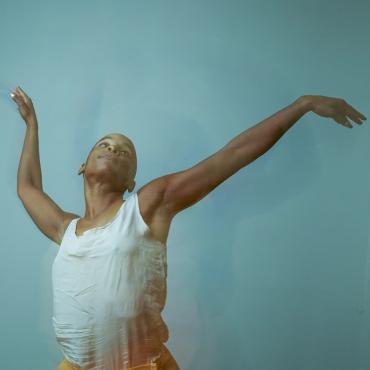

Jasmine Hearn (she/they) is a performer, director, choreographer, organizer, and teaching artist. A native Houstonian, she graduated magna cum laude from Point Park University with her BA in Dance. She currently collaborates with filmmaker and visual artist, Alisha B. Wormsley. Jasmine has worked and performed with David Dorfman Dance, Alesandra Seutin (UK), Solange Knowles, Kate Watson-Wallace, STAYCEE PEARL dance project, Marjani Forté-Saunders, Jenn Meridian, Helen Simoneau Danse, Lovie Olivia, Bill T. Jones/Arnie Zane Company and Nick Mauss (as part of the performance cast of TRANSMISSIONS—an exhibition at the Whitney Museum of American Art).
Jasmine is a 2018/2019 Movement Research artist-in-residence, was a 2018 Dancing While Black fellow, and was awarded a 2017 Bessie Award for Outstanding Performance as a part of Skeleton Architecture. They also received artist residencies at the Bronx Museum of the Arts, Jerome@Camargo Residency in Cassis, France, and Dance Source Houston. Jasmine is a vessel and storyteller using dance and sound as materials to make, teach, and perform around the world.
Fellowship Statement
The body of my work is rooted in the belief, born of language from my work with Marjani Forté-Saunders, Tara Aisha Willis, and Staycee Pearl, that I am a vessel for ancestry and spirt to speak through. I offer work that remembers and honors past, speaks of present, and prepares community for future. As a choreographer, dancer, sound-maker, and performer, I am investigating how the body is able to use memory, sensation, and imagination as ways to enter embodied practices to articulate story, ancestry, and personal truth. I use dance and sound as materials to conjure an environment to be experienced. I ask, “How can the body and voice act as bridges that connect communities with their individual truths and how these truths live together. Working as a freelance artist, I have had many opportunities to engage with community—teaching dance and movement classes, facilitating spaces for movement/sound exploration, performing in multidisciplinary projects, and creating intimate, immersive performance experiences. I am committed to the facilitating environments that gives space for folks to connect with their fantasies and feelings.
Photo courtesy of Whitney Browne Photography.
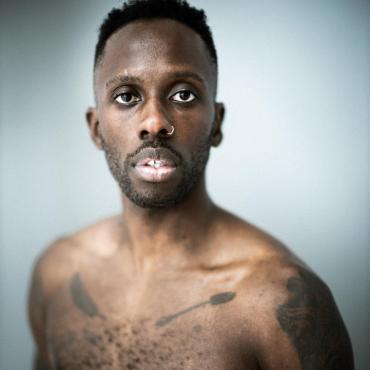

Choreographer/Director Raja Feather Kelly (he/him) is the artistic director of New Brooklyn Theatre. In 2009 he founded the dance-theatre-media company the feath3r theory. The two companies merged in 2018. Raja has been awarded a Breakout Award from the Stage Directors and Choreographers Foundation (2018), Dance Magazine's inaugural Harkness Promise Award (2018), the Solange MacArthur Award for New Choreography (2016), and, twice, the Princess Grace Award (2017, 2018). He was born in Fort Hood, Texas and holds a BA in Dance and English from Connecticut College. Raja has been awarded a New York Dance Performance Bessie Award, a Bessie Schonberg Fellowship at The Yard, a DanceWEB Scholarship, a New York Foundation for the Arts Choreography Fellowship, a HERE Arts Fellowship, a 2018 Creator-in-Residence at Kickstarter and a Choreography Fellowship at the Center for Ballet and the Arts at New York University.
Fellowship Statement
I am obsessed with the development of popular culture over the last thirty years. My work unabashedly appropriates the structures, themes, and aesthetics found in reality television, celebrity culture, and social media (YouTube, Instagram, Facebook), then deconstructs it into new works which combine dance, theatre, and visual media. My aim is to challenge audiences to recognize their own implication in popular media: how media has trained and molded their desires, relationships, and identities. My movement-based performances combine fashion shows, gallery exhibitions, drag, stand-up comedy, minstrel shows, and stage-plays into a single, overwhelming, over-saturated Gesamtkunstwerk in which artists and audiences experience their shared humanity. I rehumanize our over-mediated experience of reality.
Photo by Thomas Dunn.
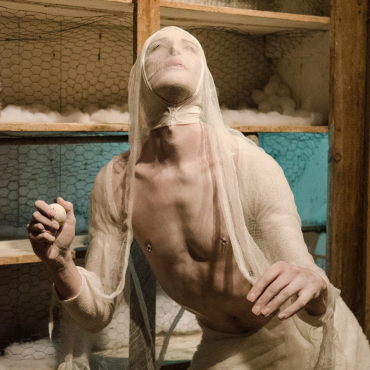

Dustin Maxwell (he/him) is a dancer, choreographer and visual artist originally from Albuquerque, New Mexico, now based in Brooklyn, New York. In New Mexico he trained in Graham and Limon with his dance “mother,” Joanne Emmons. He has a BA in Dance from the University of Minnesota and extensive training in Yoga and Butoh. As a freelance dancer he has worked with Aniccha Arts, Chris Schlichting, Morgan Thorson, and many others. His choreography and performance installations have been shown in galleries, theaters, basements and alleyways in Minnesota, New York and Germany. He was a nominee for the 11th Annual Sage Awards, Outstanding Performer.
Fellowship Statement
I work primarily within the modalities of somatic improvisation and butoh. Being born queer into a Mormon family of eight has shaped my perspective in many ways. Sexuality, spirituality and the experience of otherness are major themes in my work. My choreography is highly visual and minimal in movement relying on the innate history, ancestry, cultural identity and politics inherent in the body. My body is a field for knowing that which is seen and unseen; that which lies beyond the boundaries of the mundane. My artistic endeavors use performance as a method for connecting with others at this essential level and perhaps provoking “awakeness.” I believe this expands the limits of consciousness which is a radical and subversive action.
Photo by Justin Hickman.
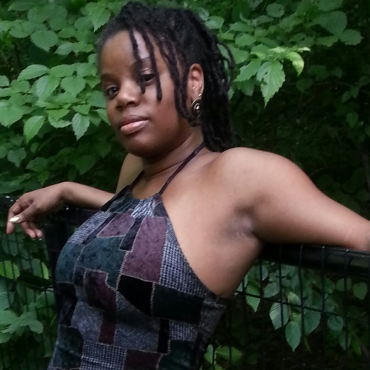

Leslie Parker is a dance artist, performer, director, maker, improviser and educator holding a BFA from Temple University in Choreography and Modern dance technique and a MFA from Hollins University in partnership with the Künstlerhaus Mousonturm, The Frankfurt University of Music and Performing Arts and The Dresden Frankfurt Dance Company in Frankfurt, Germany. Leslie is a 2017 Bessie award winner and a Jerome Hill Foundation Artist Fellow 2019 -2021. She has a rigorous research and practice in dance forms derived of the African Diaspora. She designed “Moving Dialogue for Non-Violence” using dance art as a platform for Broadway Women’s House Shelter in Brooklyn, New York and at The Family Place in Saint Paul, MN. She is currently a member of the collective, Skeleton Architecture based in New York. Her director credits include co-director and choreographer for IHOTB MayDay Tree of Life Ceremony; choreographer for Jimmy & Lorraine: A Musing by Talvin Wilks; and Ping Chong and Talvin Wilks for Collidescope 4.0.
Additional credits include, crystal, smoke n’spirit(s) presented by Momentum: New Dance Works at Frey Theater St. Catherine’s University; Crossroads/Gateways pt 2. at the Walker Art Center’s Choreographer’s evening; Bone Womyn Traces in Black at Hollins University (Roanoke, VA) and at Southern Theatre; Ripen: Forbidden Truth In da Flesh Pt.2 at Pillsbury House Theatre “Mama Laurie’s Late Nite Series”; Center for Performance Research's Fall Movement Series (NY, NY); and New York Live Arts. Parker choreographed an original work, In Search of Colors, as faculty for University Dance Theater (UDT) at U of MN Theatre and Dance dept. Currently, Leslie Parker Dance Project, is in residence for Spring 2021 at Pillsbury House Theater and Pangea World Theater.
Fellowship Statement
I am a dance artist, performer, dance maker, educator and improviser, trained in and experimenting with an aesthetic rooted in the Black experience. I make dances that explore spirituality, identity and social justice to spark questions and conversations with and between people. As an improviser, I invite observers to a real-time exchange through movement, sound, space and the body. Described by choreographer Bill T. Jones as “haunting,” former Director of Quixote Foundation, June Wilson describes the experience of “watching Parker’s work is like being a voyeur; the intimacy and emotional energy of her movement makes you want to look away and yet it’s impossible to stop watching.”
Photo courtesy of Leslie Parker.
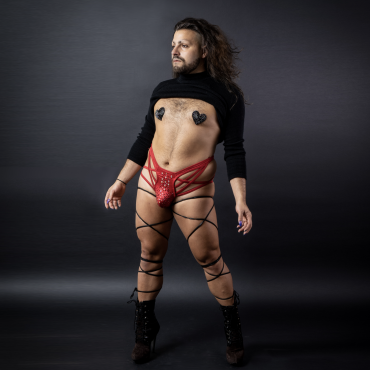

Pedra Pepa (they/them) is a Venezuelan, queer Latinx performance artist, as well as a teaching artist with Pillsbury House Theatre and Upstream Arts. They have performed and produced over ten Drag Story Hours at multiple Twin Cities locations, supported by a Minnesota Center for Humanities grant. Doña Pepa, Pedra’s drag/burlesque persona and choreographic lens, has graced stages locally (First Avenue Mainroom, Minneapolis Burlesque Festival, Lush, Gay 90’s, University of Minnesota) and in Puerto Rico. Noche Bomba, which incorporates Doña Pepa, was presented by 20% Theatre’s Q-STAGE and will tour to Winona State University in April 2019. Solo-versions were performed at Walker Art Center’s Choreographers’ Evening and at Galería Oro in Vieques, Puerto Rico. Pedra’s newest work, Holy Doña, will premiere at Red Eye Theatre’s 2019 New Works 4 Weeks Festival. Initial research for this project has been shared at 1er Coloquio sobre Hombres+ y Masculinidades in San Juan, Puerto Rico.
Fellowship Statement
I am Pedra Pepa. I am a queer, gender-fuck, Venezuelan immigrant, Latinx, brown performance maker in Minneapolis.
My choreographic work is deeply personal, it is about my everyday experience, the coexistence of my oppressions and my identities. I create work that denounces current injustices. The work begins within me, then I transfer it to and cultivate it with other performers. I play with movement expression, singing, sound-making, draglesque, and visual media to create specific imagery, supported by costumes and props. I am interested in facilitating emotional journeys for audiences to ride with me and the performers.
“Draglesque” is my current solo research, a larger-than-life expression/explosion of gender, where my body transcends all social parameters. A space of radical freedom and self-love. This process is how I finesse and craft my skills as I mold my character(s). It is both a celebration and a transgression
Photo by Nic LaFrance.
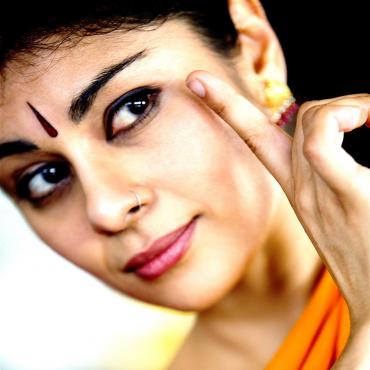

As an independent choreographer and Choreographic Associate with Ragamala Dance Company, Ashwini Ramaswamy’s (she/her) work references ancient myths and ritualistic practices, global literature and poetry, and the mixed media contemporary culture she has absorbed for over 30 years. Her work draws from myriad influences to express a personal identity with universal resonance. Celebrated for her ability to “[weave] together, both fearfully and joyfully, the human and the divine” (New York Times), Ashwini has studied Bharatanatyam since the age of five. She has toured extensively with Ragamala, performing throughout the U.S. and in Russia, Taiwan, Indonesia, Japan, the U.K, and India. Ashwini's choreographic work has been presented by the Cowles Center, the Yard, and the Joyce Theater, among others. Her work is supported by the National Endowment for the Arts, the Jerome Foundation, the Mid Atlantic Arts Foundation’s US Artist International, and the New England Foundation for the Arts’ National Dance Project, among others.
Fellowship Statement
I have spent decades steeped in the south Indian classical dance form of Bharatanatyam. I am committed to maintaining the beauty, technique, rigor, and values embedded in the form as it has been taught to me, while creating my own personal vision of women’s representation in performance. Like a phantom limb, my Indian ancestry lingers within me, informing my artistic work and daily interactions; my upbringing in both India and the U.S. has encouraged an aesthetic perspective with a hybrid internal compass. As an artist of diaspora, I am a cultural carrier with an instinct to move within ancestral patterns. There is a continuum between what we perceive as real/tangible and what we accept as unknown/unknowable; this gravitation between the human, the natural, and the metaphysical—which are forever engaged in sacred movement—is a focal point in my work.
Photo by Ed Bock.
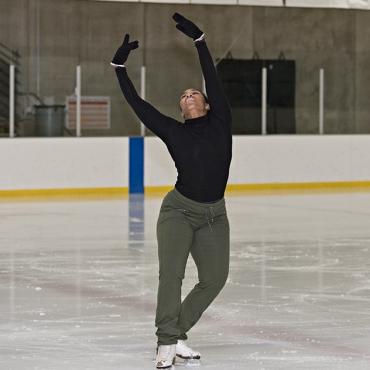

Deneane Richburg (she/her) grew up a competitive figure skater, spending time in spaces where she felt she had to check her racial/cultural identity at the door, as the predominantly white skating world excluded her ancestry’s truths. To quote Zora Neale Hurston, Deneane always felt “most colored when [she was] thrown against a sharp white background.” As an adult, she realized the need to carve out a space for her ancestral history, so she established Brownbody, a creative home for her artistic work that fuses theater, dance, social justice practice, and skating. Through Brownbody, she honors the complex narratives of Black diasporic communities. As a modern dance choreographer and skater, Deneane is interested in expanding creative expression on the ice by engaging ancestral narratives as a framework for movement exploration. Deneane is a grateful recipient of a 2017 McKnight Choreography Fellowship administered by the Cowles Center and funded by The McKnight Foundation.
Fellowship Statement
I fuse different movement worlds; a modern dance choreographer that presents works on and off of the ice. The themes of my work range from visual objectification through the story of Saartjie Baartman to issues of re-memory through a piece based on Toni Morrison’s Beloved. My latest on ice evening length work is Quiet As It’s Kept, which focuses on the Reconstruction era and rise of Jim Crow laws. I’m interested in ensemble work on the ice. As a dancer I’ve performed with companies in ensemble pieces and have learned to appreciate the intricacies and manipulation of group nuances—engaging many bodies to create a fully realized and unified statement. I am interested in exploring the power of these elements on the ice in telling stories relevant to my ancestral history. Currently I am working on an ice ensemble piece that explores American Black social dances of the 17th through 19th centuries.
Photo by Alice Gebura.


Darrius Strong (he/him) is a Twin Cities based choreographer, dancer, and educator whose creative work has been performed in Walker Art Center’s Choreographers Evening and Rhythmically Speaking. He was featured in the 2015 New Griots Festival as well as an American Standard Billboard advertisement in New York City Time Square in 2016. He was a 2017 Momentum New Works recipient. Strong has created works for Threads Dance Project, Flying Foot Forum, Alternative Motion Projects, and most recently was commissioned to create a new work for James Sewell Ballet. Strong developed his own dance company STRONGmovement in 2015. He is a faculty member at Saint Paul Conservatory Performing Arts High School, TU Dance Center. At Eleve Performing Arts Center, he teaches young dancers how to connect their identity to movement. Strong is also a company member of Stuart Pimsler Dance & Theater.
Fellowship Statement
I tell stories through movement. I feel that our bodies tell stories and it’s up to us as individuals to define those stories. As a child it was hard for me to communicate my feelings through words, so I began to rely on movement as an outlet in times of sadness, frustration, anger, and other emotions.
I created my own dance company, STRONGmovement, because I truly believe that movement empowers conversation between dancers and audiences. Conversation invokes community building, an aspect of my background in hip hop I center in my work. Through the movement I create, I desire to empower others, create communities, inspire people to invest in themselves and their stories.
Photo by Bill Cameron.
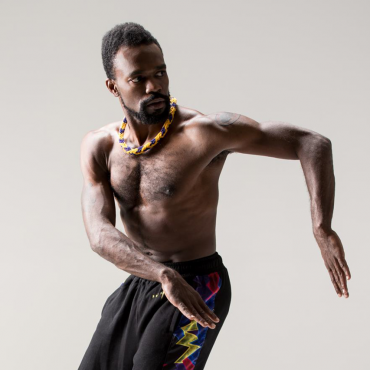

André M. Zachery (he/him) is an interdisciplinary artist and founding artistic director of Brooklyn-based Renegade Performance Group (RPG). Zachery’s practice, research and community engagement artistically focuses on Black/African Diaspora cultural practices through the mediums of choreography, site-specific projects, film, digital projection, audio installations and responsive technology. He is a former Jerome Foundation supported Movement Research artist-in-residence and a 2016 New York Foundation for the Arts Fellowship/Gregory Millard Fellow in Choreography. He has served as a guest faculty artist in dance departments at Florida State University, Virginia Commonwealth University and Ohio State University. His works have received acclaimed reviews from the New York Times, Culturebot and other notable publications. RPG has presented work at Danspace Project, The Kennedy Center, Wexner Center for the Arts, Harlem Stage and the Brooklyn Museum. Zachery extensively collaborates with artists of various genres and mediums to create innovative projects that expand notions of performance and space.
Fellowship Statement
I am interested in dimensionality as a means to disrupt and dismantle hierarchy. Currently, my work and research in Afrofuturism reconsiders the relationship of the Black body in digital landscapes to recoding (virtual) reality. The presence, experiences and narratives of the African Diaspora are severely lacking in the field of performance and technology. For me dimensionality offers the ability to shape and form our stories, legacies, myths and sense of place with complexity and nuance in consideration to time. Moving forward, I want to find ways to actualize the conversation and theory of Black futurity into physical and material spaces. I want people to input their information into a constructed environment where the material and physical architectures interact cohesively with supporting sonic and visual elements, exploring how Afrofuturism can be a generative mechanism to address societal issues with parity, equity and resourcefulness
Photo by Rachel Neville.
2021 Fellows
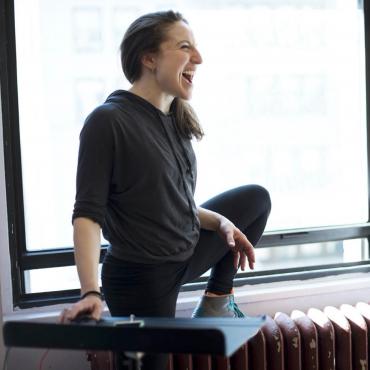

Ephrat Asherie is a NYC based b-girl, performer, choreographer and director, and a 2016 Bessie Award Winner for Innovative Achievement in Dance. Asherie has received numerous awards to support her work including Dance Magazine’s Inaugural Harkness Promise Award, a Jacob’s Pillow Fellowship at the Tilles Center, a Jerome Foundation Travel and Study Grant, and a National Dance Project award. The live performance chapter of her new project UnderScored is being commissioned by Works & Process at the Guggenheim Museum and will premiere in 2021. She is honored to have been mentored by Richard Santiago (aka Break Easy) and to have worked and collaborated with Dorrance Dance, Doug Elkins, Rennie Harris, Bill Irwin, Gus Solomons Jr., and Buddha Stretch. Asherie is a co-founding member of the all-female house dance collective MAWU and is forever grateful to NYC’s underground dance community for inspiring her to pursue a life as an artist.
Fellowship Statement
My work is rooted in the complex rhythmic, physical, cultural, and spiritual lineages of New York City's underground dance community, a community I have been fortunate to be a part of for almost two decades. The performers I collaborate with are all part of the underground scene and we share, not only common movement languages (including breaking, hip hop, house, and vogue) but also an interest in exploring unconventional ways of remixing dances in various contexts, including creating for the stage. Implicit in working in these Latinx and African American vernacular forms is an ongoing conversation around the systemic racism that plagues this country, the struggles of the LGBTQIA+ community, joy as a form of resistance and resilience, and the commodification of culture as a means to make communities of color invisible. The underground dance scene and NYC’s complex labyrinth of cultural collisions inspired my hybrid approach to movement, which is integral to my work.
Photo by Claudia Celestino
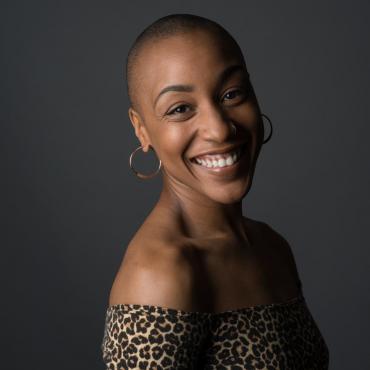

Vie Boheme, a Motown native who blossomed creatively in Pittsburgh and refined in Minneapolis, is a multimodal artist, choreographer, dancer, and singer. Her choreographic work has been presented at Intermedia Arts, the Guthrie Theater, the Southern Theater, the Walker Art Center, Dance Alloy Theater, and the Kauffman Center. She received a Cultural Community Partnership Award from the Minnesota State Arts Board in support of her most recent work, CENTERPLAY, and is a former co-creative director, vocal artist, and choreographer for Stokley Williams, founding front man of Mint Condition. She was a founding member of The August Wilson Center Dance Ensemble (Top 25 to Watch, Dance Magazine, 2012) and also a former dance artist with Camille A. Brown & Dancers and TU Dance. Boheme’s recent TedxMinneapolis talk, Is Performing Art Worth the Struggle?, is available for viewing. She is a Vinyasa, Yin and fitness yoga instructor with her own signature teaching philosophy, CoreKinetics Yoga; and a Teaching Specialist in the Dance Department at the University of Minnesota.
Fellowship Statement
I am a multimodal artist; a choreographer, singer, dancer, actress, poet and a writer. I design theatrical performance experiences that weave all of these mediums. I bring athletic agility to vocal performance by singing and dancing in unison, eliminating the boundary between the visual and audio experience. I also weave sentiment and storytelling through poetry and monologues. Each performance piece is designed to give a glimpse into the sometimes dark and complex emotional spaces people experience that seem elusive and ever present.
My work is acknowledgement and expression of the experiences of African American women. Multilayered, interwoven, shining light filtered through many cultural layers.
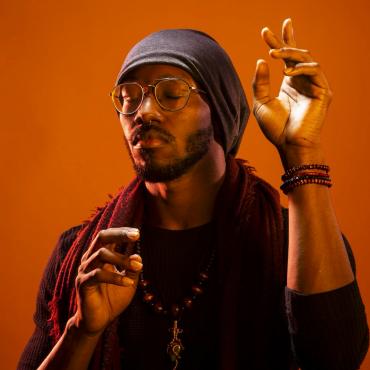

J. Bouey is out here doing their best, damnit! Currently moving on pandemic timing and prioritizing rest, Bouey is a dance artist who daringly explores trauma and mental illnesses from their Black american, agender, and sexually queer perspective in their creative practice. Bouey’s work has been shared through live performance and film.
Living with depression and severe anxiety, Bouey is finding their way back to joy with a determination to manifest the dreams dreamt from their youth. These dreams sustained them when the sun didn’t shine or shined too bright to see.
Fellowship Statement
Yo, what's up?! This fellowship has found me knee-deep in grief research! The onset of the pandemic prompted me to study grief to equip me with the knowledge to support Black folx who've experienced death and loss due to covid-19. The research led me to reckon with my underexplored grief.
Photo by Natalie Tsui
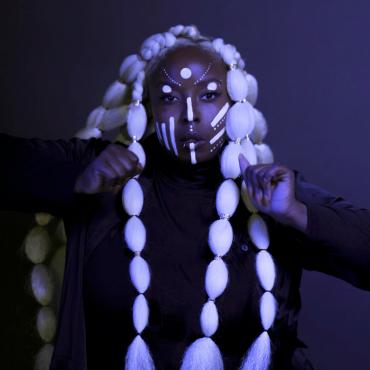

DejaJoelle is an African Centered artist that focuses on the Healing and Liberation of Black Communities across the globe. DejaJoelle does not find comfort in highlighting where she’s been or what she has “accomplished” but has accepted that life is an everlasting journey that is worth being present for. Give Thanks.
Fellowship Statement
I am an African Centered - Healing Artist, Choreographer, Director, and Cultural Healing Curator. I believe Dance serves as our connection to ourselves, our communities, and our overall Divinity. I create intentional spaces for Black, LGBTQ2, and Deaf community to discover their own practices toward Healing using Dance, Body Reclamation, and other Healing practices. As the world experiences collective hurt and grief, I trust that our greatest act of REVOLUTION and REBELLION against hatred and corruption is Self-Love and Healing through Dance. I refuse to fuel the fire of destruction and heinousness and instead focus my Art and energy on properly handling Black people who continue to be mishandled.
Photo by Awa Mally
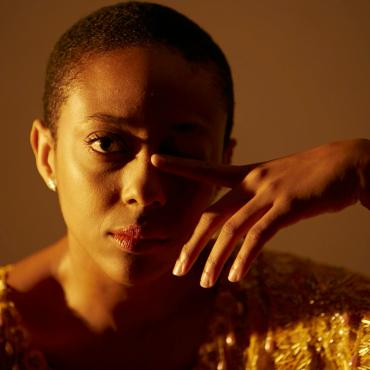

Fana Fraser was born and raised on Kairi, now known as Trinidad and Tobago, and is currently living in Brooklyn on Lenape land. Her work is rooted in a contemporary Caribbean aesthetic and framed by narratives of eroticism, power, and compassion. Her performances have been presented at region(es): Central, ISSUE Project Room, Wassaic Project, Brooklyn Museum, The Knockdown Center, Movement Research at Judson Church, BAAD!, La MaMa Moves!, the CURRENT SESSIONS, Gibney, Trinidad Theatre Workshop, and Emerging Artists Theatre.
Fraser was a Movement Research Van Lier Fellow (2017), a resident artist at the inaugural MANCC Forward Dialogues Choreographic Lab (2017), the Dance & Performance Institute in Trinidad & Tobago (2016) and Dance Your Future (2016)—a project partnership between BAAD! and Pepatián. She has served as Rehearsal Director for Ailey II. A full spectrum doula-in-training, Fraser currently works as a co-director for Pepatián.
Fellowship Statement
I am guided
by spirit
animal
shadow
knowing and desire. I am from playful heat, fire and nebula
ocean, salt sweet, ferocious madness. Grounded by love and rage I dance,
embody sound and string language, to resurrect voices of ancestors
unsilenced,
I serve as a channel for remembered stories to be told.
I am opening to delightful fantasy, winding and spiraling things into wild
magnificence
in honor and as offering
to the survivors, the warriors who have come before me.
With kin, I am ready to help cast hope for the children of our children’s
children’s children,
to listen, give thanks and praise their dreams.
Photo by Whitney Browne


Jerron Herman (he/him) is a disabled artist working in dance and text to facilitate welcoming. From late 2018 into 2019 he produced four world premiere commissions for Gibney, Performance Space New York, The Whitney Museum, and Danspace Project, and performed excerpts at The Kennedy Center. Jerron joined Kinetic Light in 2019, having been a member of Heidi Latsky Dance since 2011.
Jerron has served on the Board of Trustees at Dance/USA since 2017, most recently as Vice Chair. He was a finalist for the Lark Play Development Lab/Apothetae Fellowship and received The King’s College Alumni Award also in 2017. From 2019-2020 he curated the series Access Check 2.0: Mapping Accessibility for the Shelley & Donald Rubin Foundation and writes extensively on art & culture. Jerron was named a 2020 Disability Futures Fellow by the Ford Foundation and the Andrew W. Mellon Foundation.
Fellowship Statement
My work aspires to connect disparate contexts together to reveal their cohesion. In recent pieces I’ve sampled and sourced from history, popular culture, and text. Now, I wish to use my body as a source. Growing up in medicalized contexts such as physical and occupational therapy I relied on others’ expertise of my body to will it and control it; I experienced a similar fashioning in dance, but through movement experimentation have noticed explicit choreography across my limbs. When mitigating pain or crossing my body I’ve noticed the movement is active, and has the potential to parallel contexts outside the body. I’m following the symbolism in my diagnosis to reveal the scholarship inherent in the unnoticed quakes. What can my warring hemispheres teach me?
Photo by Mark Wickens
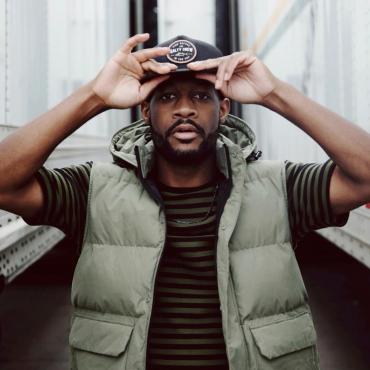

Herb Johnson III (aka JDot Tight Eyez) graduated from Perpich Center for the Performing Arts in 2010 and studied 3 years at the Lundstrum Center for Arts. Johnson is now an an Urban & Street dance instructor at the University of Minnesota. He choreographs and performs solo and in groups 612 Crew, DeadPool, and Mixtape. Professional work includes iLuminate from America’s Got Talent, choreographing G-Easy's Halftime Show 2018, and Super Bowl 52 Halftime Show 2018 with Justin Timberlake. Johnson was a 2017 McKnight Dancer Fellow and received a 2018 Momentum: New Dance Works commission and a grant from the Foundation of Contemporary Arts. Additionally, he received a Jerome Travel/Study grant in 2018 to travel to Dusseldorf, Germany to attend European Buck Session’s annual Krump dance event.
Fellowship Statement
Herb Johnson III is a multi-disciplinary artist and Krump Scholar. As a leader of the Krump dance movement in Minnesota, he aspires to continue to build and bring visibility to the community through training within the style and event organization.
Photo by Juiceedope (Julius Johnson)
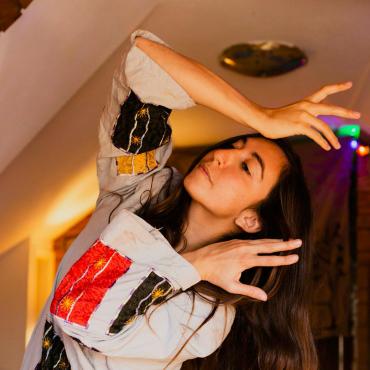

LeilAwa [Leila Awadallah] is a Palestinian, Arab-American dancer, choreographer, filmmaker and cultural activist based in Minneapolis, Mni Sota Makoce and Beirut, Lebanon. She holds a BFA in Dance and minor in Arabic Language and Literature from the University of Minnesota. LeilAwa founded the project: Body Watani (body-as-homeland) and is developing an offering of Arab Rooted Contemporary dance, both of which engage with dance forms, rhythms and rituals of SWANA, ancestral memories, and embodied reflections on settler-colonial occupation and indigenous resistance.
LeilAwa’s work and research has been supported by Jerome Foundation, Springboard for the Arts, Arab American National Museum, Mizna, Lebanese National Theatre, Amalgam, Camargo Foundation, Cedar Tree Project, Walker, Rhythmically Speaking, Threads Dance Co. and SAGE. Leila danced with Ananya Dance Theatre, performing locally, nationally, and internationally in Ethiopia, Palestine and India; is a founding member of Kelvin Wailey, 3wadallahs and Solidarity Rising; and a collaborator with Theatre of the Women of the Camp.
Fellowship Statement
LeilAwa (lay-luh-wuh) merges my gifted name, لیلى , with my family lineage, عوض اللھ , to embody a self that is both rooted in histories and becoming into futures. I dive deep into intersections of arts and activism, beginning with body and breathing outwards to examine the ways dance engages with human rights, invites healing, invokes critical thinking, and physicalizes practices of decolonizing our bodies / lands through re-membering and re-imagining. This emerging project: Body Watani is a pathway, a container with soft edges, space for artists / peoples to reflect on this notion of body as a site of living homeland. Through this fellowship, I will take steps to establish Body Watani as a project-based dance company split between Minneapolis and Beirut, building community, creating workshops, growing collaborations, and initiating the company’s first full piece, Terraena: hakawati of the sea. As well as prioritizing Arab, SWANA, and Mediterranean dance / cultural / political studies. SWANA [South West Asia and North Africa] is a decolonial term used when referring to the ‘Middle East’ or ‘Arab world’ (which is not all Arab) to locate geographically rather than ethnically.
Photo by Trista Marie Photo
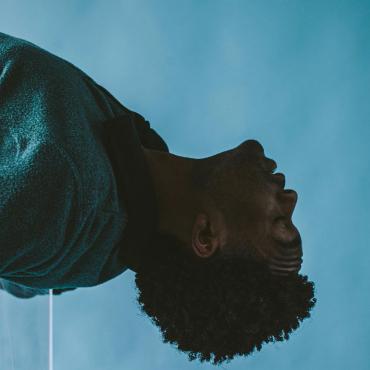

Jordan Demetrius Lloyd is a dance artist based in Brooklyn, NY. Originally from Albany, NY, Lloyd graduated from The College at Brockport where he performed works by Maura Keefe and Alexandra Beller. He has collaborated with and performed for Karl Rogers, Netta Yerushalmy, Tammy Carrasco, Monica Bill Barnes, Catherine Galasso, Laura Peterson, Ambika Raina and David Dorfman Dance. His teaching practice has brought him to Rutgers University and Mark Morris Dance Center, and his work has been produced by New York Live Arts, BRIC, ISSUE Project Room, Movement Research at Judson Memorial Church, The Center for Performance Research and Brooklyn Studios for Dance. He was selected as a 2019 Center for Performance Research Artist in Resident and is a recipient of the 2019-21 Fresh Tracks Performance and Residency Program at New York Live Arts. For more please head to jordandlloyd.com
Fellowship Statement
My approach to making is visual and imaginative, using movement as a tool to manipulate time and space and to stretch the edges of the collective experience. I work intuitively when generating material and focus on formal elements such as shape, color and texture to arrive at a place of cohesion. My work is home to considerations of place and moments in the world, teetering along lines of fantasy and vast, radical imagination. By rooting my work in compositional specificity and performative intention, I aim to muddle interpretation and complicate association, keeping the viewing experience active and participatory. Movement, to me, can act as a portal into memory, ancestry and a deeper level of feeling that widens the possibilities of what a moment represents. In many ways, my work seeks to sustain attention, evoke questions, and stimulate opinions while bringing communities together to share a specific moment in time.
Photo by Aundre Larrow
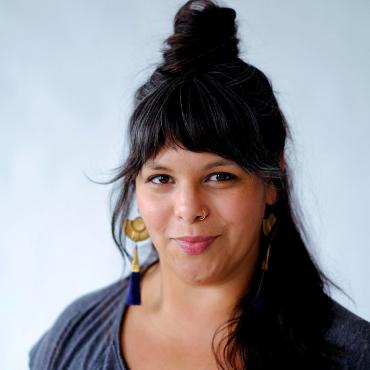

Taja Will is a queer, Latinx (Chilean) adoptee, performer, choreographer, and Healing Justice practitioner based in the Twin Cities, the occupied land of the Dakota and Anishinaabe peoples. Will integrates improvisation, somatic modalities, text and vocals in contemporary performance that explores visceral connections to current socio-cultural realities through ritual, archetypes and everyday magic.
Will has been presented in Walker Art Center Choreographer’s Evening, Red Eye Theater, Right Here Showcase and the Candy Box Dance Festival and is the recipient of a 2018 McKnight Choreography Fellowship, administered by the Cowles Center and funded by The McKnight Foundation. Will recently received support from the National Association of Latinx Arts & Culture, the Minnesota State Arts Board, and Metropolitan Regional Arts Council. As a performer Will has collaborated with Sara Shelton Mann, Rosy Simas, Keith Hennessy, Pramila Vasudevan, Deborah Jinza Thayer, Timmy Rehborg, Body Cartography Project and Miguel Gutierrez among others.
Fellowship Statement
My work is conceptual, state-based, grounded in personal practice, and always in relationship to socio-cultural realities of the moment. In that, my areas of attention for the fellowship duration will include personal movement practice, mentorship, and writing/artist advocacy. For me, a weekly, uninterrupted personal movement practice is a foundation for my creativity, physical range, and the creation of new work. Mentorship is my primary affinity. I intend to continue my mentorship with Sara Shelton Mann, as she is willing and able, and start a mentorship with a voice-based artist and a contemporary performance artist who engages with writing. Another area of focus I’m invested in is writing, creative and pragmatic. I’m interested in developing tools for artists to encourage further equity in relationship with presenters and institutional partners, such as a values rider.
Photo by Nanne Sorvold
2019 Fellows
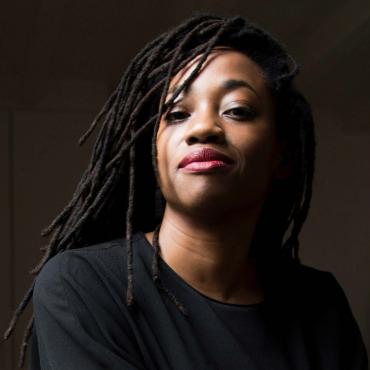

Shirley Bruno (she/her) holds Masters from London Film School and Le Fresnoy - Studio National des Arts Contemporains where she was an artist fellow. Shirley's shorts have received awards at major festivals including the Off-Limits Prize in Competition for her experimental short AN EXCAVATION OF US at Annecy International Animated Film Festival (2018) and the Prix Ars Electronica Honorary Mention (2018). Her docufiction TEZEN was awarded prizes from the National Greek Film Centre (2017) and the StudioPrix Collector (2016) initiated by art collectors Isabelle and John-Conrad Lemaître. She has received funding and support for her work from New York State Council on the Arts, New York Foundation for the Arts, Jerome Foundation, La Cité International, and LIM—Less is More part of Le Groupe Ouest.
Fellowship Statement
Shirley’s films draw from her heritage preserving and radicalizing her ancestral traditions and mythology. She creates modern myths that expose the slippery spaces between the material and metaphysical world, documentary and fiction, between collective memory and history. She explores the everyday, the Sacred, and the intimate violence in the things left unsaid that mark us generation after generation. Her work often takes its point of departure from neglected histories as well as from rumors, dreams, superstitious beliefs, and memories both real and imagined. Currently, Shirley is developing her first feature film, an intimate meditation on women, land, and family legacy.
Photo by Léa Girardin.
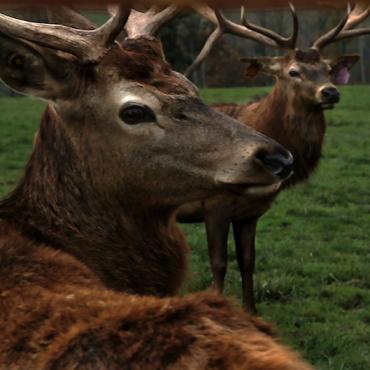

Jason Coyle (he/him) and Laska Jimsen (she/her) work across nonfiction forms from video documentary to 16mm filmmaking. Their individual and collaborative work has screened at festivals and venues including Ann Arbor, Athens, Big Muddy, IC Docs, Los Angeles Filmforum, Cellular Cinema, and Walker Art Center. Laska and Jason are individual recipients of Minnesota State Arts Board Artist Initiative Grants and a Jerome Foundation Minnesota Film & Video Grant. Laska is Associate Professor of Cinema & Media Studies at Carleton College; Jason is Associate Professor of Media Arts at the Minneapolis College of Art & Design.
Fellowship Statement
Our experimental nonfiction film and video work foregrounds acts of observation in sustained investigations of human-animal relationships, systems of management and classification, and representations of the everyday. Our ongoing series Almanac is a collection of formal studies of light, motion, and time, exploring sensory dimensions of seasonal states through singular moments in afternoons across the year. Research is integral to how we conceive of and create longer-form documentaries. We are currently developing new projects that draw on the history of automation and pose questions about contemporary labor and workplace transformations.
Photo (Jason Coyle and Laska Jimsen’s Deer of North America 2017) courtesy the artists.
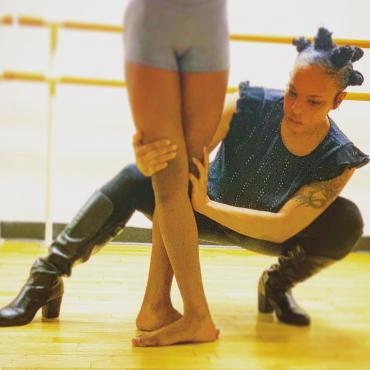

Kerri Edge (she/her) is an artivist who uses dance and film as vehicles to shed light on issues of social injustice and commemorate the achievements of African American people. She is Artistic Director of the Edge School of the Arts (ESOTA), which was founded in the image of the Bernice Johnson Cultural Arts Center (BJCAC). ESOTA is dedicated to bringing the art and discipline of African American dance to young aspiring artists and audiences, from local to international. Kerri began her dance training at the age of three at BJCAC in Jamaica, Queens where she met her mentor Michael Peters, who sparked her interest in dance for film. She continued her studies at The Eglevsky Ballet School, LaGuardia High School, Alvin Ailey American Dance Theater, The Martha Graham School, and SUNY Purchase. She earned her Masters in Arts Administration from New York University and is currently a Professor of Dance at Medgar Evers College. Her commitment to the Jamaica arts community is evidenced by her volunteer work with the Jamaica Is . . . Arts Alliance, the Afrikan Poetry Theatre, the Greater Jamaica Development Corporation and the Queens Sickle Cell Advocacy Network.
Fellowship Statement
I am an artist making sense of the world that I am a part of; I would like to leave a trace in forms that are felt and experienced for all people, now and for future generations. I am an artivist grappling with notions of memory and time, along with the role of African American-based dance rituals and body memory, through all of the senses, finding locations for where they intersect and create sensations of depth and wonder.
My 4 Little Girls film uses the universal languages of photography, song and dance to depict stories from the American Civil Rights Movement. An extensive education component helps children and adults explore history together through the use of objects from a vast collection of expressive poster samples from the Civil Rights Movement, lessons on two important social issues, and engaging hands-on activities. REFORM: Racial Disparities in the American Justice uses tap dance as a vehicle to shed light on the racial disparities in the American criminal justice system encouraging others to advocate for legislation. The collection of tap dance monologues set to music, poetry and film tell stories that highlight the African American male experience with the criminal justice system and the lasting effects on both the African American family and the community at large. The short stories are compiled into a unified work that stands with victims threatened by the increased discrimination and encourages audience members to realize the promise of equality America makes to us all.
Photo by Saiku Branch.
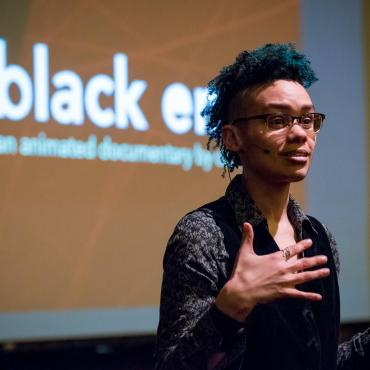

Carrie Hawks (they/them) makes art to investigate gender, sexuality, and race and promote healing. Their works have been exhibited at the Ann Arbor Film Festival, the Brooklyn Museum, CinemAfrica (Stockholm), Cape Town, and Tokyo. Animation, drawing, collage, sculpture, doll-making and performance are all vital parts of their art practice. They harness the magic of animation to tell stories. Their film black enuf*, partly funded by Jerome Foundation, was nominated for a New York Emmy, won numerous festival awards and had its broadcast debut on American Public Television’s World Channel in 2019. They have performed with Black Women Artists for Black Lives Matter, and participated in the Set on Freedom Artist Residency at the Queens Museum. They hold a BA in Art History & Visual Arts from Barnard College and a BFA in Graphic Design from Georgia State University.
Fellowship Statement
My art confronts self-imposed and external assumptions about identity in order to promote healing, particularly in relation to race, gender, and sexuality. My work highlights stories that are not being represented enough. My practice presents alternate ways of connecting through a variety of media including animation, drawing, collage, sculpture, and performance. I also incorporate humor. In performance, I have asked participants to tell me about their nemeses so that we could destroy them on paper. In film, I’ve asked “if I am Black enough” for my peers and myself, and what Blackness is. I search for strategies to address being an outsider and holding self-love. My art exudes strength in its honesty, craft, and visual metaphors. I draw upon my insecurities, confusion, and fear and invite the audience to reflect on theirs. My current project, Inner Wound Real, focuses on people of color and their experiences with self-injury.
Photo courtesy of Nelson-Atkins Museum.
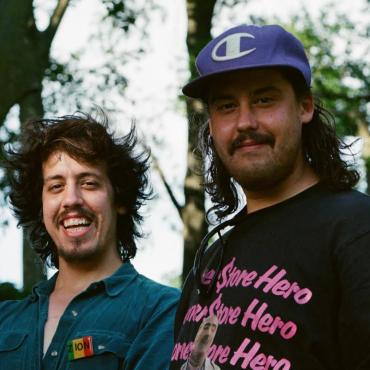

Adam Khalil (he/him) and Zack Khalil (he/him) (Ojibway) are filmmakers and artists from Sault Ste. Marie, Michigan and are currently based in Brooklyn, New York. Their work subverts traditional forms of ethnography through humor, transgression, and innovative documentary practice. Their films and installations have been exhibited at the Museum of Modern Art, Sundance Film Festival, Walker Art Center, Lincoln Center, Tate Modern, the Whitney Museum of American Art, UnionDocs, e-flux, Maysles Cinema, Microscope Gallery (New York), Spektrum (Berlin), Trailer Gallery (Sweden), and Carnival of eCreativity (Bombay). They both graduated from the Film and Electronic Arts program at Bard College and are UnionDocs Collaborative Fellows and Gates Millennium Scholars.
Fellowship Statement
Our work centers indigenous narratives in the present—and looks towards the future—while subverting traditional forms of ethnography through humor, transgression, and innovative nonfiction practice. With a practice that includes experimental filmmaking, documentary, performance & curation, we are charting out a critical & unconventional space for situating & interrogating ideas of indigeneity today.
Photo by Bayley Sweitzer and Sam Richardson.


Naomi Ko (she/her) is a writer, actor, filmmaker, and cultural producer. Her TV pilot, NICE, was an official selection at the 2018 Tribeca Film Festival. Naomi created, wrote, and starred in the half-hour pilot. Naomi also played Sungmi in the 2014 Sundance award-winning feature film Dear White People, is a Moth StorySlam winner, and a featured performer for Mortified. Naomi performs with Funny Asian Women Kollective (FAWK) around the country and her comedic writing and performance can be seen in Episode 5 of The Mortified Guide, now available on Netflix. Naomi is the co-founder of the APIA MN Film Collective and has won multiple grants, awards, and fellowships for her work. Naomi is currently in pre-production for an upcoming short film she is directing and she is developing her feature film Good Genes.
Fellowship Statement
My work primarily focuses on creating unapologetic and raw film and TV narratives that feature fearless Asian American women. Even though the genres I play with can span from a raunchy sports comedy to a historical drama, at its core, each story explores the diversity of spirit, personality, and interests of Asian Americans in a grounded and humanistic lens. Currently I am exploring the ways in which Asian American women exercise their agency through my next feature film, Good Genes. It is a black comedy about a group of scientists of color who create their own personal genetics ancestry company to alter the genetic ancestry of known racists and white supremacists.
Photo by Katherina Vang.
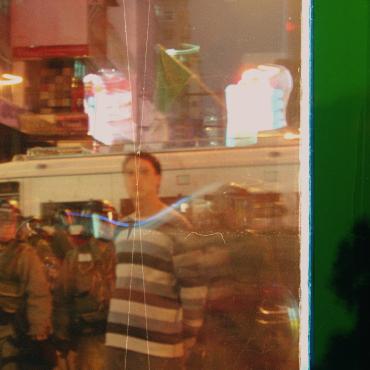

Simon Liu (he/him) was raised between Hong Kong and Stoke-On-Trent, UK and lives in Brooklyn. His films and 16mm multiple projections have been presented at film festivals globally including the Toronto, Rotterdam, BFI London, Edinburgh and Hong Kong International Film Festivals. He has performed at institutions such as the M+ Museum, Tai Kwun Contemporary, CROSSROADS at SFMoMA, Yale University and as part of Dreamlands: Expanded—an expanded cinema series presented by the Whitney Museum of American Art and Microscope Gallery. Liu is an adjunct faculty member at the Cooper Union School of Art and a member of Negativeland, an artist-run film lab in Brooklyn. He has received grants from the New York State Council on the Arts, Wave Farm and the Jerome Foundation. He is in post-production on his first feature, Staffordshire Hoard and is developing a film which imaginatively traces the passage of an ancestor who traveled from Guangzhou to Amsterdam by foot.
Fellowship Statement
In recent years my practice has centered around building a filmic catalogue from my places of origin through a body of work consisting of abstract diary films, alternative documentaries and 16mm projection performances. These works act as a storage mechanism that activate the potential for me to reconsider my formative experiences and how they relate to my position as a half Chinese, half English person who was born and raised in the former British colony of Hong Kong. I’m driven by a desire to compress fleeting exchanges into a single frame—by exploiting the material potential of “outdated” analogue formats—with the intent of relaying an exaggeratedly contemporary experience. Currently I’m working on a suite of 16mm films which call into question the ethics of image making and two feature documentaries that interrogate personal family mythologies in relation to centuries old histories of South China and the English Midlands.
Photo: Still from E-Ticket (2019) - Photo of the Artist at a WTO Protest in 2006.


Kate Marks’ (she/her) film PEARL WAS HERE has over 25 million views on YouTube. She is a 2016 HBO Access Directing Fellow as well as a 2013 Project Involve Fellow (Barbara Boyle Award winner). She directed the HBO Access pilot MANIC, which premiered in the 2017 Tribeca Film Festival and received Best Drama from the New York Television Festival and Best Actress in a Drama at Series Fest. Her award-winning shorts (PEARL WAS HERE, HOMEBODY, 7 DAY GIG, and MIRACLE MAKER) continue to screen all over the world, including Slamdance, Edinburgh International, Palm Springs ShortFest, New Orleans, Austin, Nashville, Atlanta, and Cleveland International Film Festival as well as broadcast on PBS.
Kate holds a BA from Brown and her MFA in film-directing from CalArts where she received the Beutner Award for Excellence in the Arts. Additionally, Kate is an organizer, a teacher, a stilt-walker, a bad trombonist, and a reckless dancer.
Fellowship Statement
I come from a long line of tricksters. My grandpa was famous for his epic pranks and my dad was a legendary wild man. Telling tall tales is in my blood and (like a good trick) my films use comedy, surprise, and spectacle to take you somewhere unexpected. My stories feature oddballs, misfits, and losers and I love experimenting with tone, mining humor out of dark situations. I am currently working on my first feature, THE COW OF QUEENS. In the final days of her father’s illness, Sonya and her dad, Del, go on one last adventure to usher an escaped slaughterhouse cow to freedom through the streets of New York. It’s an off-kilter love story about a dad, a daughter, a cow with a dream, and the good people of Queens.
Photo by Jamie Milner.
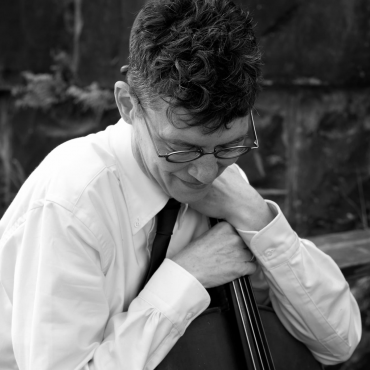

As a media composer and installation artist, Kathy McTavish (ze/hir) creates chance-infused, open systems. Ze uses generative methods to build networked, multichannel video and sound environments ::: cross-sensory, polyphonic landscapes which flow from the digital web (the cloud) into physical spaces.
Kathy has a background in cello performance, mathematics, ecology, music theory and code. The confluence of these disciplines informs hir work as a composer and multimedia artist. As both a musician and a mathematician, Kathy likes multi-threaded, dynamical systems and chance-infused, emergent patterns. As a queer artist, ze is interested in the ways we construct personal stories / myths and the infinite, bendable between.
Kathy’s current work explores the porous, intimate boundaries between humans and machines ::: the erotic dynamics of tapping glass ::: the carbon cycle ::: the cyborg body ::: the fragile electric body ::: the resistance cyborg ::: the networked, digital hive mind ::: the swarm.
Fellowship Statement
I like patterns but my work explores chance & improvisation. Mathematical models are a score. They are a blueprint to draw contours of change and movement ::: convergences, divergences, emergent patterns and cascading, system-level impacts.
Chance is a frayed thread, a stochastic cloud, a pointillist field, a complexity, an uncertainty, a ragged line. Chance is a prayer ::: a slim window of chance to survive this time of profound climatic change. Evolution requires fruitful deviation. A system's ability to adapt to change depends on its ability to mutate ::: on trial & error & improvisation.
I am interested in the poetics of code ::: the networked (i) ::: a deviant, queer learning machine ::: aerial artist ::: (m)bodied cloud ::: burlesque, cybernetic ze ::: beat poet of electricity ::: a honey ::: a lure ::: a torrent.
Photo by Magic Box Photography, Duluth, MN.
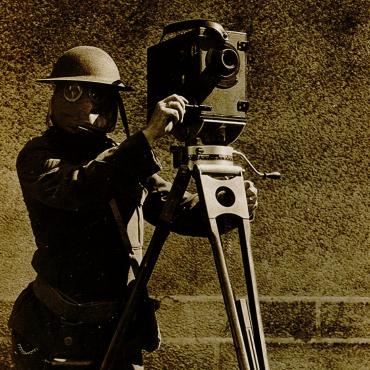

Richard Wiebe’s (he/him) award-winning work has screened widely at international film festivals including IFF Rotterdam, Media City, Cannes Cinéfondation, FIDMarseille, Festival du nouveau cinéma Montreal, UnionDocs Center for Documentary Art, Ann Arbor Film Festival, and several others. He is the recipient of grants from the Princess Grace Foundation and the Minnesota State Arts Board. Richard teaches courses in sound design, screenwriting, and the art of the short at Hamline University and FilmNorth. He is the Experimental Cinema programmer for the Minneapolis/Saint Paul International Film Festival (MSPIFF) and a member of the collective Cellular Cinema.
Fellowship Statement
My current project-in-progress is a feature-length experimental documentary focusing on World War I cameraman Leon Caverly, the first official war cinematographer of the United States military. Using Caverly’s pro-war cinematography found in the National Archives, I will fashion an anti-war film. Caverly shot the film 100 years ago, I will edit and do the sound design. This constraint-based collaboration with Caverly will also include materials from early American cinema, television, and other archival sources, alongside contemporary footage I have shot. Ultimately, this project will result in a de-stratified history of American militarism from the canons of the Confederacy at the Siege of Petersburg to depictions of unrest today. World War I propaganda, where cinematic propaganda first blossomed, is the center that holds it all together.
2021 Fellows
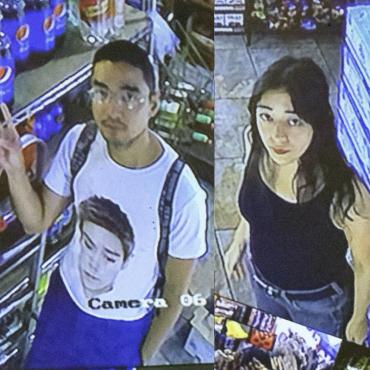

Daniel Chew and Micaela Durand have been collaborators for ten years since film at NYU. Latent in their films are issues of intimacy and connection, two feelings that are increasingly difficult to discern and cultivate in our technologically mediated present. For them, collaboration is one way of dealing with this alienated condition. It is also a political decision that not only acknowledges filmmaking as a collaborative effort, but also strives to move beyond the idea of an artistic genius with its attendant ideas around gender, race, and sexuality. Their work has been shown extensively in the U.S. and abroad including at the International Film Festival Rotterdam, MoMA PS1, White Columns, 47 Canal, Sheffield Doc/Fest, Parish Art Museum, and MoCA LA. In Spring 2020, they were fellows at MacDowell.
Fellowship Statement
We are currently finishing a trilogy of films that we describe as showing the internet without showing the internet. By this, we mean that instead of relying on literal translations of technology and social media, we strive to show how the internet makes us feel and how our digital selves and physical bodies are intimately intertwined in our current moment. The trilogy started with First (2019), a film that follows a teenage girl who interacts with friends and strangers, receiving messages both benign and threatening. The second, Negative Two (2020), revolves around a twenty-something gay man navigating loneliness and the city through gay hook-up apps. We are currently in post-production for 38 (2021) which tells the story of a 38-year-old woman who obsessively watches the social media accounts of the young woman who broke up her marriage.
Photo by Tony Jackson
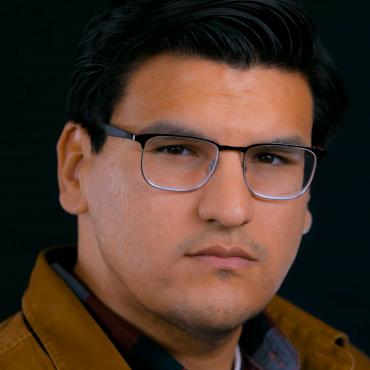

Lyle Mitchell Corbine, Jr. is a filmmaker. His short films Shinaab and Shinaab, Part II premiered at the Sundance Film Festival in 2017 and 2019 and the Toronto International Film Festival in 2017 and 2018. He was supported at the Sundance Institute Screenwriters Lab and Directors Lab in 2017 and 2018. He has been a recipient of numerous grants and fellowships from the Sundance Institute, McKnight Foundation, Time Warner Foundation, Maryland Film Festival, and the Minnesota State Arts Board. His first feature, Wild Indian, will premiere in the U.S. Dramatic Competition at the 2021 Sundance Film Festival. Corbine is one of Variety’s 10 Directors to Watch for 2021.
Fellowship Statement
While I love making ambitious personal films like the Shinaab series and my first feature Wild Indian, I want to pursue making genre films that are accessible and for everyone. I am currently working on a number of both types of projects. Stay tuned...
Photo by Joel Feld


Cy Dodson, owner of Minneapolis-based, Triumph Pictures, is focused on producing award-winning documentary content. Dodson combines his use of cinematography and editing to craft compelling tales of the human spirit creating memorable, gripping productions. His latest film Say His Name: Five Days for George Floyd was commissioned by Twin Cities Public Television (TPT) for their 2020 Project, premiering in April 2021. His third film, Emmy-nominated Beneath the Ink (2018) hits on complex racial issues in his Ohio hometown that highlights human stories of forgiveness and redemption. The film won numerous jury and audience awards at festivals worldwide including DocEdge (Academy qualifying), BendFilm, and Palm Springs Shortfest. Conde Nast acquired the film for their GQ Stories platform and it was selected as a Vimeo Staff Pick. Dodson is also the recipient of a 2020 McKnight Media Artist Fellowship, administered by FilmNorth and funded by the McKnight Foundation.
Fellowship Statement
I am unassuming by nature, introverted even. My quiet personality allows me to connect with my subjects. They find the freedom to confide intimate stories with honesty and sincerity. My path to documentary filmmaking was not immediate, but now I feel it’s my purpose. For example, with the recent unrest in my neighborhood in Minneapolis, I was compelled to tell my community’s story with Say His Name. My duty as a documentary filmmaker is to continue be there, letting voices be heard in the name of social justice and reform. I seek out stories that are unique yet universal, that have multiple layers of complexity yet make a direct, personal connection to viewers that can be reflective and change perceptions. My responsibility is to exercise my craft––as a cinematographer and editor––in such a way that voices are heightened. Their voices, in turn, are my voice, and my art.
Photo by Mark Brown
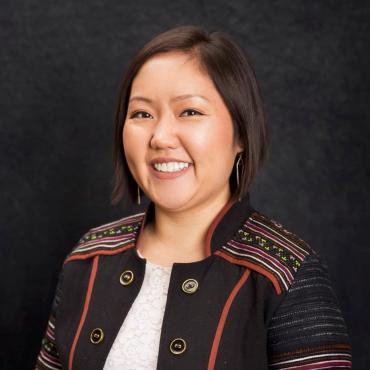

Joua Lee Grande is a filmmaker, photographer and community educator whose goal to highlight underrepresented perspectives and communities drives her work. She produces documentaries and edits the news part-time at WCCO TV 4 News. She has produced short documentaries such as Legislating from Home and Laos Girls Teen Project. Grande was a 2019 Diverse Voices in Docs Fellow through Kartemquin Films and Community Film Workshop of Chicago. She is a member of collectives such as A-Doc and Brown Girls Doc Mafia and a community educator and worker. She teaches media production and related arts at the Saint Paul Neighborhood Network and other institutions throughout the Twin Cities. She is currently in early production for her first feature documentary Spirited.
Fellowship Statement
I believe that there is no such thing as absolute truth, and that storytelling serves as a tool to share versions of the truth. I utilize documentary filmmaking as a tool to elevate voices, perspectives and experiences from communities that are either underrepresented or misrepresented in the larger society. My work often pushes into topics that are deemed uncomfortable such as menstruation taboo and guest-daughter traditions. My goals are to build connection, draw out commonalities amidst human differences, and push viewers into places of discomfort so they can engage in conversations that ultimately lead to positive change. I am a big believer in contributing to a community that lifts others up to tell their own stories. So much of what I learn in my own journey to become a stronger filmmaker, I willingly share with others.


Madeleine Hunt-Ehrlich is a filmmaker and artist. Her work has screened all over the world including at the Guggenheim Museum and the Whitney Museum of Art in New York and in Film Festivals such as True/False, New Orleans Film Festival, Doclisboa, and Blackstar Film Festival. She was named to Filmmaker Magazine's 2020 “25 New Faces of Independent Cinema List” and is the recipient of a 2020 San Francisco Film Society Rainin Grant, as well as a finalist in the 2020 Venice Film Festival’s prestigious film lab the Biennale Cinema College. She received a 2019 Rema Hort Mann Award, a 2019 UNDO Fellowship, a 2015 TFI Future Filmmaker Award, and a 2014 Princess Grace Award in film.
Fellowship Statement
I am interested in modes of filmmaking and remembering that are liberatory for black women. My work deconstructs the default conventions of representation that we have been taught, weaving together non-fiction, theatrical performance, narrative intervention, and fantasy. The result is a style of storytelling where the past is always present, and time is not linear but in fact a constant weave.
Photo by Dominick Lewis
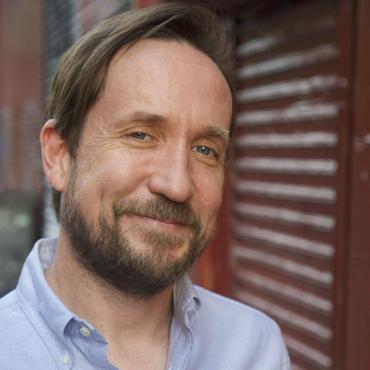

Benjamin May’s directorial debut, The Legend of Swee’ Pea, premiered at DOC: NYC and played at over 40 festivals worldwide, winning five Best Documentary Feature awards and two Best Director awards. His second feature, Wet House, an immersive film about the largest harm reduction facility for chronic alcoholics in the US, is distributed by 1091Pictures and Saboteur Media. Ben's work has been funded by grants from the McKnight Foundation, St. Paul Cultural Star, and the Jerome Foundation.
Fellowship Statement
As a documentary filmmaker, I am most interested in subjects and environments we might consider strange or remote—not because they are inherently more interesting or offer more conflict—but because I believe we are all a lot more similar than we are different. Everyone is susceptible to abandonment, failure, and loss. And because film is a deeply intimate endeavor it is the ideal medium to probe our proximity, question our biases, and examine the constructions we take for granted.
Humans are robust, but life is fragile. Working as a neuroradiologist for the past ten years, I have learned that, despite our powerful tools to observe the nature of life, truth is elusive, and certainty is non-existent. As a physician and a filmmaker, I find this idea both terrifying and inspiring and it is the crux of my work.
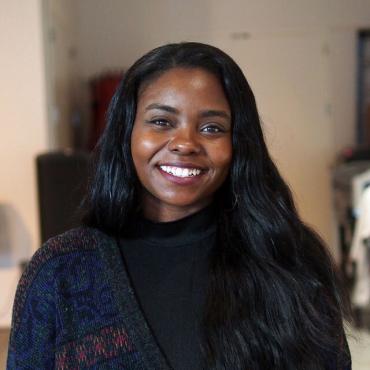

LaJuné McMillian is a new media artist, and creative technologist making art that integrates performance, virtual reality, and physical computing to question our current forms of communication. McMillian has had the opportunity to show and speak about their work at Pioneer Works, National Sawdust, Leaders in Software and Art, Creative Tech Week, and Art & Code’s Weird Reality. McMillian was previously the Director of Skating at Figure Skating in Harlem, where they integrated STEAM and figure skating to teach girls of color about movement and technology. They have continued their research on Blackness, movement, and technology during residencies and fellowships at Eyebeam, Pioneer Works, Abrons Arts Center, Barbarian Group, and Barnard College.
Fellowship Statement
As an artist, I leverage embodied and digital technologies to research and develop various artistic works across platforms (digital, and in person). During this Fellowship I plan to continue my work on The Black Movement Library. A library for Black people to learn about digital technologies in relation to Blackness, our movements, our histories, and our liberation.
Photo by Sarah O’Connell


Stefani Saintonge is a Haitian-American filmmaker, educator and editor who won the juried and audience award at BlackStar Film Festival for her short film, Fucked Like A Star. Her work has screened at several festivals and institutions internationally including Edinburgh International Film Festival, Ann Arbor Film Festival, Hammer Museum and the Smithsonian National African American Museum. As a member of New Negress Film Society, she co-created their annual Black Women’s Film Conference. She has received support from SFFILM, Jerome Foundation and Bronx Arts Council and served as an artist in residence with Haiti Cultural Exchange. Her work as an editor has screened at Sundance Film Festival, Berlin International Film Festival, Tribeca Film Festival, Guggenheim Museum and PBS.
Fellowship Statement
The process of liberation fascinates me. Whether it's physical labor, spiritual awakenings or self-interrogation, my work investigates the minutia (and oftentimes the mundanity) of building a new world. It could be a spiritual plane where meditation yields new imaginings or an actual massive, rapid undoing. I am drawn to the repetitive physical acts that force growth. I will use this time to develop a feature film about the week leading up to the slave rebellion that would spark the Haitian Revolution.
Photo by Babas Denis


Anna Samo was born in 1980 in Russia. On her first job in Moscow while scanning and coloring hand drawn animation, she witnessed how thousands of separated drawings put together, suddenly turn into a living character. She experienced the tickling feeling of surprise and wonder. This feeling has not left her ever since.
Samo studied animation in Russia and Germany. She was encouraged to create very personal work and to strive for her own authentic voice. As an independent filmmaker she uses a variety of analog animation techniques to create emotional and poetic work. Her films have been screened and won awards at highly acclaimed film festivals around the globe such as Anima Mundi, Krakow Film Festival, Full Frame, DOC NYC, Berlin Film Festival - Berlinale, Annecy Film Festival and Sundance among many others. Samo relocated to the USA in 2013. She lives and works in Brooklyn, New York.
Fellowship Statement
I look around and filter what I find through what's inside me. And while doing so I discover something I did not know before. I am inspired by clowns, poets and fools.
Animation is a super power! You can create anything you want – it just takes time. The time spent outside the studio is being condensed, changed through the time spent in the studio. Hours, days, months become pressed into the seconds of film-time. And like the hero of an old tale, who has to wear out seven pairs of iron shoes, I have to paint over thousands of pages and draw down hundreds of pencils before I can arrive at my destination. I don't know where I am heading, but I like walking.
Photo by Tom Bergmann
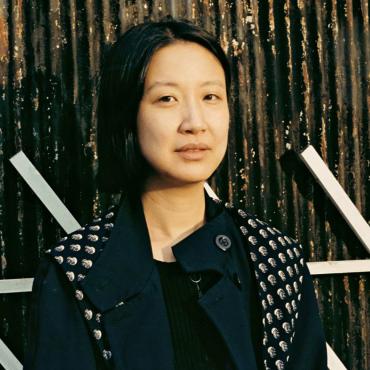

Lily Jue Sheng is a moving image artist working across film, animation, collage, text, performance, and 2D mixed media. They were born in Shanghai, China, raised in New Jersey, and studied at the School of the Museum of Fine Arts in Massachusetts. Their work has recently been presented by Mono No Aware and The Poetry Project in New York City. Their work has been shown locally, nationally, and internationally including at Roulette Intermedium, ArtBook @ MoMA PS1, the Knockdown Center, and Outpost Artist Resources in New York City; Light Field Festival in San Francisco, Images Festival, Winnipeg Underground Festival, and CineCycle in Canada; and TCAC (Taipei Contemporary Art Center) in Taiwan.
Fellowship Statement
I make films. I also make images, poetry, and other things, within the process of filmmaking, and occasionally perform them. My current work uses my own speech and writing to sort through the noise of language attrition, code-switching, and place attachment. This approach produces sort of patchy, quotidian, and sometimes unwatchable films. It's also the way I know how to tell stories. It’s this storytelling that becomes my breaking process, breaking up hegemonic cinema/narrative traditions, especially continuity, classification, and translation.
I have been researching semi-colonial Shanghai, in an effort to learn more about labor, trade, and changing regimes. I’m hoping to parse the archives by making new readings. I’m also looking to gather stories in Shanghainese, to overlap the pedestrian, political, private, and public spheres of Shanghainese. This will open a line of inquiries. Who or what determines when or which oral tradition continues? How do passages, people, and cinematic media move in tandem?
I also recently completed a collaborative film titled Ikebana that might screen sometime in 2021.
Photo by Mono No Aware
2019 Fellows
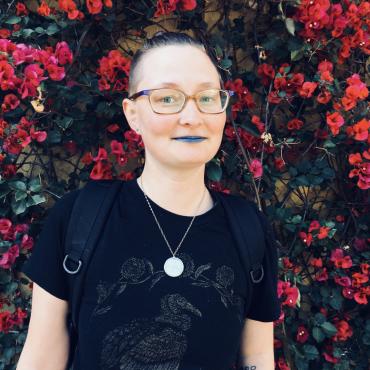

D. Allen (they/them) is a multidisciplinary poet and artist living in Minneapolis. Their first hybrid poetry collection, A Bony Framework for the Tangible Universe (The Operating System, 2019), weaves together poems, lyric essays, dictionary erasures, and images in response to the poet's diagnosis with a connective tissue disorder, asking: What holds us together when the body falls apart? D.’s writing has appeared in QDA: A Queer Disability Anthology, District Lit, Rogue Agent, Lockjaw Magazine, Black Warrior Review, and elsewhere. D. has recently received a Minnesota State Arts Board Artist Initiative Grant, an Emerging Artist Grant from VSA Minnesota, and a Minnesota Emerging Writers’ Grant from The Loft; they have been a resident at the Mallard Island Artist Residency, The Lighthouse Works, Write On Door County, the Andrews Forest, and the Atlantic Center for the Arts. D. earned an MFA in Creative Writing at the University of Minnesota in 2017.
Fellowship Statement
D.’s poetic practice is oriented around presence. Their work takes many forms: word architectures, light drawings, textured surfaces, slow dinners, layered sounds, sustained listening, temporary assemblages, quiet gardening, exploratory movements. Through their work across media and disciplines, D. navigates pain and illness, queer kinship, sex and intimacy, the natural world, and the realities of queer, genderqueer and disabled embodiment. Collaboration and relationship-building are vital to D.’s artistic life.
Currently, D. is developing their first full-length stage work using text, images, light, sound, movement, and large-scale handknit textiles with the support of a 2019 Q-Stage: New Works Fellowship from 20% Theatre Company. D. is also working on a collection of researched lyric essays, while pursuing new collaborations and smaller-scale experimental projects across disciplines.
Photo by poet Roy G. Guzmán.
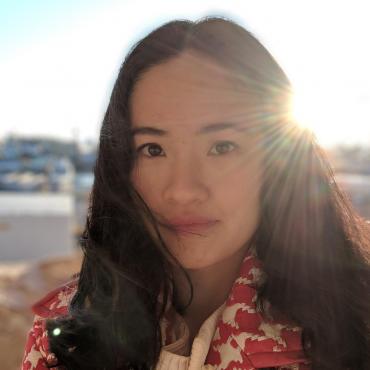

Chia-Lun Chang (she/her) was born and raised in New Taipei City, Taiwan. Her work appears in Literary Hub, PEN America, Hyperallergic, Bettering American Poetry Volume 2, Vinyl, Los Angeles Review of Books, Brooklyn Rail, and Bone Bouquet, among other publications. She’s the author of a chapbook, One Day We Become Whites (No, Dear/Small Anchor Press, 2016) and has been supported by fellowships from the Ministry of Education in Taiwan, the Brown-Tougaloo Partnership, Lower Manhattan Cultural Council, Tofte Lake Center, and Poets House.
Fellowship Statement
I came to the United States to continue my studies, earning a second bachelor’s degree in Fine Arts and a master’s degree in poetry. In these programs and through my work in the writing community, I have deepen my understanding of colonization, women’s rights, and patriotism. Even today, it is difficult to find authentic representations of Taiwan, written by ethnic minorities and native people. Seeking representation, I found two books which spoke to me—Notebook of a Return to the Native Land by Aimé Césaire and Dictée by Theresa Hak Kyung Cha. I admire Césaire for combining anger, violence, colors and temperatures. In Dictée, Cha uses the text as an extension of her body and demonstrates the possibility of developing one’s own multilingual, hybrid-genre voice. With Cha and Césaire as my guides, I have been working on a poetry memoir in which I grapple with the conflict and confusion of identity issues, the lost history of island residents, postwar survival, the causes of female oppression, and the act of speaking out. As a Jerome Hill Artist Fellow, I will expand my first chapbook, One Day We Become Whites, into a book-length project—a Taiwanese poetry memoir.
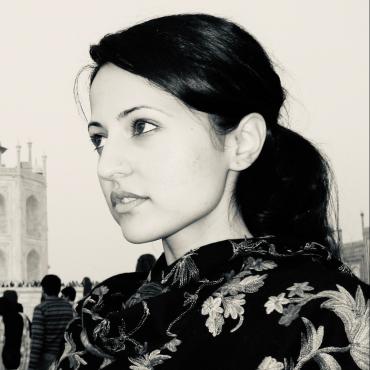

Pallavi Sharma Dixit (she/her) earned a Master of Fine Arts in creative writing from the University of Massachusetts Amherst. She is the recipient of a number of grants and fellowships and has taught creative writing at the Loft Literary Center. She lives in Minneapolis with her husband and two children and is at work on a novel.
Fellowship Statement
I was born in India and raised in Edison, New Jersey – a Little India in America – and this history informs all my writing.
When I earned degrees in history from the University of Pennsylvania I didn’t know how I would use them, but it turns out this is how: my fiction examines Indian immigration, Thomas Edison’s work ethic, anti-Indian racism, the evolution of Indian film, and the transformation of an American suburb into an ethnic enclave.
My novel-in-progress, Edison, deals also with romance, obsession, anxiety and the pressure of the American Dream. It is influenced both by the Bollywood movies and American sitcoms I grew up on. At every turn it bears the imprint of my life.
I try not to let my process be all agony; I find the humor and amuse myself. I like when movie stars unexpectedly enter my scenes. And I like em dashes so much.


t’ai freedom ford (she/her) is a New York City high school English teacher and Cave Canem Fellow. Her poetry, fiction, and essays have appeared in The African American Review, Apogee, Bomb Magazine, Calyx, Drunken Boat, Electric Literature, Gulf Coast, Kweli, Tin House, Obsidian, Poetry and others. Her work has also been featured in several anthologies including The BreakBeat Poets: New American Poetry in the Age of Hip-Hop and Nepantla: An Anthology Dedicated to Queer Poets of Color. Winner of the 2015 To the Lighthouse Poetry Prize, her first poetry collection, how to get over, is available from Red Hen Press. Her second poetry collection, & more black, is forthcoming Spring 2019 from Augury Books. t’ai lives and loves in Brooklyn where she is an editor at No, Dear Magazine.
Fellowship Statement
My writing grapples with all things related to my existence/non-existence in these United States. This means I'm obsessed with issues around (so-called) race (whiteness/ Blackness/otherness/mixedness), gender and sexuality (gender queering/querying, masculine-of-centering, closeted bisexual questioning), family/ancestral heritage (American/Black histories), pop culture (escapism via fantasy, public personas and invasion of privacy), and gentrification (desecration of sacred spaces, displacement, whiteness and entitlement, etc.) Currently, I'm working on a novel that explores how families and communities deal with grief and loss in the midst of gentrification. Also, I’m dreaming of ways to create multi-media works that amplify Black angst, Black joy and Black noise.
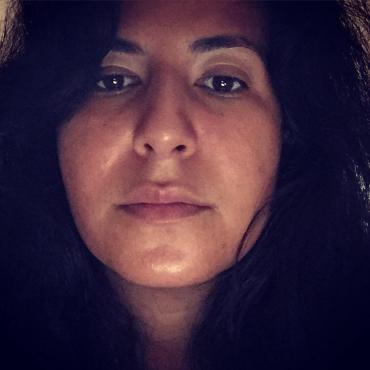

Marwa Helal is a poet and journalist. She is the author of Invasive species (Nightboat Books, 2019) and the winner of Bomb Magazine’s Biennial 2016 Poetry Contest. Helal has been awarded fellowships from Poets House, Brooklyn Poets, and Cave Canem. Born in Al Mansurah, Egypt, Helal currently lives in Brooklyn, New York. She received her MFA in creative nonfiction from The New School and her BA in journalism and international studies from Ohio Wesleyan University.
Fellowship Statement
My first full-length collection, Invasive species (Nightboat Books, 2019), is the launch pad for my next work: intimacy v. isolation, exploring the impact of migration, trauma, and technology on Erik Erikson’s Stages of Psychosocial Development.
I believe in my work's potential to disrupt old ideas and catalyze conversations that create solutions. Just as “poem to be read from right to left” created a robust discussion around colonial structures in the English language, my genre-defying narrative points directly to the inherent systemic abuse in the U.S. immigration system.
This fellowship will support me as creator and teacher. Emerging means forging a path from the margins into the center, where productive conversations around craft and genre intersect with necessary discussions around race, identity, nation-making, and immigration policy, while we continue to make room for new thought; solutions.
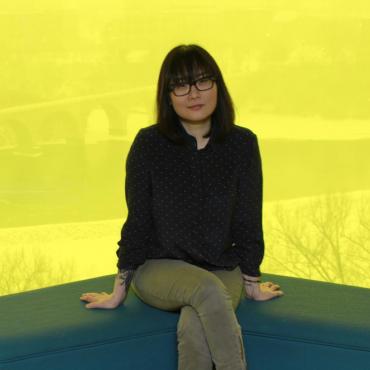

Su Hwang is a poet, activist, and the author of Bodega with Milkweed Editions, which received the 2020 Minnesota Book Award in poetry. Born in Seoul, Korea, she was raised in New York, then called the Bay Area home before transplanting to the Midwest. A recipient of the inaugural Jerome Hill Artist Fellowship in Literature, she teaches creative writing with the Minnesota Prison Writing Workshop and is the cofounder, with poet Sun Yung Shin, of Poetry Asylum. Su currently lives in Minneapolis.
Fellowship Statement
My creative practice is constantly evolving to keep pace with current events, but I also strive to acknowledge and bring to light the fraught, complex nature of our collective histories. Language is political, now more than ever––and I believe the act of writing poetry is a concrete form of resistance. My debut poetry collection BODEGA is forthcoming and I will start my second collection ROOST in earnest at Hedgebrook this summer—exploring madness, mass incarceration, and metaphors of containment. I will continue working with incarcerated writers and co-direct Poetry Asylum with poet/activist Sun Yung Shin. Our goal is to highlight and dismantle stereotypes as well as underscore concepts of invisibility in the visible, forced displacement, and transference of violence and discrimination. I aim to produce fearless work that advances my social justice goals through community building, collaboration, activism, advocacy, and open dialogue.
Photo by Jeffrey Forston Photography.
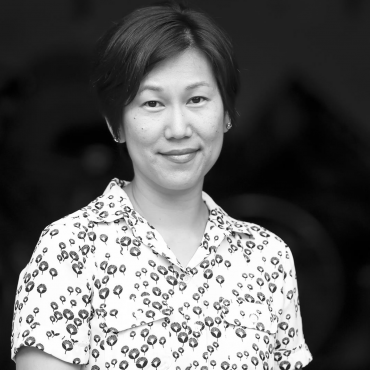

Born in Wonju, Republic of Korea and adopted to Oklahoma, Jennifer Kwon Dobbs (she/her) earned a MFA in poetry from the University of Pittsburgh and a PhD in literature and creative writing from the University of Southern California. She is the author of Paper Pavilion (White Pine Press Poetry Prize 2007), Interrogation Room (White Pine Press 2018), and the chapbooks Notes from a Missing Person (Essay Press 2015) and Necro Citizens (hochroth Bielefeld 2019, German-English editions). A recipient of grants from Intermedia Arts, Metropolitan Regional Arts Council, Minnesota State Arts Board among others, she is associate professor of creative writing and directs Race and Ethnic Studies at St. Olaf College. She lives in Saint Paul.
Fellowship Statement
Jennifer Kwon Dobbs is a transnational poet and scholar whose work confronts militarism and racial-gendered-class violence dividing kinships, selves, and imagination. Inspired by the Korean diaspora to which she belongs, she aspires to create alternative ways of feeling, knowing, and remembering to resist over sixty years of unending Korean War and its legacies. Her work has appeared previously in Agni, Blackbird, Columbia: A Journal of Art and Literature, Crazyhorse, Indiana Review, Jubilat, Korean Literature Now, Massachusetts Review, Poetry International, and elsewhere. Currently, Kwon Dobbs is developing a mixed-genre, multilingual book manuscript about white settler colonialisms and camptown kitsch in the digital age.
Photo by Thaiphy Phan-Quang.
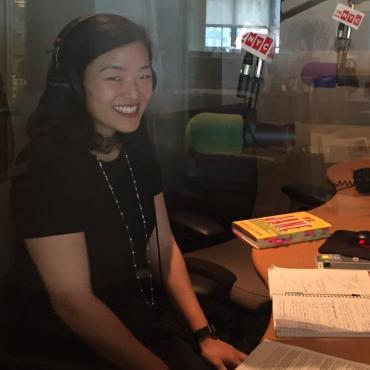

Patricia Park (she/her) is the author of the acclaimed novel Re Jane, a modern-day reimagining of Brontë’s Jane Eyre set in Queens. She has received fellowships from Fulbright, The Center for Fiction, American Association of University Women, and others. Her nonfiction has appeared in the New York Times, Guardian, Salon, and others. She is at work on a second novel which explores the Korean community in Argentina during the Dirty War. She is Assistant Professor of Creative Writing at American University. A native of Queens, she lives in Brooklyn.
Fellowship Statement
I write about minorities within minorities. I was born here but have family from Korea and Argentina. When I was growing up, mainstream America always lumped me into the “Asian” category. But ironically enough, within the Korean community in Queens, I didn’t always feel that I belonged. In my fiction, I challenge our assumptions of the “monolithic minority.” I give voice to anyone who has felt that same loneliness; to anyone who has similarly occupied a culturally confused space.
My first novel, Re Jane, is the story of a mixed-race Korean American orphan from Queens that uses Charlotte Brontë’s Jane Eyre as a loose template to raise questions of identity and “homeland.” My second novel-in-progress, El Chino: A Novel in Four Movements, is about a boy named Juan Kim who falls in love with jazz, and the music becomes his freedom of expression during the backdrop of the Argentine Dirty War.


Preeti Kaur Rajpal (she/her) is a poet and nonfiction writer. She first began writing as a student of June Jordan in her “Poetry for the People” program. Preeti’s work can be found in The Sikh Review, qarrtsiluni, Memoir Journal’s I Speak From My Palms Anthology, American Public Media’s On Being Blog, Spook Mag, Jaggery Lit, Blueshift Journal, Tupelo Quarterly, Popula, Lantern Review, and others. She is a recent Loft Literary Mentor Series Poetry Fellow, Voices of Our Nations Arts Fellow, Poetry Foundation’s Poetry Incubator Fellow, and Writing By Writers Fellow.
Fellowship Statement
I am working on my first collection of poems, tentatively titled O! How We Escaped! My poems explore issues of colonialism, post-colonialism, immigrant status in the US, patriarchy, post-9/11 Islamophobia specific to the effects on Sikhs in the US, human rights issues in India, India’s Partition, my family’s journey as refugees during that time, and my understanding of Sikh philosophy.
Photo by Anna Min.
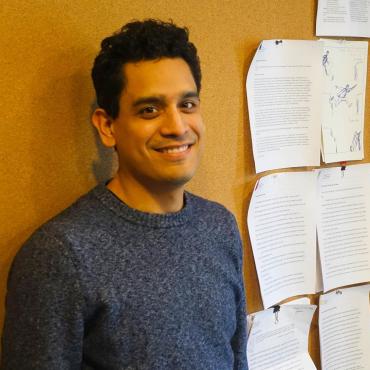

Alejandro Varela (he/him) is a writer based in New York. His work has appeared or is forthcoming in the New Republic, the Southampton Review, Pariahs (an anthology, SFA Press, 2016), Blunderbuss Magazine, the Offing, Brooklyn Rail, Joyland Magazine, the Scholar and Feminist Online, the Rumpus, and has received honorable mention from Glimmer Train Press. He was a 2017 NYSCA/NYFA Artist Fellow in Nonfiction, and a resident in the Lower Manhattan Cultural Council’s 2017–2018 Workspace program. He is also an associate editor at Apogee Journal. Alejandro holds a master's degree in Public Health from the University of Washington, Seattle. Prior to his writing career, he managed cancer-screening studies, designed HIV/AIDS health worker curriculum, and taught public health advocacy.
Fellowship Statement
I write about the complexities of class-jumping. I see strength within community, and solidarity across communities, as health intervention. I draw from public health research on stress and inequity to craft tales that paint a way forward. My hope is for readers to finish my stories and think, “Reparations for the descendants of slaves, of course!” Or “A minimum wage of $30 per hour (pegged to inflation), duh!” But I also want my writing to make people ask themselves: “How do Ben Affleck and George Clooney each have Oscars while Alfre Woodard has only been nominated once... 35 years ago?”
I’m currently finishing a collection of short stories, and I'm working on a novel about a man who returns home to care for his parents. Several of his high school friends also struggle to survive. He traces the roots of their poor health to the isolation of their formative years.
Photo by Charly Debrosse © LMCC.
2021 Fellows


Catina Bacote grew up in New Haven, Connecticut. Her nonfiction has appeared in Tin House, Ploughshares, Kweli, Gettysburg Review, Gulf Coast, TriQuarterly, The Common, Prairie Schooner, December Magazine, Southern California Review, and in the anthology, This Is the Place: Women Writing About Home. Her work has been supported by residencies at Hedgebrook, Headlands Center for the Arts, The Millay Colony, Willapa Bay AiR, the Djerassi Resident Artist Program, Brush Creek Foundation for the Arts, the MacDowell Colony where she received the Ann Cox Chambers Long-form Journalism Fellowship, and the Ragdale Foundation where she received the Alice Judson Hayes Social Justice Fellowship. Bacote holds an MFA from the University of Iowa, where she was admitted as a Dean’s Graduate Research Fellow and subsequently served as the Provost’s Visiting Writer in Nonfiction. Currently, she is an assistant professor of creative writing at St. John’s University in Queens, New York.
Fellowship Statement
I am interested in how the writer’s voice acts as an ethical pointer in a world where poverty and excessive wealth, political repression, gun violence, racial segregation, and mass incarceration persist. My nonfiction writing depends on collecting personal testimony and attempts to uncover intimate stories that have not been told or retell those distorted by the realms of politics or entertainment. However, some tales feel dangerous to share because even the people they touch have kept silent. But as an artist, I aspire to step into uncharted territory and gently bring others along with me. I engage in this work not as a distant observer or objective researcher but as a Black woman whose life has been shaped by racial and economic injustice. Presently, I am working on my first book-in-progress, Eastern Circle, which chronicles the lasting impact of the illegal drug trade on my family and community.


Lexie Bean (they/he) is a queer and trans multimedia artist whose work revolves around themes of bodies, homes, cyclical violence, and LGBTQIA+ identities. They're a member of the RAINN National Leadership Council and a Lambda Literary Award Finalist for Written On The Body, centering fellow trans survivors of domestic and sexual abuse, and served as a keynote speaker for MaleSurvivor and universities around the United States. Their experimental and animated short films, Full, Trans Boy Remember, and The Ship We Built, which later became an #OwnVoices, Kirkus Starred novel with Penguin Random House and a feature-length film script, have played in festivals globally. Their latest writing, A Scavenger Hunt For People Loneliest In Their Own Homes, was commissioned by Price Hill Will. Their work has been featured in Teen Vogue, the New York Times, Huffington Post, Feminist Wire, Ms. Magazine, Them, Logo’s New Now Next, Bust Magazine, Autostraddle, and more. www.lexiebean.com
Fellowship Statement
I’m interested in creating for those who blame themselves for falling into the same mistakes again and again; people who can't hold their own bodies. I want to create for those struggling with shame, developing new vocabularies, and forming families; people who are afraid of change. Queer folks surviving the Midwest, where I'm from. I’m interested in developing narratives where there is danger in forgetting, and remind us all that there is resilience in imagination.
I am currently working on several personal projects relating to these themes: a television pilot, Flyovers; my first Young Adult novel, All My Good Memories Of That House Were With You; my first auto-fiction novel for adults, Across From You; continued building and collaboration for the screenplay version of my debut novel, The Ship We Built; as well as collaborative pieces, like What Will I Become?, through documentary and anthology curation.
Photo by Llewellyn Nuñez
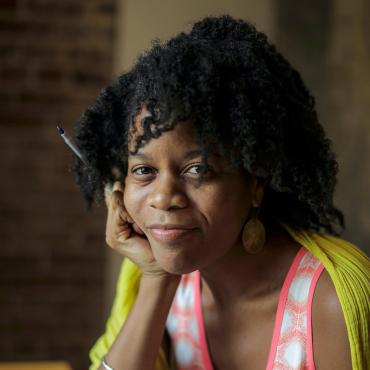

Ama Codjoe (she/her) is the author of Blood of the Air (Northwestern University Press, 2020), winner of the Drinking Gourd Chapbook Poetry Prize and Bluest Nude forthcoming from Milkweed Editions in Fall 2022. Her work has been awarded support from Cave Canem, Jerome, Robert Rauschenberg, and Saltonstall foundations, as well as from Callaloo Creative Writing Workshop, Crosstown Arts, Hedgebrook, and MacDowell. Among other honors, Codjoe is the recipient of a 2017 Rona Jaffe Writer’s Award, a 2019 NEA Creative Writing Fellowship, a 2020 BRIO Award from the Bronx Council on the Arts, and a 2020 NYSCA/NYFA Artist Fellowship.
Fellowship Statement
I want to continue to learn about the world and about myself through the practice of poetry in the hopes of making true for myself and others Adrienne Rich’s lines from Dreamwood: “that poetry/ isn’t revolution but a way of knowing/ why it must come.” I want to be led into poems by color, music, serendipity, research and travel. Currently, I am revising and shaping my first full-length collection Bluest Nude.
Photo by Jamie Harmon
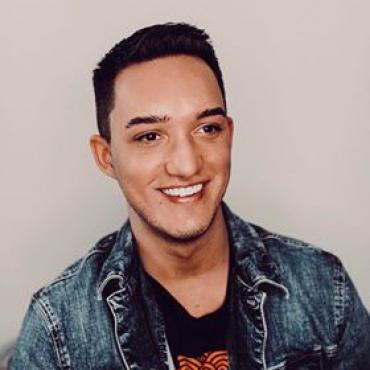

Carson Faust is a queer writer, and an enrolled member of the Edisto Natchez-Kusso Tribe of South Carolina. His writing has received support from the Tin House Writers’ Workshops as well as the Minnesota State Arts Board, and has appeared or is forthcoming in TriQuarterly, Waxwing, AnomalyJournal, Passages North, Foglifter Journal, and elsewhere. He serves as a board member for 826 MSP—a nonprofit organization that provides literacy- and creative writing-based programming for underserved K-12 students in the Twin Cities area. He is represented by Annie Hwang of Ayesha Pande Literary.
Fellowship Statement
My novel-in-progress—A Bible Or A Knife—utilizes the genre of horror to grapple with the ways in which Indigenous and queer identities are represented, misrepresented, or erased within the canon. Canonically, queer folks and people of color are often confined to antagonistic or secondary roles; Native American stories and histories are used as tools and backdrops within horror narratives. My work aims to turn these banalities on their heads: When Indigenous people maintain their hold on and connection to their homeland, how might the lingering shadow of colonialism persist? What does it look like when land is haunted by the colonizers who failed to remove Native American communities?
Photo by Laura Rae Photography


Sherrie Fernandez-Williams earned an MFA from Hamline University. She is the author of Soft: A Memoir and is a recipient of a Minnesota State Arts Board Artist Initiative Grant, a Beyond the Pure Fellowship, and SASE/Jerome Grant. She was a Loft Mentor Series winner in Creative Nonfiction, a Jones’ Playwright Commission Award Winner, and was selected for the Givens Black Writers Collaborative. Her poems and essays appear in New Limestone Review, Aquifer: The Florida Review, the minnesota review, Rain Taxi’s-Can’t Stop Won’t Stop: Poems in the Wake of Racial Justice, and the anthology, How Dare We! Write, among others. She co-curates the Queer Voices Reading Series with writer and performer Lisa Marie Brimmer in collaboration with Quatrefoil Library and Hennepin County Library.
Fellowship Statement
There were glimmers of hope at the start of the 20th century for my Afro-Cubans ancestors who worked in the cigar factories in Hillsborough County, Florida and lived in planned communities designed to stabilize the lives of workers who created enormous wealth for the factory owners. There was a lot to negotiate. They were black men and women in the south experiencing the horrors of that time, and they were sometimes welcomed and sometimes unwelcomed members of the Cuban community. My fellowship goal is to complete my work in progress, Here Before, a hybrid of prose and poetry. I am a descendant of enslaved Africans brought to Barbados and Cuba, and the southern states of Georgia and North Carolina. I want to resurrect my dead and have them tell a truth beyond prolonged disenfranchisement, especially as it relates to their spiritual lives.
Photo by Anna Min, Min Enterprises Photography, LLC
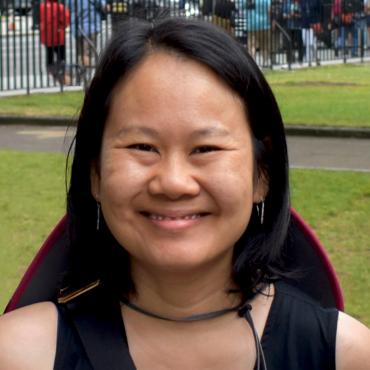

Susanna Horng is a Taiwanese-American writer, educator, mother, and activist. Her work has been supported by a 2018 NYSCA/NYFA Artist Fellowship in Fiction from The New York Foundation for the Arts and the Virginia Center for the Creative Arts. Her writing has been published in Bennington Review, Minerva Rising, and Global City Review. She is a teaching artist for Girls Write Now and a Clinical Associate Professor in Liberal Studies at New York University. She lives with her family in New York City.
Fellowship Statement
I write about the silence of being a woman from a patriarchal culture, the silence of being a woman of color navigating white spaces, the silence of being a mother and caretaker on the second shift.
I care about word play, multilingualism, and language. How multiple or misunderstood meanings of the same word(s) trigger deeper emotional truths. What gets voiced. What gets sacrificed. The costs of trying and failing to communicate.
I am finishing a collection of linked stories that examines the success and failures of the American Dream, the sorrows of living in one of the largest Chinese diasporas, and the loneliness of being the perpetual outsider. I am also working on a novel about privilege, class, and equity.
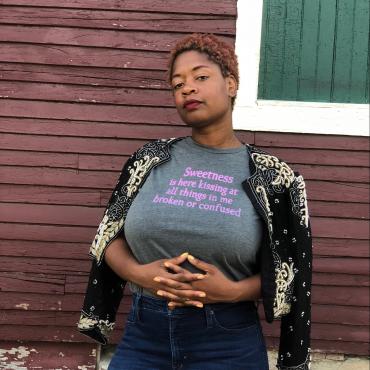

Junauda Petrus-Nasah is a writer, a soul sweetener, runaway witch, and multi-dimensional performance artist of Black-Caribbean descent, born and working on Dakota land in Minneapolis. She employs poetics, the erotic, and experiences re-membered via ancestral dreaming within her writing. She’s written for the stage, including the aerial-poetic-play, There Are Other Worlds and co-wrote the puppet show, Queen with Erik Ehn. She wrote and directed, Sweetness of Wild, an experimental, episodic film project inspired by wildness, queerness, Black-diasporic-futurism, ancestral healing, sweetness, shimmer and liberation. She is the co-founder of performance collective Free Black Dirt with Erin Sharkey. Her writing can be found in several anthologies, including Queer Voices, How I Resist and Pleasure Activism. Her first YA novel, The Stars and The Blackness Between Them received a Coretta Scott King Honor Award and was a Minnesota Book Award Finalist. She is currently writing her second young adult novel, Black Circus.
Fellowship Statement
For my fellowship, I’ll center on healing and balance as an artist. I’ll get professional career counseling, as well as take more walks, rest and reflect. I will spend intentional time researching Black and queer ancestors of my artistic lineage. I’ll spend time connecting with my artistic mentors, including Alexis DeVeaux and Sharon Bridgeforth. I’ll be writing, researching and editing new books including a young adult book, Black Circus, set in the 90s about a young, Black woman studying aerial acrobatic arts with a mysterious and mystical former circus performer. I’ll work on a collection of poetry, pum pum, as well as an experimental interdisciplinary work called Erotics of Abolition.
Photo by Ngowo Nasah
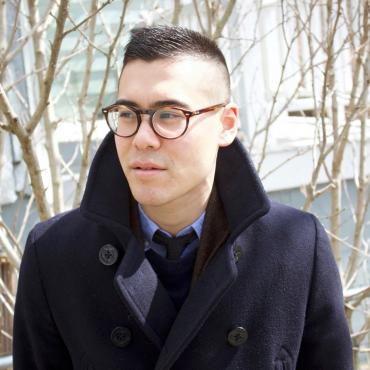

Michael Prior (he/him) is a writer and a teacher. His poems have appeared or are forthcoming in The New Republic, Poetry, Narrative Magazine, Poetry Northwest, Poetry Daily, the Academy of American Poets’ Poem-A-Day series, Global Poetry Anthology (2015 and 2020), and the Asian American Writers’ Workshop’s The Margins. He is the recipient of awards and fellowships from The Sewanee Review, Magma Poetry, Hawthornden Castle International Retreat for Writers, and the Banff Centre for the Arts. He is the author of Burning Province (McClelland & Stewart / Penguin Random House, 2020) and Model Disciple (Véhicule Press, 2016). Michael holds an MFA from Cornell University. He lives in Saint Paul, where he teaches English and creative writing at Macalester College.
Fellowship Statement
As a Yonsei, whose Japanese grandparents were forcibly incarcerated in a camp during the Second World War, my poems explore intergenerational memory, cultural trauma, diaspora, and my own mixed-race identity. My engagement with the lyric often encompasses the ways various verse forms might be reimagined to express my own experience and to attend to conversations about race in North America. I am currently at work on a manuscript of ekphrastic responses to Japanese American and Japanese Canadian visual artists whose work either documents or re-witnesses the Internment.
Photo by Rocio Anica
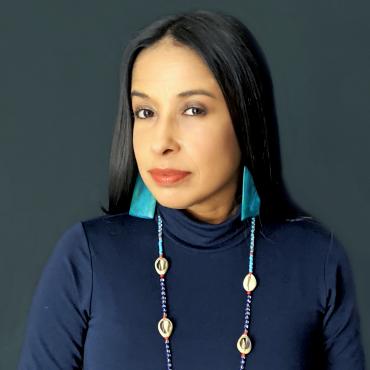

Peggy Robles-Alvarado is a Dominican and Puerto Rican Pushcart Prize nominee, 2020 Atticus Review Poetry Contest winner, and a BRIO award winner with fellowships from CantoMundo, Desert Nights Rising Stars, The Frost Place, and VONA. With degrees in education and an MFA in Performance Studies this former teen mother, and initiated priestess in Lukumi and Palo celebrates womanhood and honors cultural rituals. She’s a three-time International Latino Book Award winner who authored Conversations With My Skin (2011), and Homage To The Warrior Women (2012). Through Robleswrites Productions, she created The Abuela Stories Project (2016) and Mujeres, The Magic, The Movement, and The Muse (2017). Her work has been featured on HBO Habla Women, Lincoln Center, and her poetry appears in several anthologies including The Breakbeat Poets Vol. 4: LatiNext (2020), and What Saves Us: Poems of Empathy and Outrage in the Age of Trump (2019). For more visit Robleswrites.com.
Fellowship Statement
My poetry honors and questions cultural norms, rituals, and the use of Spanglish and Caribbean slang as valuable forms of communication, and language production rooted in oral tradition. My work celebrates women who don’t break but gracefully stretch through emotional, physical, and socio-economic struggles. With humor, heartbreak, hand me down rituals, and speakeasy belief systems that coax Afro-Cuban deities into clandestine gatherings, problems are handled, and communities are sustained. My work embraces the possibility of repair as related to the body and mind of a people marred by imagined and perceived borders resulting from forced immigration, colonization, displacement, and how spiritual practices involving water and words foster survival. These themes derive from my experiences as a rape survivor, teen mother, initiated priestess in Lukumi and Palo Afro- Caribbean spiritual systems, and a daughter of Dominican and Puerto Rican parents whose footing in America was never secure.
Photo by Jorge Alvarado
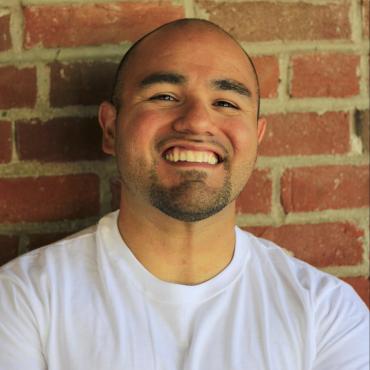

Michael Torres was born and brought up in Pomona, California where he spent his adolescence as a graffiti artist. His debut collection of poems, An Incomplete List of Names (Beacon Press, 2020) was selected by Raquel Salas Rivera for the National Poetry Series and named one of NPR’s Best Books of 2020. His honors include awards and support from the National Endowment for the Arts, the McKnight Foundation, the Bread Loaf Writers’ Conference, CantoMundo, VONA Voices, the Minnesota State Arts Board, the Jerome Foundation, the Camargo Foundation, and the Loft Literary Center. Currently he’s an Assistant Professor in the MFA program at Minnesota State University, Mankato, and a teaching artist with the Minnesota Prison Writing Workshop. Visit him at: michaeltorreswriter.com
Fellowship Statement
My writing often focuses on masculinity through a Mexican-American cultural lens. Currently, I’m fascinated by the idea of capacity, and the capaciousness of art in relation to my own self as brown man in America. Moreover, I’m interested in where this fascination with capacity is rooted.
Since the publication of An Incomplete List of Names, I’ve been working on poems and creative nonfiction prose. The poems approach capacity by way of the metaphysical. The nonfiction work seeks to explore capacity through how I understand my own brown body in its various roles—as father, husband, brother, son, homie, colleague—as I move through life in the Midwest, as I exist in academia, as I consider pop culture, and when I visit California, leaning back in the passenger seat of my homie’s Cutlass—windows rolled down, my right arm hanging out the window.
Photo by Henry Jimenez
2019 Fellows
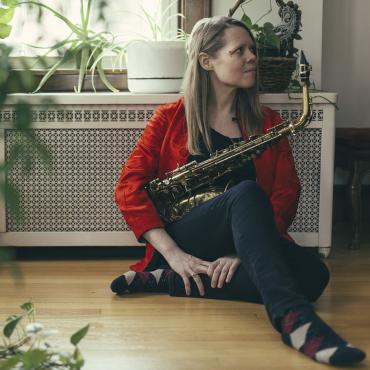

Mobile since her birth in Singapore, composer, and saxophonist Caroline Davis (she/her) lives in Brooklyn, New York. Her debut album, Live Work & Play, was featured on All About Jazz’s best releases, and she was named one of JazzTimes’ Best New Artists in 2012. Her second album, Doors: Chicago Storylines, is an audio documentary that uniquely sets stories from Chicago's jazz scene from the 80s and 90s alongside her original music. In 2018, she won the Downbeat Critic’s Poll “rising star” in the alto saxophone category. Caroline’s third album, Heart Tonic, was released on Sunnyside Records to much acclaim in NPR, the New York Times, and DownBeat. Davis’ self-titled Alula, featuring Matt Mitchell and Greg Saunier, will be released on New Amsterdam Records in May of 2019.
She has shared musical moments with a diverse group of musicians, from jazz to improvised and composed music, recently including Matt Wilson, Lee Konitz, Angelica Sanchez, Matt Mitchell, and Billy Kaye. Her regular collaborations include Maitri, Whirlpool, and Persona (with Rob Clearfield). She has participated in several mentorship programs, including the International Association for Jazz Education’s Sisters in Jazz and the Kennedy Center’s Betty Carter Jazz Ahead. In March of 2019, she will be a composer-in-residence at the MacDowell Colony to write a set of new works based on the electrical activity of neurons in the brain.
Fellowship Statement
For all my projects, I take care to design the music, hire the right performers, and work towards a message. My process involves reading articles, scribble stream-of-consciousness notes about the compositional tools, shape, and forms of each piece, and sitting down to write. For Heart Tonic, I focused on various types of arrhythmia to write the music after seeking out recordings of irregular heartbeats and speaking with patients who have this condition.
In May, I’m releasing an album of trio music (alto saxophone, synthesizers, drums) that was written in response to the vortex generator structure on most birds. I have developed a keen interest in the movements of birds, especially patterns of takeoff, flight, and landing, and the way the alula structure affects them. This work is continuing at a deeper level for the next album, which I am writing music for now.
In the immediate future, I intend to immerse myself in the study of neuron function in the brain and to improve my ability to hear/perform complex rhythms. My interest in the first topic developed when I received my PhD in Music Cognition in 2010. I want to understand how neuronal networks communicate, especially with respect to timing and motion, and develop music based on my findings. For the latter, I have been taking classes at Chhandayan Center on Indian systems of tonality and rhythm. With the help of the Jerome fellowship, I’ll be able to take private lessons and improve my abilities.
Photo by Jacob Hand.
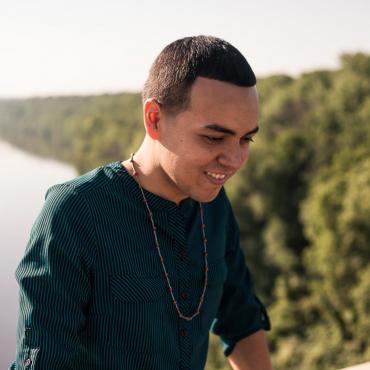

Rafael Gonzalez (he/him), better known by his stage name Tufawon (2 for 1), is a Dakota/Puerto Rican hip hop artist/activist from Minneapolis. His name represents his mixed identity. He has traveled the world through the intersection of music and fighting for social causes. He was recently interviewed on The Breakfast Club and Hot 97 promoting Indigenous People's March in DC, and he performed at the official concert. In the fall of 2018, he completed his first headlining hip hop tour in Europe with Nataanii Means and Michel Be called “Resilience.” In January 2019, he went to Cuba through Minneapolis based nonprofit US Cuba Artist Exchange with a delegation of music producers from the states to collaborate with pioneering Cuban hip hop artists. They performed at a showcase and created two collaborative songs. Tufawon has released 4 EPs: Self Care, The Homecoming, The Send Off, and Schwag.
Fellowship Statement
With hip hop being the foundation, my music is an honest reflection of my life experiences and personal struggles/growth, my hopes and dreams for the future, spirituality and connectedness to the land, love, and the realities of the world we live in. My style is an embodiment of intricate lyricism with complex vocabulary balanced by a very clear, smooth, and concise delivery. With a socially aware approach, I touch on topics such as Indigenous resiliency, politics, health, defending Mother Earth, and fighting against oppressive systems. The underlying message in my music is always connected to freedom—the continual transformation I am experiencing is profound. You can hear it with earlier works like Schwag, where there is a bit of an egotistical and raunchy element. Compare that with later releases like The Homecoming or Self Care where themes of fighting for freedom and unlearning/denouncing patriarchy are common, you see the contrast and ultimately, the growth and transformation. I aspire to bring the vibrations of his ancestral roots into his future music projects, fusing them with contemporary production styles.
Photo by Tommy Ellis.


Stylistic polyglot deVon Russell Gray’s (he/him) compositions evoke soulful meditations, the envelopment of anxiety in a nurturing sonic cocoon. As a new music performer and mood scholar, he channels celestial fascination manifested in aural familiarity. deVon intuits through clairaudience a direct connection to our collective musical legacy, as guided by Bach, Beethoven, Threadgill, and Mumford.
Born and raised in the Rondo Neighborhood, the composer is a member of Saint Paul’s hip hop stalwarts HEIRUSPECS, celebrating twenty-two years of music-making and hometown-repping, as well as a decade of funding scholarships at their alma mater Saint Paul Central High School.
deVon is an omnipresence with bands, artists, scholars, and other creators. In addition, he touts music direction for new theater (Sandbox Theater’s Queens), Afrofuturistic interdisciplinary works (Joe Horton’s A Hill in Natchez), and visiting artist residencies (Cedar Cultural Center’s Midnimo Residency Program). In 2016, the Cedar Cultural Center awarded deVon funds from the Jerome Foundation to create a work for a quartet of violas and cellos plus electronics called Fractious Child, Op. 1 No. 1. In 2017, he became a McKnight Foundation fellowship recipient.
Fellowship Statement
The novelist Annie Dillard says, “How can you as a writer expect to create extraordinary work on what is likely an ordinary Tuesday?” I don’t know, yet that’s who I am. A seeker of the extraordinary. What I know, is that revelations and epiphanies come when they’re needed, no sooner.
I’ll use my skills. I will continue to create artful music that allows listeners to dream, to feel rooted, and to access the cosmos. In my art and life I aspire to achieve a level of clarity that allows me to answer simply simple questions such as, “Who are you as an artist and what do you aspire to do in your work?” Truthfully, I’m a pretty heady composer that’s always trying to dress it down. Ultimately it’s the blues. Earthy, music of the dirt. Comprised of basic elements. I will continue to keep a keen eye on my mentors where joy and mental health are concerned. This work can take its toll.
Presently and for a while now, I’ve been dreaming up an opera.
Photo by Katie Mae Dickinson.
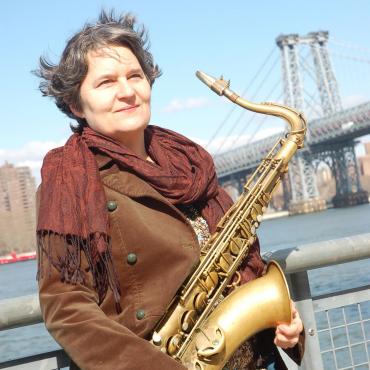

Jessica Jones (she/her) leads the pianoless group, the Jessica Jones Quartet, which features her original music and has several critically acclaimed recordings. The group has played festivals and major clubs on the East and West Coasts of the U.S. In addition, Ms. Jones is active as a sideman and has worked with Joseph Jarman, Cecil Taylor, and Don Cherry as well as a variety of Haitian, Caribbean, and African bands. She composed an opera with poet Arisa White, as well as a varied body of additional compositional work. Jones is an innovative jazz educator and consultant, working with children on improvisation, composition, and oral traditions for Jazz at Lincoln Center, Stanford Jazz Workshop, the Vision Festival, Brooklyn Friends School, and others. Currently, Jones is an Artistic Director for REVA, Inc, a non-profit created to use creative arts to inspire, educate and heal people and communities.
Fellowship Statement
I play tenor saxophone and compose. My primary body of work is for my two-tenor saxophone, pianoless jazz quartets. I write for the strengths of the band, creating frameworks for free improvisation. This celebration of diversity represents my deep belief in listening for the strengths of individuals as a key to stronger unity. Voices are a strong influence on my compositions, which often incorporate spoken or sung music, or lines that are phrased based on speech patterns. I am currently working on a “poetry opera” with poet Arisa White, as well as continuing to expand my compositions for vocalists in a jazz context, and continually developing repertoire and rapport with my Quartet. I continue to study deeply in the jazz tradition, mining the great jazz improvisers and composers to strengthen my skills as a player and composer.
Photo by Cheryl Richards.
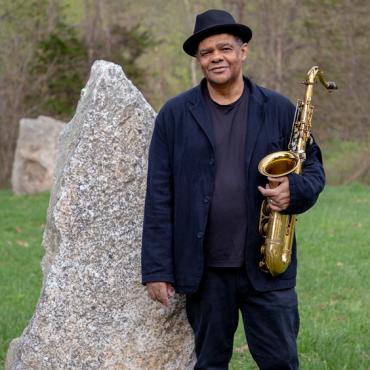

Anthony Jones (he/him) grew up in a hotbed of jazz education in Berkeley California where he was steeped in music at home and trained in some of the earliest jazz education programs in the nation, including Berkeley High School and UC Berkeley’s Young Musicians Program. While still in high school, Jones was part of an innovative cooperative quartet that performed bold experimental music around the Bay Area and on an East Coast tour where they were exposed to the still thriving loft jazz scene. Jones co-founded the Jessica Jones Quartet and the Pitch, Rhythm and Consciousness Trio and subsequent configurations with Charlie Burnham; both groups record and perform extensively. He has appeared as sideman with Don Cherry, Muhal Richard Abrams, Peter Apfelbaum, and Joseph Jarman, among others, including in national and international jazz festivals.
Fellowship Statement
There is a natural geometry and architecture to my hearing that I try to explore and reveal through my improvisation and composition. The use of contemplative silence and restrained placement by the musicians is the kind of language I am developing with my band as a unit, and what I am exploring in my compositional direction. My compositions and playing call on all aspects of the African-American music continuum, including the intersection of free improvised music with R&B and jazz. The resulting music has an exploratory, modern searching bent. The current focus of my work consists of the use of certain musical phrases, gestures, and forms from, but not limited to, this music. I seek to develop this both as a composer and a player, in different ensembles but with a particular focus on Pitch, Rhythm and Consciousness.
Photo by Marc Greene.
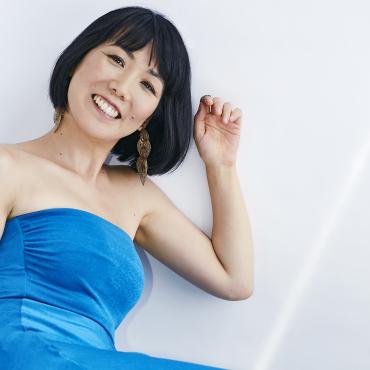

Composer/Pianist/Producer Migiwa Miyajima’s (she/her) career path began on a very different trajectory from composing music—she worked as a director of real estate ads, an IT engineer, and an editor-in-chief of a travel magazine in Tokyo. But in 2004, at the age of 30, she decided to become a musician. Five years later, the Vanguard Jazz Orchestra, a historic New York-based ensemble, invited her to join their team. She was the associate producer for two Grammy Award-nominated albums by the orchestra in 2011 and 2014. In 2012, having received a Japanese government scholarship as a composer and a Japan-US Friendship Commission Fellowship, Migiwa made her move to New York. Her ensemble Miggy Augmented Orchestra’s debut album Colorful was released by ArtistShare in 2018. She is one of the recipients of the 2020 New York City’s NYC Women’s Fund For Media, Music and Theatre.
Fellowship Statement
Experiencing the massive 2011 earthquake in Japan transformed my approach to my life’s work as a composer. I witnessed the inconceivable ability music has to speak to us as a people during chaotic times. Since then, I am most interested in music as a language that speaks to our emotions directly. After moving to the United States and seeing fear and lack of happiness turned into hatred and division, it feels that this is the time for me as a composer/musician to cultivate what I learned in Japan. In my upcoming project, I am practicing how to make my music work on fear or insecurity and how to cultivate positive energy through it. I am delighted to be inspired by this amazing community while I am tackling this profound theme.
Photo by Hayato Sakurai.
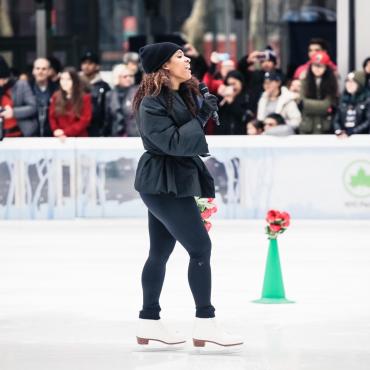

Alicia Hall Moran’s (she/her) critically-acclaimed albums (Heavy Blue, Here Today) embrace Opera, Soul, Jazz, Theatre, and Visual Art. Shows/explorations include “the motown project”; “Black Wall Street: Tulsa Race Riot of 1921”; and “Breaking Ice: Battle of the Carmens.” Further collaborations live inside the artworks of Carrie Mae Weems, Adam Pendleton, Joan Jonas, Bill T. Jones/Arnie Zane Dance Company, Simone Leigh/Liz Magic Laser, Carl Hancock Rux, and Ragnar Kjartansson, and are exhibited worldwide.
Residencies/commissions include Isabella Stewart Gardner Museum, National Sawdust, MoMA, ArtPublic, Brooklyn Youth Chorus, The Kitchen, and River to River. Her contemporary sensibilities were tapped for Broadway’s Tony-winning Porgy and Bess, starring as Bess on National Tour. Her artistry with husband/pianist Jason Moran has yielded Bleed/Whitney Biennial, Work Songs/Venice Biennial, Two Wings: Music of Black America In Migration/Carnegie Hall; and the Ford Foundation’s Art of Change fellowship. Ongoing, Alicia balances composition with solo vocalism in symphonic works: through 2020 in Gabriel Kahane’s emergency shelter intake form and Bryce Dessner’s Triptych.
Fellowship Statement
As a mezzo-soprano and composer, my sense of harmony, evidenced in film, recorded output and stage performances, both entices and subdues established notions of Performer and Performance. Profound historical divisions are the jump-off points for my previous musical investigations. Class difference in the review and catalogue of Black Music is another interest. My practice is non-hierarchical and plainly observes the music of the West.
In my forays, textual and sonic, Voice itself is an embodiment. My aim has been to find a new harmony inside of my work between Performance, Performer, and Practice. The Jerome Fellowship enables deeper exploration of venues previously off limits, collaborations too impractical to previously entertain, and visual realms that were technically unavailable. Traveling to Natural settings will sharpen specificity in my work. I will re-engage my recent work on ice to continue the investigation: metaphors for expressions of fragility and civility in critically trying Times.
Photo by Charles Roussel/Prototype Festival.


Walken Schweigert (he/him) is a performer, composer and director from Saint Paul, MN. He is the founder and artistic director of Open Flame Theatre, an all queer/trans ensemble that creates surrealist and queer-centered work. Walken is a 2009 graduate of the Dell’ Arte International School for Physical Theatre, and a 2006 graduate of the Perpich Center for Arts Education (Theatre Major). He has worked with the Taller Xuchialt and Ronda de Barro in Leon, Nicaragua; toured with and been mentored by the internationally renowned Double Edge Theatre in Ashfield, MA; and has busked on the streets of 11 countries. A classically trained violinist, he has been part of over a dozen musical ensembles of varying genres, from klezmer to metal. Walken was recently the recipient of a JFund award from the Jerome Foundation via the American Composers’ Forum for the composition of his second opera, The Garden, to be produced by Open Flame Theatre and Philadelphia Community Farm.
Fellowship Statement
I see my role as an artist as someone who crosses, transgresses and thrives in between boundaries. My mission is to create original, multi-disciplinary performances rooted in the queer/trans experience. Through exploring the surreal and fantastic, I seek to liberate the imagination which I recognize as a vital part of the larger struggle for justice and freedom.
What is the relationship between ritual and performance? Between song and story? How do we celebrate together? How do we grieve together? How can we harness the power of story and song to liberate our imaginations and expand our creative potential? What new traditions/rituals/rites of passage can we make for and with each other that affirm and express who we truly are? This is what I hope to explore in my fellowship. I hope at the end of it I will have made an honest contribution to a transforming cultural fabric.
Photo by Connie Chang.
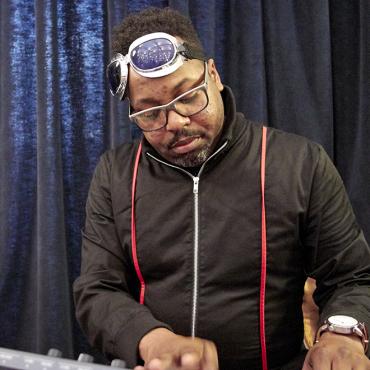

Dameun Maurice Strange (he/him) is a sound artist, multi-instrumentalist, and award-winning composer whose conceptual chamber works, choral pieces and operas are focused on stories of the African diaspora, often exploring Afrofuturist themes. In 2011, he partnered with award-winning choreographer Erinn Liebhard to present Railing Forward, a suite inspired by the legend of John Henry. The following year he was commissioned by the contemporary dance ensemble Alternative Motion Project to compose music for their premier program, Prometheus, Fire bringer and Lost in My Mind. This relationship would last 5 years and include NTimeBeautyN, HeartBeatRed, Penumbra|Corona.
In 2013, Dameun presented his first composition recital of new works, New Constellations at the Baroque Room in Saint Paul. In 2015 he presented his third composition recital which featured a cantata for Chamber Choir, Poet and Soprano, Resonant Frequencies: Love and Revolution. Strange was awarded the Minnesota Emerging Composers Award by the American Composers Forum in 2015 which led to the development his first opera, Mother King.
Fellowship Statement
I am a sound artist, multi-instrumentalist whose conceptual chamber works, choral pieces and operas are focused on stories of the African diaspora, often exploring Afrofuturist themes. I am compelled to express through sound and poetry, the beauty and resilience of the Black experience, digging into a pantheon of ancestors to tell stories of triumph, while connecting the past, present, and future. While my sound experiments have many dimensions, I use West African polyrhythms, with classical music forms, contemporary jazz harmonic explorations, along with found sounds and historic recordings to create modern Afrofuturist performances that disrupt the notion of genre and what Black music is and can be and moreover what Blackness is and can be.
Photo by Jim Nihart.


Mazz Swift (she/her) is violinist, vocalist, composer and conductor working at the intersection of composition, improvisation, and performance. She engages audiences with her signature weaving of improvisation and composition, combining elements of classical, folk, rock, jazz, free improv and electronica to create a rich, unique and diverse musical experience. As a violinist, Mazz plays electric and acoustic instruments and has performed and recorded with a wide range of artists from Butch Morris to Bruce Springsteen and Idina Menzel, and with her own band, MazzMuse. As a composer, Mazz has received commissions from the Los Angeles Philharmonic, Banff Centre for Arts & Creativity, and others. As an improviser, Mazz plays with Nicole Mitchell, The Silkroad Ensemble, and her collaborative trio HEAR in NOW. She is active as a conductor and educator, and has performed and taught workshops in free improvisation and Conduction (conducted improvisation) on six continents. Mazz lives in Brooklyn.
Fellowship Statement
I believe fiercely in the power of improvisation to improve people's lives. As a violinist, vocalist, conductor, and composer, I incorporate improvisation into everything I create and have witnessed its transformational force in performances, workshops, conversations, and collaborations. Practicing, hearing, and witnessing improvisation creates profound human experience.
I revel in the art and craft of composition—conjuring textures and moods, generating vibes and grooves, constructing a whole from many parts. My practice of mindfulness and compassion through meditation—in music and in life—compels me to use whatever power I have to foster awareness: in myself, in my music, and in the world, with an aim toward radical change. I want to uplift anyone who is willing to listen. In every area of my life, I aspire to transform and be transformed.
Photo by Nisha Sondhe Photography.
2021 Fellows
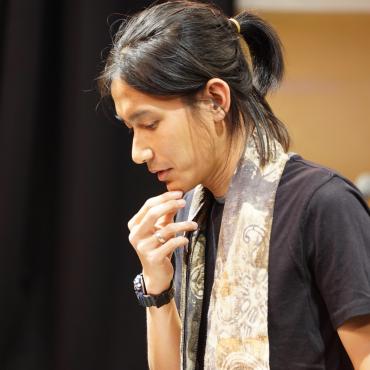

Jay Afrisando is a music composer and sound artist who employs sound and other media to share awareness of human-nature-technology relationships. His work Gunung Siggalang is in Alex Lubet’s 2020 album Three Strings and The Truth: New Music for Mountain Dulcimer. In 2019, his multisensory work The (Real) Laptop Music :)) was presented at Aural Diversity Conference and he presented a full-sphere installation Gendhing Cosmic at Linux Audio Conference.
Afrisando’s interactive installation Exploring the Music of Your Office was presented by the American Composers Forum (ACF) in the 2019 Landmark to Lowertown series. He received an Award for Excellence in 2019 from the Ambassador of the Republic of Indonesia for the United States, a 2016 Minnesota Emerging Composers Award from ACF and an Innovative Art Grant from Kelola Foundation (Yayasan Kelola) to create a participatory performance Mode[a]rn. His piece Water Siter was awarded the 2nd Prize Winner at Prix Annelie de Man 2015. He received a OneBeat 2015 residency in the US and an International Fellowship in Study of Korean Music in 2014.
Fellowship Statement
I use sound and other media to share awareness on complex issues that emerge as a result of our diverse perceptions and the technology we create, including issues on hearing and listening, disability and accessibility, the politics of technology and science, as well as culture and environment.
Through my artistic works, I aspire to capture and convey these intricate phenomena using various approaches, including but not limited to, audio and audiovisual works, 2D and 3D works, participatory work, improvisation, fixed media, and everything in between. Through my work, I want to invite my audiences to closely examine our relationships to other living entities, nature, and technology.
Photo by Kakia Gkoudina
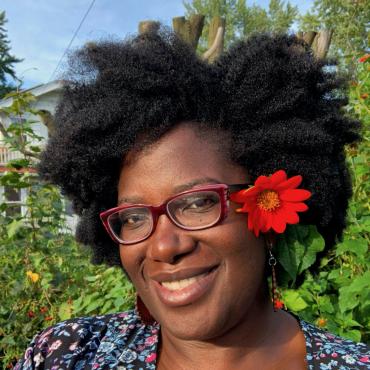

Kashimana is a mother, musician, vocalist, composer, producer and teaching artist with a rich soulful blues voice. The name Kashimana means “that’s their heart” and you can hear Kashimana’s heart beating in the compelling sound of their music, which combines Soul, R&B, Folk, Afro-funk and more. Kashimana’s Love from the Sun CD of original songs draws from her Nigerian heritage and her experiences growing up in Nigeria and Kenya and living in the United States. In 2019, she was the In Common Composer in Residence in Willmar, MN, a Cedar Commissioned Artist, and a Northern Spark Festival Artist (as well as in 2018).
Fellowship Statement
The need to create change and to use my voice to ignite this change drives my work. I use my voice to see other universes and possibilities. With my voice, I hear the joy, the pain, where I come from and where I am going; with my voice, I heal, soothe, and create; with my voice, I am able to connect, harmonize, magnify, communicate, and transmogrify. This is why I use my voice to write, compose, sing and share.
Currently I’m experimenting with loops to create drones, chants, hums, and dissonant harmonies in an effort to create a visceral tingling effect. I use improvisational lyric writing to engage crowd participation towards collaborative creation. I’m also exploring ways of visually representing the vibrations that result from voices to create a more immersive experience.
Some works in progress include Phantom Cries (the musical), A Sprig of That, composed for a MNiature with MN Opera and a song on The Art of the Revolution album by Black artists in the wake of George Floyd’s death.
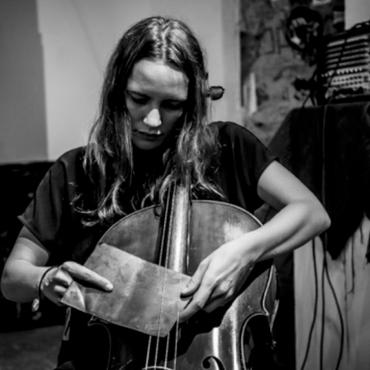

Leila Bordreuil is a Brooklyn-based cellist, composer and sound-artist from Southern France. After earning a degree in Cello Performance from the Conservatoire National d’Aix-en-Provence, she pursued studies in Experimental Music at Bard College under the mentorship of Marina Rosenfeld. In 2012, she moved to Brooklyn as a dedicated improviser where she became an active collaborator and “rising figure in New York’s Improvised music scene” (The Chicago Reader). In 2019, she released her debut solo LP Headflush, a “real abstract gem” (Boomkat) that “bears the authority of someone who has put many hours of thought and practice into creating her own sound” (Bandcamp).
Bordreuil received composer commissions from the French Embassy at Lincoln Center, ISSUE Project Room, the Kitchen, the French Alliance, Sounds of Stockholm Festival, GRM (Paris) and the American Symphony Orchestra. She is a 2020 artist-in-residence at the GRM, Paris. Past residencies include the McDowell Colony, ISSUE Project Room and E.M.S, Stockholm.
Fellowship Statement
My music draws from Noise, Free Improvisation, avant-garde and other experimental traditions, but adheres to no single genre. Cross-pollination is at the center of my work, both aesthetically and in practice. In my cello performances, I mix my instrument’s culturally inherited melancholia with cathartic harsh noise walls, creating “steadily scathing music [that] favors long and corrosive atonalities” (New York Times). My compositions create immersive environments that enhance psychoacoustic happenings and heighten subjective perception, supported by neuro-scientific research. Often incorporating site-specific resonance, I craft musicality out of an organized awareness of natural sound phenomena. My chamber music pieces are presented at prestigious concert halls and DIY basements alike, in an effort to permeate barriers of musical genre and scene.
During my fellowship I will create large ensemble pieces, study light art to expand my work with perception, and use the resources that Jerome Foundation provides to support the creation of DIY community art spaces after the pandemic.
Photo by Peter Ganushkin


Raised on the verge of several musical streams since her childhood, award-winning violinist and composer Layale Chaker received her musical training at the National Higher Conservatory of Beirut in her native Lebanon, at Conservatoire de Paris and the Royal Academy of Music in London.
Layale’s musical world lies at the intersection of classical contemporary music, Jazz, Arabic Music, and free improvisation. She has received commissions and presented performances and projects around Europe, the Middle-East, North and South America and Asia, and has collaborated with Daniel Barenboim and the West-Eastern Divan Orchestra, Johnny Gandelsman, Holland Baroque, International Contemporary Ensemble, Oxford Orchestra, the New World Symphony, Babylon Orchestra, performing at the London Jazz Festival, Junger Kunstler Festival Bayreuth, the Lucerne Festival, and concert halls such as The Berlin Philharmonic, Abbaye de Royaumont, National Sawdust and Wigmore Hall. Her debut album with her ensemble Sarafand, Inner Rhyme, was released on In a Circle Records, and listed as “Top of The World” by Songlines with a 5-star review, NPR 10 Best Releases, and has received praises by the BBC Music Magazine, The New York Times, The Strad, Strings Magazine, Jazz World among others.
Fellowship Statement
As I have navigated through a succession of different places to call home throughout my life, music was one of the few constants that grounded me through these changes. It quickly became a familiar territory, and my way of relating to the world.
That feeling of finding one's home and voice in artistic practice soon turned into one of the main forces behind my work. Today, my communication with the world through music rises from a need and desire to create a haven of belonging, inclusion, visibility and communion for peoples’ histories and narratives through sound, and beyond words.
During the course of this fellowship, I hope and aspire to continue this focus on understanding and querying estrangement through my practice. This will be embodied through the way I conduct research for my various projects, through the development of my musical and artistic language and expression, and through the different works I intend to carry and create.
Photo by Anna Rakhvalova Photography
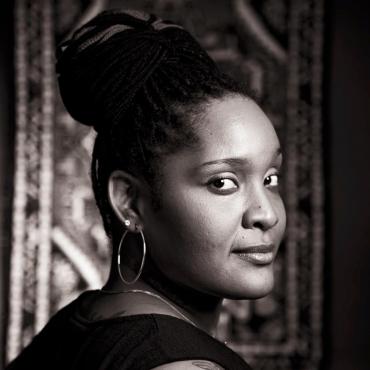

PaviElle is an amazing interdisciplinary artist, hailing from Rondo, a historically Black neighborhood in St. Paul, Minnesota. She is the recipient of an Upper Midwest Emmy Award as well as, a Sage Award for Dance and Choreography. She received a 2020 McKnight Artist Fellowship for Musicians and an, American Composers Forum Grant for her classical composition, A Requiem for Zula (2019) written in celebration of her Mother, Zula Young. She is known for her powerhouse vocals and for performing with an equally powerful 6-piece band. PaviElle was voted as Minneapolis City Pages “Best R&B Vocalist of 2015,” her band was named one of First Avenue’s Best New Bands of 2015. She is a Teaching artist and a part of the Jazz Department Faculty at MacPhail Center for Music. PaviElle honed her craft as a teenager at Penumbra Theatre, SteppingStone Theatre and with collective, EduPoetic Enterbrainment.
Fellowship Statement
I am a composer, musician, lyricist, spoken-word artist, dancer, playwright, and actor. I am influenced by so many prolific artists, nationally and locally, however, I embody my own unique technique and sound. I am an artist who believes in alchemy and that art can be used as a vehicle to not only heal myself but, to heal others in the process as well. I have realized in this process that my niche is in combining all of my artistic disciplines to create shows with music, movement, acting, dramatic storytelling and singing. The next movement and goal for my career is creating multi-disciplinary shows and further deepening learning how to orchestrate scores for orchestras. I plan to travel to work with composer mentors, as well as, study healing sound therapies. And, I hope to tour my work from this fellowship, nationally and locally.
Photo by Sharolyn B. Hagen
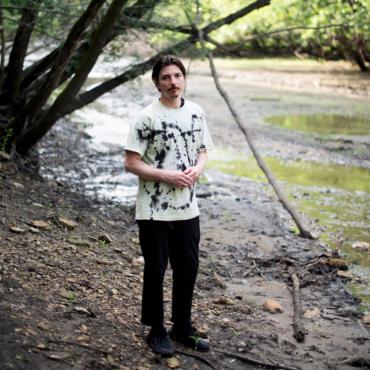

Eric Frye is an American composer and artist. He is known for his solo performance and installation work, which explore the dissociative and psychoactive functions of sound and image. Recently, he premiered audio-visual pieces in LA, Vancouver, Tokyo, and New York City. He has performed multi-channel works alongside central figures of experimental music including Curtis Roads and Beatriz Ferreyra (Ina GRM). His recent solo recordings include Diffusion Soliloquies (2020) and Sketches for Functional Music (2019) and sound design and voice processing for a short film, Elephant Juice, by Swiss designer Simone Niquille. Frye’s work has been shown at HeK, Switzerland; Hangar Art Centre, Barcelona; Audio Visual Arts, New York City; Rochester Art Center, Minnesota; Variform Gallery, Oregon: and more. He has performed extensively in the US, UK, Europe, and Asia.
Fellowship Statement
In 2020, I collaborated with Viennese artist Stefan Juster (Jung An Tagen). We produced two sound projects, Pulsar Acid and Variations for Computer Ashtray, with plans to work with film in the coming months. I am currently researching voice obfuscation software and ambisonics while collaborating with colleagues on a number of multi-disciplinary projects. Intertwining surreal narratives with a multi-disciplinary approach to sound, I am assembling a shapeshifting auditory scene, one that explores the malfunction of perception and how it relates to new ways of masking, or blurring the self.
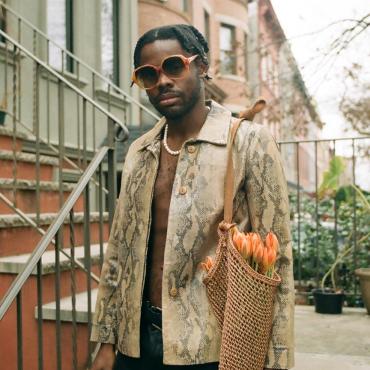

Prince Harvey is a New York City-based artist, musician, and producer most famously known for recording his first album in an Apple Store. In 2017, he released an EP called Golden Child, followed by Stay Bold: 100 Days 100 Songs, where he premiered a new song every day for 100 days as a protest against Trump. In 2018, Prince was an artist at HarvestWorks and a commissioned artist at The Shed where he began work on a new music album and series of short films.
Harvey’s music has been featured in The New York Times, Noisey, Billboard, VICE, The Daily Beast, The Guardian, The Fader, and Afropunk among many others. Upon release of his first album, PHATASS, he received notice from major music and news publications, as well as celebrities like Lil Wayne, Russell Simmons and Talib Kweli. Prince Harvey’s forthcoming album will be released in Summer 2021.
Fellowship Statement
For the last one decade through music, film and performance works, I have been creating a guide that explores nuances of black and queer culture, usually censored from the general public. My practice is emboldened by my insatiable need to charter unchartered waters. To tell stories that haven't been told. To show the surprising extent of human potential through innovation and the exploring of new and unique avenues. Growing up without certain privileges, I have learned to infuse an element of hacking in the work that I do to accelerate the results that I want. As an artist I believe my talents are best utilized by creating personal and collective narratives that challenge widely accepted views of normalcy.
Photo by Christopher Garcia Valle
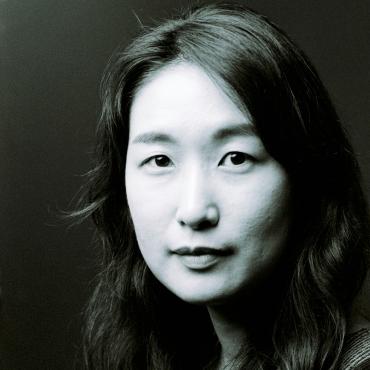

Gamin Kang, simply known as “gamin,” is a New York City-based multi-dimensional artist performing across the genres of traditional Korean music and cross-disciplinary collaborations worldwide. Ralph Samuelson, a senior advisor of Asian Cultural Council, once praised gamin as “a true pioneer and innovator, leading traditional instruments in exciting new directions.” Gamin plays 3 types of Korean winds and is a designated Yisuja (Senior Diplomate), official holder of Important Intangible Cultural Asset No. 46 for Court and Royal Military music. Gamin earned her Doctorate in Korean Musical Arts at Seoul National University.
Re-inventing new sonorities from ancient, somewhat restrictive, musical systems, gamin has received several cultural exchange program grants, including Artist-in-Residence at the Asian Cultural Council, and Ministry of Culture, Sports, Tourism of the Republic of Korea. Gamin has collaborated in cross-cultural improvisation in NYC with world-acclaimed musicians Jane Ira Bloom, Elliot Sharp, Ned Rothenberg, Jen Shyu, presenting premieres at Roulette, New School, and Metropolitan Museum. Gamin was a featured artist at the Silkroad concert, Seoul, 2018, performing on-stage with Yo-Yo Ma.
Fellowship Statement
I play three winds: piri (double reed bamboo oboe), taepyeongso (traditional oboe), and saengwhang (mouth organ). I am now on a journey to explore musical identity, discover new connections, and collaborate with artists from different backgrounds and cultures. Our common thread is communication and self-expression. My quest begins by studying other arts and music traditions, to discover how to best express these different strains through sound and composition.
In 2011, I began participating in musical activities outside of Korea, where I was born and educated. I have since devoted my career to intercultural music-making, working with western artists and those from East Asia, particularly in projects that bring together traditional instruments with digital sound sources.
Tradition is continually transformed by new generations of artists. My compositions merge Korean tradition with modern perspectives from audiences and environments. I am developing projects based on inter-disciplinary collaborations with interest in humanity and history.
Photo by Elan Asch
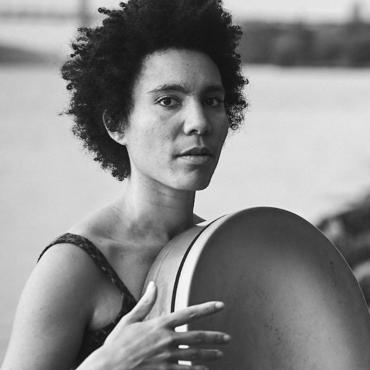

Anaïs Maviel is a vocalist, percussionist, composer, writer and community facilitator. Her work focuses on the function of music as essential to settling common grounds, addressing Relation, and creating utopian future. She works at the crossroads of mediums - music, visual art, dance, theater and performance art, and has been a creative force for artists such as William Parker, Daria Faïn, Shelley Hirsh, César Alvarez, Steffani Jemison. Maviel is dedicated to substantial creations from solo to large ensembles, music direction of cross-disciplinary works, and to expanding the power of music as a healing and transformative act. She performs and teaches extensively in New York, throughout North, South & Central America, and Europe. Both solo albums hOULe and in the garden, were released on Gold Bolus Recordings and received international acclaim. Lastly, Anaïs Maviel was the 2019 recipient of the Van Lier Fellowship to generate new works at Roulette Intermedium in New York City, and of the 2020 American Composers Forum Create commission for new work with the Rhythm Method string quartet.
Fellowship Statement
My work wants to hold space for weaving and disentangling narratives of self in relation to society, earth and cosmos. Despite globalization and refined technologies, individualized lives scarcely embrace interdependence. Yet the uniqueness of each being— this one thing that we share —is in fact our livelihood, both for one and many. The relational complexity of this Creole (not quite postcolonial) anthropocene era, is the field in which I operate. Music, as a form of communication prior to articulate language, is fundamental to the human experience and for the capacity to conceive of oneself in relation to one’s environment. I shape sensory experiences made of what I hear from the world, bridging the fragmented and envisioning harmony in the sensible. I hope to light the desire in everyone to re-create ways to relate, so that actualizing one means actualizing all. Transformation is an alchemical phenomenon, a leap connecting ancestral wisdom to utopian futures.
Photo by Dar Es Salaam Riser
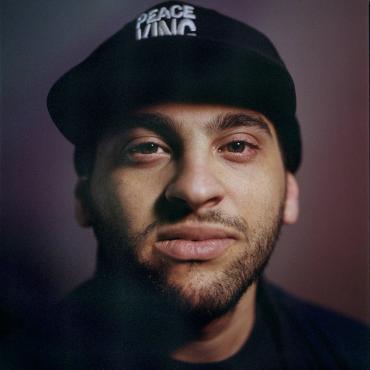

Samora Abayomi Pinderhughes is a composer, pianist and vocalist known for large multidisciplinary projects and for his use of music to examine sociopolitical issues. Samora is the director and creator of The Transformations Suite, an acclaimed project combining music, theatre, and poetry to examine the radical history of resistance within the communities of the African Diaspora. Samora’s collaborators include Sara Bareilles, Titus Kaphar, Herbie Hancock, Glenn Ligon, Daveed Diggs, and Lalah Hathaway. He works frequently with Common on compositions for music and film, and is a featured member on the new albums, August Greene and Let Love, with Common and Robert Glasper. A Sundance Composers Lab fellow, Samora scored the award-winning documentary Whose Streets? and the Field of Vision film Concussion Protocol. He is a member of Blackout for Human Rights, the arts & social justice collective founded by Ryan Coogler and Ava DuVernay, and was musical director for their #MLKNow and #JusticeForFlint events.
Fellowship Statement
As an artist, my primary goal is to ensure that whoever experiences my work will be altered in some way that affects their daily lives; how they think and act, how they relate to others, how they consider their daily relationship to their country and world. I hope to bend the conventions of artistic genre and discipline to create pieces that deeply pierce the soul, grasping at the foundational elements of what it means to be alive in this moment. My work deeply criticizes the oppressive systems of American corporatism and colonialism, and reveals the many ways people are wounded by these systems as well as the many ways they fight back, imagining possibilities beyond what is allowed. I am a prison and police abolitionist. Current projects I'm working on include The Healing Project (about trauma & healing from incarceration and violence), Venus Smiles Not (about how traditional masculinity distorts the ways men learn how to deal with loss), and Grief, a collection of songs reflecting on the past two years. I'm honored to receive this support from the Jerome Foundation to continue my work.
Photo by Jacob Blickenstaff
2019 Fellows


Janani Balasubramanian (they/them) is a writer, game designer, and immersive theater maker whose work has been presented on stages across North America and Europe, including The Public Theater, High Line, MoMA, Abrons Arts Center, Andy Warhol Museum, Red Bull Arts, Ace Hotel, Brooklyn Museum, and the Metropolitan Museum of Art. Residency support for this work has included the NEA, Public Theater Devised Theater Initiative, and Mount Tremper Arts. Balasubramanian is currently a 2018-2020 Van Lier fellow at the Public Theater as well as artist-in-residence with the brown dwarf astrophysics group at the American Museum of Natural History. Current projects include Rogue Objects, a live audio game about a celestial object struggling with its consciousness; Transference, a collaboration with stellar astronomer Dr. Natalie Gosnell; Harold and Okno, a Cold War era novel about an extraordinary friendship; and Night Chicken, a farm animal jazz musical.
Fellowship Statement
I am invested in continuing to explore audio-immersive games as a theatrical form. Additionally, I am interested in collaborating with artists in music, film, and VR to develop even newer forms together. I also seek to build from the methods I have developed while in residence with the brown dwarf astrophysics group to collaborate with scientists in other fields. I hope to discover what I, as an artist, can learn from each scientific field’s research practices, and contribute to the rich, historical, and ongoing exchange between theater and science. Finally, I hope to build my fluency with relaxed performance and other accessible theater-making methodologies, and create both large-scale and intimate performance experiences that expand our notion of what contemporary theater can look like, and who and where its audience can be.
Photo by Anna Hadjo.


Considered one of America's leading spoken word poets, Caridad De La Luz (she/her), aka La Bruja, is a multi-faceted performer named in the “Top 20 Puerto Rican Women Everyone Should Know” (La Respuesta). Known as a “Bronx Living Legend,” Caridad has received a Citation of Merit from the Bronx Borough President as well as The Edgar Allan Poe Award from The Bronx Historical Society. She has performed at The Apollo, Lincoln Center, Gracie Mansion, Cathedral of St. John the Divine, City Hall in New York City and many international venues. Since her 1996 debut performance in the famed Nuyorican Poets Café, she continues to host Monday Night Open Mics where people from all over the world come to perform. The New York Times called her “a Juggernaut" and she is currently cultivating her own art space in the Soundview area of The Bronx called “El Garaje” where she lives.
Fellowship Statement
As an artist connected to ancestral knowledge through my Puerto Rican, Bronx and Taino roots, I create work that speaks about our realities and injustices, as well as to Feminist, Latinx, LGBTQ and POC communities. My goal with this grant is to expand my knowledge of Indigenous practices by visiting artists and healers of First Nations along the Northwest Coast of North America, Peru and Africa. With this knowledge, I will expand my creativity and offer healing circles in The Bronx where I’ve lived my entire life. Through meeting new contacts, I will also be able to invite healers and artists to create and share their knowledge in my space, El Garaje, through creative residencies in the future. My artistic work has always included healing, which is why I chose the stage name “La Bruja” (aka The Witch). My intention is to create transformation via art and Indigenous worldview healing practices.
Photo by Ted Lopez.


Antonio Duke (he/him) is a Twin Cities-based actor, playwright, and teaching artist. He worked with Pillsbury House Theatre as part of the Summer 612 Micro Grant (2011 & 2012), Late Nite Series (2012) and Naked Stages Fellowship (2018) where he created his solo performance play Ashes of Moons. His solo performance play Tears of Moons was part of the Guthrie Theatre’s Solo Emerging Artist Celebration. Antonio’s plays The Death of Kings and The Fog premiered as staged readings at the Guthrie Theatre for The New Griots Festival. His play The Sly Sambo appeared as part of the Fresh Ink Series at the Illusion Theatre. The Fog garnered him The Many Voices Mentorship from The Playwright Center. He's the recipient of the 2019 Artist Initiative Grant through the Minnesota State Arts Board for his solo performance play Missing Mississippi Moons. Training: University of Minnesota/Guthrie BFA Actor Training Program.
Fellowship Statement
My artistic aim is to create stories from the black diaspora as authentically as possible. In my writing I focus on mythology. Within mythos lies intimate and epic circumstances that I am driven to explore. I conjure most of my muse from black spiritualities; specifically, those deities from the Afrocentric Yoruba, Santeria and Voodoo traditions. In my work, I speak about trauma, both personal and historical. Performing traumatic events with Afrocentric cultural aesthetics is important to me because it provides me with the chance to connect with my ancestors. In doing so, I follow in a lineage of West African storytellers called Griots. Stories are strange spells. They are conjurations in our mouths. Playwriting and performance is a spiritual manifestation act rooted in an ancient practice of Afrocentric storytelling. It is through this practice that I can sit with the ancestors that I have yet to meet.
Photo by Bruce Silcox.
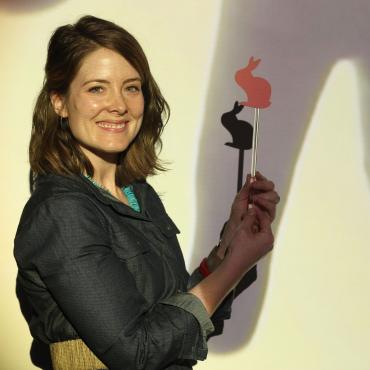

Megan Flød Johnson (she/her) is a socially engaged “theatre for youth” artist who brings together youth and their communities through play to spark social action. She co-creates with communities around the country exhibits, events, residencies and performances for the very young.
THE NEST (2014) is an evolving installation about an illusive creature inhabiting public spaces revealed through child-led curation and storytelling. Children’s ideas transform space into a layered, narrative playscape capturing identity(ies) of place, youth assets and reflections on welcoming a stranger. THE NEST was developed at Children's Museum of Pittsburgh (remounted in 2017) and has since traveled to Santa Cruz Museum of Art & History, Noah's Ark at Skirball Cultural Center in Los Angeles, and summer 2019 as an exhibit with the St. Louis Public Library system. THE NEST is the subject of a documentary by filmmaker Alicia Rice called When Kids Meet a Creature.
Megan resides in Saint Paul, MN where she is a Teaching Artist and Program Developer for SteppingStone Theatre and Art Center of Eden Prairie. She holds an MFA in Theatre for Youth and graduate certificate in Socially Engaged Practice from Arizona State University and BA’s in Theatre and Music from Lawrence University in Appleton, WI.
Fellowship Statement
I am a socially engaged “theatre for youth artist” who brings together youth and their communities through play to spark social action. I seek to disrupt dominant narratives and expectations for young people to designate new spaces for process, dialogue, experimental thinking, play and welcoming multiple points of view. Youth agency is central in my work, which experiments with models of participation through performance, unstructured play and hands-on making.
I am working on developing a mobile version of my installation playscape, THE NEST about an elusive creature whom children build a temporary home for in public spaces. I will experiment with different models of engagement for the project including city-hosted events, guerrilla pop-ups, and an original performance. I hope to bring pop-up NEST experiences to youth and families in places where they already are—in parks, parking lots, apartment buildings, clinics, schools, and/or shopping malls.
Photo by Alicia Rice.
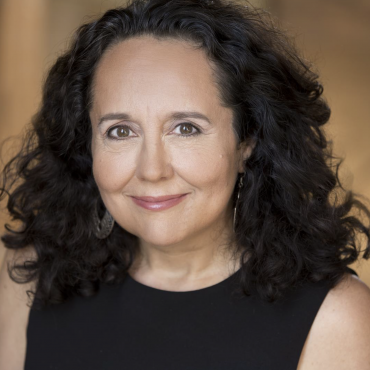

Kathryn Haddad (she/her) is a writer, teacher and community organizer whose work explores contemporary Arab American experiences and reflects on the political reality of life for Arab Americans. Kathryn founded Mizna – one of the few Arab American Arts and literary organizations in the United States and served as Artistic/Executive Director for twelve years. She’s a recipient of a Bush Fellowship for work with the Arab American community and received three Playwright’s Center Many Voices Fellowships. Her plays have appeared in various venues, including the anthology, Contemporary Plays by Women of Color. Kathryn was awarded the 2018 Kay Sexton Award at the Minnesota Book Awards for her literary impact on the State of Minnesota through her work with the Arab American community.
Fellowship Statement
I strive to tell Arab and Arab American stories through theater - reflecting on the social and political climate at home and abroad. Immigration, family life, political struggle, colonization, religion, and bicultural experience have all been subjects I have explored. This award will give me the opportunity to work with community to continue the dialogue and conversation through art. The fellowship will allow me time to work on my craft as a playwright and strengthen my writing through study and practice. I would like to make new connections and collaborations with theaters, individuals, and communities that share a common vision, and I hope to reach new audiences with my work.
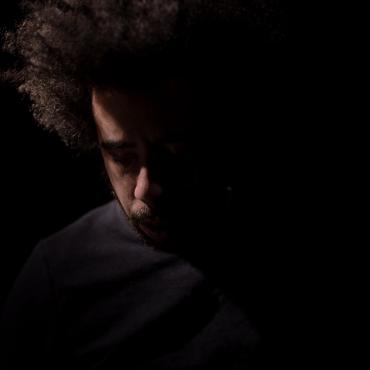

Joe Horton (he/him) is a rapper, artist, and founding member of FIX music and arts collective. His interdisciplinary work spans medium and genre, but always features a signature blend of futurism and mysticism. The best example of this is his latest work, A Hill in Natchez, is a surreal work that combines elements of dance, visuals, and music. Joe is currently working on a new album produced by Anatomy (Kill the Vultures) as well as VESSEL, a visual and musical work that will premiere at the Minneapolis Institute of Art in Fall 2019.
Fellowship Statement
I owe as much to the mystical tradition as I do the artistic. I am interested in nurturing vital knowings that come directly from the Mystery. I want to marry ancient techniques of ecstasy and forward-thinking technologies. I want to sing to the moment as it passes.
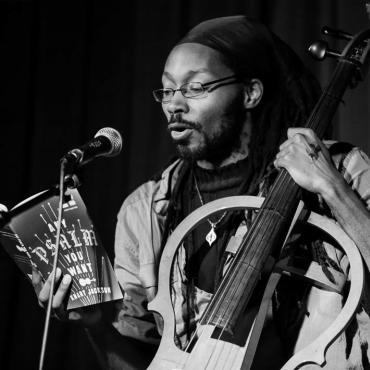

Khary Jackson (he/him) is a poet, playwright, dancer and musician. He has written several plays, one of which (Water) was produced in 2009 at Ink and Pulp Theatre in Chicago. As a hip hop/street dancer he was fortunate to create and perform a piece at the 2018 Choreographers’ Evening at Walker Art Center. He has been a recipient of several generous grants, including the 2016 McKnight Artist Fellowship in Writing, the Minnesota State Arts Board’s 2012 Cultural Community Partnership Grant and 2010 Artist Initiative Grant for Poetry, the Many Voices Fellowship from The Playwrights’ Center in 2005 and 2007, as well as the 2009 VERVE Spoken Word Grant from Intermedia Arts. He is an alumnus of Cave Canem, the esteemed writing fellowship for black writers. His first poetry book, Any Psalm You Want, was published with Write Bloody Publishing in the spring of 2013.
Fellowship Statement
It is my aim to use multiple artistic mediums in the service of a greater, unifying idea. After years of focus on individual areas of arts composition and performance, this feels like the time to bring them together, and create artistic experiences that can speak to someone on multiple levels of engagement. I am looking at poetry/creative writing as the grounding element in a collaboration with dance, music, video and visual art. I want others to hear more of what I’m hearing, see more of what I’m seeing, and, perhaps, move with me in whatever ways they can.
Photo by Erin X. Smithers.
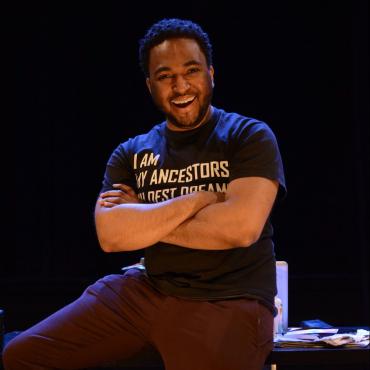

Kareem M. Lucas (he/him) is a Brooklyn born and Harlem-based actor/writer/producer/director. His solo pieces include The Maturation of an Inconvenient Negro, From Brooklyn With Love, RATED BLACK: An American Requiem, A Boy & His Bow, and Black Is Beautiful, But It Ain’t Always Pretty. He is currently co-collaborating on the development of the immersive theatrical piece The Black History Museum...According to the United States of America, as a writer/performer with the Smoke & Mirrors Collaborative at HERE Arts Center. He recently presented his solo piece, RATED BLACK: An American Requiem, as a part of New York Theatre Workshop’s Next Door Series, and The Maturation of an Inconvenient Negro as part of his 2019 Mentor Project at Cherry Lane Theatre. Kareem received an MFA from New York University’s Graduate Acting Program.
For more info follow him on Instagram @KareemMLucas.
Fellowship Statement
I feel a great responsibility to articulate what it is to be Black now. Currently, my curiosity is drawn to investigating and deconstructing the Black heterosexual cis-gendered male perspective as it functions within America’s White supremacist capitalist patriarchy. How the legacy of slavery, racism, misogyny, religion and the value of the Black body over the Black mind still insinuates itself into our modern day existences and systems, as we navigate love, intimacy, identity, and self-worth in this digital media age The greatest service I may provide through my work is to communicate on behalf of my culture, so that we may reflect, heal, inspire, take responsibility, and move forward, because this lack of self-awareness, self-care, self-love, and overall accountability has diminished our progress as a people in this land for many generations.
Photo by Stan Demidoff Photography.
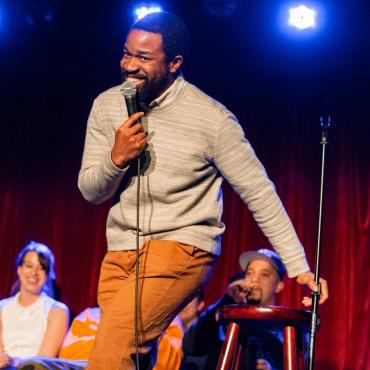

Ikechukwu Ufomadu (he/him) is a comic entertainer, named one of five “Comics to Watch in 2018” by Time Out New York. His original projects include: Ike at Night (The Public Theater), Nightcap | by Ike (Joe’s Pub at The Public), Ike Night (Ars Nova, San Francisco Sketchfest), Ike for the Holidays (Joe’s Pub at The Public), Ike by Chance (Ars Nova), Inspector Ike (Comedy Central Corporate Retreat), Ike’s Wonderful World of Leisure (Exponential Festival) and more. His short-form series Words with Ike has aired on VICE and IFC.
He trained at New York University’s Tisch School of the Arts; the International Theatre Workshop in The Netherlands; and Studio Five’s theatre and dance programs in Indonesia. Ikechukwu has been an artist-in-residence at Joe’s Pub at The Public and SPACE on Ryder Farm.
Fellowship Statement
As a comic entertainer, my primary objective is to entertain, comically.
My work often takes the formats of classic American variety and talk shows and sets them in performance contexts that make them feel both familiar and strange. This results in humor that is disorienting and plays with people’s expectations, while maintaining a warm, welcoming “big tent” sensibility that invites an audience of diverse life experiences to come along for the ride.
Crafting intimate entertainments that can serve as sites of shared laughter, improvisation and play is a pressing need in a time marked by deep divisions, fragmentation and social deadlock. Indeed, our deepest impasses, individually and collectively, are marked by the absence of such play. My hope is to build a body of work that succeeds as entertainment while stimulating those human qualities necessary to not only cope with the problems of our time, but resolve them.
Photo by Mindy Tucker.
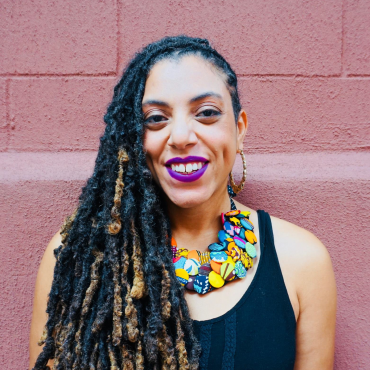

Nia O. Witherspoon (she/her) is a black queer writer/director, vocalist/composer, and cultural worker. Described as “especially fascinating” by Backstage Magazine, and named in Phoenix’s “Top 100” Artists, Witherspoon’s work creates contemporary ritual-space grounded in African Diaspora sensibilities to speak to the issues of our times. Currently in residence at Brooklyn Arts Exchange, Witherspoon has received New York Theatre Workshop’s (NYTW) 2050 Playwriting/Directing Fellowship, BRIC’s Premiere Residency, Astraea Foundation’s Global Arts Fund Grant, Brooklyn Arts Fund (BAC), Downtown Urban Theatre Festival’s “Audience Award,” Lambda Literary’s Emerging Playwriting Fellowship, and a Mellon Dissertation Fellowship. Her works, including The Messiah Complex, YOUMINE, and SHE have been developed or featured at BRIC, HERE, NYTW, National Black Theatre, BAAD, Dixon Place, The Fire This Time Festival, and Movement Research. Witherspoon holds a PhD from Stanford University, and is currently a Playwright-in-Residence at University of Massachusetts (Amherst). She has works commissioned in the 2019-20 season by The Shed, Playwright’s Realm, La Mama ETC, and JACK.
Fellowship Statement
I am a concept-driven artist invested in creating spaces where black/queer/trans/female folks, and, more largely people of color, are able to be seen in their full humanity, and their full divinity. This means that while contemporary tragedy and inter-generational trauma often trigger a project’s inception, ultimately, I aim for my works to place my communities in a context that far exceeds the 500-years of colonial time and instead to find the palimpsest of wisdom in liberation. Freedom is not something I have achieved yet, but it is something I feel pulled uncontrollably toward. I am working to cultivate freedom in myself, in my works, and in my collaborators, by any means necessary. I am also learning that freedom is very much about surrender to the imperfect, and so I try to create spaces (from plays to rituals to rehearsal rooms) where vulnerability is the most valuable currency.
I am deeply inspired by the resonance inside of dissonance—particularly in reparation of the sacred/secular binary. I am also invested in the concepts of layering and unfolding, as the nature of diaspora is palimpsestic, cyclical, and always in motion. In The Dark Girl Chronicles, Yoruba divination scripture lives alongside verbatim investigation-room testimony, court transcripts, and Cardi B to unearth the stories of black women warriors against state violence. I am excited by the potential of theatre to allow us to see what we would otherwise not see—the moonlit vision—the “magic eye” that offers a window the Great Mystery. In The Messiah Complex, the nightclub has permission to become the ritual ground and sacred cemetery. A heteronormative Black Panther has permission to love a transwoman. And his transmasculine child has permission to become the Messiah, leading the next generation of the black liberation struggle.
Photo by Zavé Martohardjono.
2021 Fellows
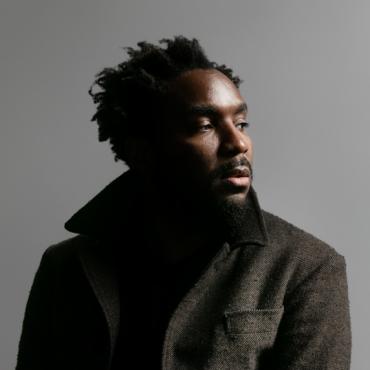

Phillip Howze is a playwright and theater maker whose works include Self Portraits (BRIC-Arts Media) and Frontieres Sans Frontieres (Bushwick Starr). His plays have been seen and developed at American AF Festival, Bay Area Playwrights, Clubbed Thumb, Lincoln Center Education, New York Theater Workshop, Page 73, PRELUDE, Public Theater/NYSF, San Francisco Playhouse, Sundance Theater Institute, Theatre Masters, and Yale Cabaret. He is currently a Lucas Artist Fellow at Montalvo Arts Center, a Resident Writer at Lincoln Center Theater/LCT3, and was recently named Lecturer in Playwriting at Harvard University’s new Theater, Dance & Media program. He lives in Brooklyn, NY.
Fellowship Statement
Fellowship is a noun. Among its meanings are communion and companionship. In a year of unfathomable loss, collective grievance and individual grief, when we have been necessarily distanced from each other, thoughts of fellowship could rightly feel like a throwback, or frivolity. Often for theater artists, fellowship has served as a friendly harbinger: a herald of hope, company and good humor. How might fellowship serve this same cause today? Not to commiserate with the times, but to imagine and commune in renewed ways. To wonder and refashion old words into new worlds. Together, to remember the meaning of things.
Photo by Beowulf Sheehan
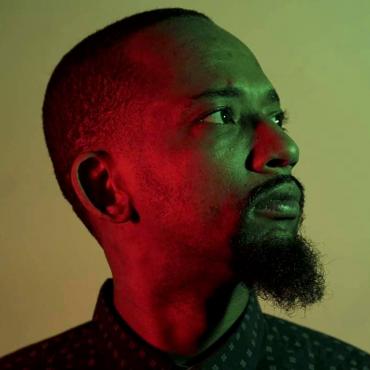

Modesto Flako Jimenez is a Bushwick-raised artist and educator. He was the 2015 Hispanic Organization of Latino Artists (HOLA) Best Ensemble Award Winner, ATI Best Actor Award Winner 2016, HOLA Outstanding Solo Performer 2017 and 2016 Princess Grace Honorarium in Theater. He has taught theater and poetry in NYC Public Schools for ten years. He has toured internationally and appeared on TEDxBushwick, performed in Wooster Group’s Early Shaker Spirituals, Richard Maxwell’s Samara, Kaneza Schaal’s JACK &. and Victor Morales’ Esperento. In 2018 he became the first Dominican-American Lead Artist in The Public Theater’s UTR Festival for ¡Oye! For My Dear Brooklyn.
Fellowship Statement
I am currently working on Taxilandia, a culmination of my work over the past 9 years that serves as a living collection of the people, spaces, and stories from my community. After the virtual run with La Jolla Playhouse in San Diego and The Tank in NYC, when Covid-19 rules permit, I will start the groundwork for a live production with New York Theatre Workshop and the Bushwick Starr. After the city-run, I will use Taxilandia and what I've learned from my years of collaborative creation in New York City to lead conversations with displaced people across America. I want to collaborate with local artists and theaters to adapt the show for their own communities. The 15 years of teaching artist work and cataloging gentrification I’ve done within Bushwick will inform the artistic conversations I’ll have with communities across America.
Photo by Crichton Atkinson
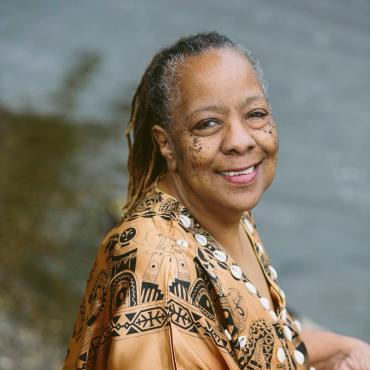

Amoke Kubat remains curious about self, the natural world, and the Sacred. She reclaims African Indigenous Spiritual sensibilities to reconnect to the first worlds, Spirit and Nature, as practice for holistic wellness. Self-taught, Amoke uses artmaking and writing to continue to heal herself and hold a position of wellness in an America sick with social injustices.
Amoke is an accidental playwright. Her play ANGRY BLACK WOMAN & Well Intentioned White Girl began as a conversation with a friend. Amoke expressed her annoyance with being called “angry black woman.” Her friend responded, “Like the well intentioned white girl'”? This play continues to tour as public readings in Minneapolis and rural Minnesota cities, and is available on Vimeo. As a Naked Stage Fellow, her second play, Old Good Pussy and Good Old Pussy, was performed at the Pillsbury House Theater in 2020. This play explores aging, ageist stereotypes, sexuality, and the social interpersonal tensions between intergenerations.
Fellowship Statement
My artistry is a tapestry of growing relationships, that has been woven from a motherless life, non-traditional black experience, discovery of the self through pain and tribulations as I strive to live my fullest life. I draw upon the strengths of diasporic African peoples and my Ancestors.
In 2020, in the time of COVID and World Wide Socio-political UNRESTS, I fought past, present and future. It was the battle to proclaim and be heard that, MY LIFE MATTERED when growing old is disdainfully feared. Old and aging peoples are more vulnerable and at risk and sometimes seen as collateral damage.
My new work will explore Black women's UNSAIDS about AGING; mind, body, and sexuality. But what if old black women, upon turning 100, revealed themselves to be Goddesses?
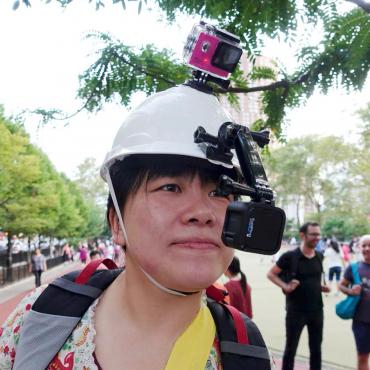

Ying Liu is a Brooklyn-based multimedia artist whose work hybridizes theater, dance, video, and performance art with DIY props and an exuberant sense of play by employing consumer technology—such as VR, GoPro and GPS—and featuring diverse, multi-generational performers. Emily Harvey Foundation (NYC) has presented Liu’s projects in numerous solo showings (2014-2017). In 2017, she staged HANG OUT, a site-specific, episodic play in Manhattan Chinatown’s Sara D. Roosevelt Park. MAKE A FOUNTAIN, an extensive catalog documenting those performances, was released in 2018. Liu was a resident artist at LMCC 2018-19 and ISSUE Project Room 2019, and a fellow at Institute for Public Architecture 2020. Her recent projects included PLAYDATE, a neighborhood-wide play in and about Downtown Brooklyn, and PIGTAIL–A Swivel Stool Dance™—both commissioned by ISSUE Project Room.
Fellowship Statement
Highlighting the shifting, participatory nature of viewership, mediated in real time by everyday use of technology, my practice reveals how experimentation is most fruitful when it escapes predetermination. My projects have included collaborations with bankers, construction and municipal workers, sociologists, psychotherapists, dog walkers, and scientists—sometimes all in the same performance. Poking at the traditional boundaries of media-based art, and often smashing the 4th wall between performer and spectator, I stir together contradictory forces of memory, spatiality, and the inherent friction and great possibilities of sociality. My second book, Heavily Prescribed Good Times, on PLAYDATE and PIGTAIL, will be released in 2021.
Photo by Steve Bookman
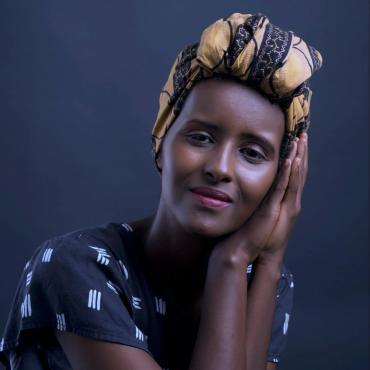

Ifrah Mansour is a Somali, refugee, Muslim, self-taught multimedia artist and an educator based in Minnesota. Her artwork explores trauma through the eyes of children to uncover the resiliencies of blacks, Muslims, and refugees. She interweaves poetry, puppetry, films, and installations. She's been featured in Middle East Eye, BBC, VICE, OkayAfrica, Star Tribune, and City Pages. Her critically acclaimed How to Have Fun in a Civil War premiered at Guthrie Theatre and toured to cities in Greater Minnesota. Her first national museum exhibition, Can I Touch It!? premiered at Minneapolis Institute of Arts. Her visual poem, I am a Refugee, is part of PBS’s short Film festival. Mansour’s installation, My Aqal, Banned and Blessed premiered at Queens Museum in New York. Learn More: facebook.com/ifrahmansourart
Fellowship Statement
My artwork is informed by my lived experience, and that of my community of Muslim, refugee, black, and Somali immigrants. I create art out of my most painful experiences to connect communities, spark conversation, and create meaningful relationships between refugees and Americans. As a refugee, I didn’t see my story represented on stage or in cinema. Now, I am a self-taught multimedia artist blending poetry, puppetry, sculptural installation, and films to stage resilient refugee stories. I am also an educator to East-African elders that often are learning for the first time. They teach me so much about Somali life and culture. My proudest work, How to Have Fun in a Civil War, is a play about Somali history seen through the eyes of children, has given me such an insight to bringing out the hidden complex identities, and resiliency of minorities in Minnesota. With my fellowship, I hope to learn what it takes to write, develop, produce and distribute powerful refugee and new American stories in cinema.
Photo by Lindsey Marcy


So + Bex (So Mak and Bex Kwan) are not the same person. However, they are best friends who are both queer, gender non-conforming Chinese artists of roughly the same height (Bex is an inch taller), working with shadow, sound, and performance. Both alumni of EmergeNYC, the Hemispheric New York Emerging Performers Program, they began developing their collaborative artistic vocabulary at Brooklyn Arts Exchange (BAX), first as participants in the Upstart Program 2017-8, Space Grantees 2018, and then as Artists in Residence from 2019-2021. So + Bex were featured at The Brick’s 2018 Trans Theatre Festival, were Spring 2019 BRIClab residents, and were featured at the Highline's Out of Line series in July 2019. As solo artists, they have been invited to present at theaters, galleries, and universities in Singapore and the U.S., including La MaMa, the National Asian American Theater Company, and 3LD.
Fellowship Statement
When we first met in 2015, we were finding ourselves in situations of surreal overlapping identity where our housemates were confusing us with each other. It was both absurd and surprised neither of us. Our work always circles back to these questions: how can people like us—queer, gender non-conforming, East Asian people—build power with each other if we are seen as identical? How do our persons stretch to be at once threatening (especially in the age of the COVID-19 pandemic), harmless (especially in comparison to Black people), and interchangeable (especially in media)? How do we shoulder the perpetual foreignness that we are assigned while managing the distance that we feel from our own cultural and ancestral roots? Our process weaves dreamscapes from shadow puppetry, archival audio, and comedy to unearth the absurdity and revelation of our sameness.
Photo by Carlos David
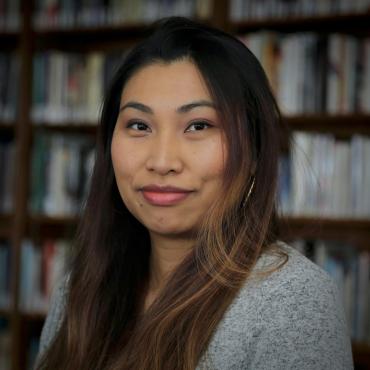

Saymoukda (she/her) is an award-winning Lao American poet and playwright born in a Thai refugee camp and raised in Rondo, Saint Paul, Minnesota. She is the author of the children’s book When Everything Was Everything, several plays, and currently serves as the Andrew W. Mellon Foundation’s Playwright in Residence with Theater Mu.
Fellowship Statement
It’s an honor to be awarded a Jerome Hill Fellowship for my work in theater. In my bones, I feel that I’m more than a playwright. I’m a creative legacy-architect. The Lao are not often part of public discourse. I believe that my plays are roadmaps for people to further engage with the histories, experiences, and stories from the Lao diaspora.
During the fellowship, I’ll be taking classes to hone the technical side of playwriting, read scripts, attend virtual performances, and be in conversation with my peers. I’ll also use my time to develop Motherland Orphans, a play about the generation of Southeast Asian Americans who were not born in their “motherland” but are tethered to her through stories, song, food, language, and refugee-love languages.
Thank you, Jerome Foundation. This former refugee’s heart is screaming with joy!
Photo by John Schlaider


Chamindika Wanduragala is a Sri Lankan American puppet artist/stop motion filmmaker with a visual arts background, and a DJ (DJ Chamun). She loves transporting people to another world where you believe inanimate objects are alive and you feel the sense of joy that comes from having your imagination expanded.
Wanduragala is the founder and Executive/Artistic Director of Monkeybear’s Harmolodic Workshop. She’s inspired by creating a platform for other Native, Black, IPOC artists to explore puppetry, where they get funds, mentorship and studio access to develop creative and technical skills in contemporary puppetry. Wanduragala’s work has been supported by the Henson Foundation, Jerome Foundation, MRAC and MN State Arts Board, and her last puppet theater production was presented by Pillsbury House Theatre. You can see her work (and hear some playlists!) at www.chamindika.com
Fellowship Statement
Puppetry’s surreal nature gives me a sense of freedom to explore without fear. It’s also pure magic/joy when audiences feel that the puppets are truly ALIVE! Bringing the objects to life is really important to me, so I’m grateful for the support of other Native, Black, IPOC puppeteers I’ve gotten to know through Monkeybear.
My first puppet piece was a few years ago, so I’m excited to focus on artistic development in the next few years, moving towards an interdisciplinary practice: embedding stop motion animation into live puppet performance, learning sound design for my work by diving into modular synths (I’m excited by its sense of play, which connects so well with puppetry), creating puppet films and honing my directing skills so I can take the performative aspect to the next level. I’m currently working on my second short film, which incorporates stop motion animation and puppetry (live action).
Photo by Sarah White
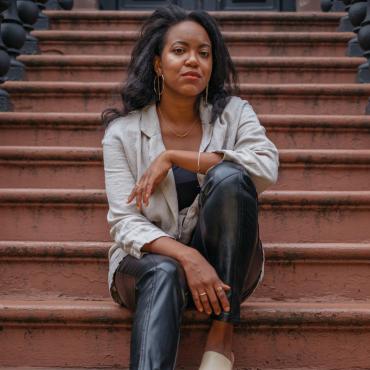

Whitney White is an Obie Award and Lily Award-winning director, writer, and musician originally from Chicago. She is a believer of alternative forms of performance, multi-disciplinary work, and collaborative processes. Her original musical Definition was part of the 2019 Sundance Theatre Lab, and her five-part musical exploration of Shakespeare’s Women, Reach for It, is currently under commission with the American Repertory Theater in Boston. Past fellowships include the New York Theatre Workshop’s 2050 Fellowship, Ars Nova’s Makers Lab, Colt Coeur Theater and the Drama League. White received an MFA in acting from Brown University/Trinity Rep, and a BA in Political Science and Certificate in Musical Theatre from Northwestern University. Her recent directing includes The Amen Corner (Shakespeare Theatre Company), Our Dear Dead Drug Lord (WP Theatre and Second Stage, NYT Critic’s Pick), Aleshea Harris’ What to Send Up When it Goes Down (The Movement Theatre Company, Woolly Mammoth Theatre Company, American Repertory Theatre, The Public Theater, NYT Critic’s Pick).
Fellowship Statement
As a creator, I am a believer of alternative forms of performance, multi-disciplinary work, and collaborative processes. I aspire to use performance across mediums to challenge understandings of blackness, femininity, and much more. I currently have two works in progress to which this funding, in addition to professional development and support, would go to: Macbeth In Stride and Definition. Both challenge musical theatre as a genre, and radically defy traditional structures. One is a look at the process of adaptation, while the other is completely original. Definition is being developed with The Bushwick Starr, and Macbeth In Stride is part of a five-part series with the American Repertory Theatre. Thank you again, and I look forward to the next two years.
Photo by Melissa Bunni Elian


Nathan Yungerberg is a Brooklyn-based Afrosurrealist and storyteller whose plays have been developed or featured by The Cherry Lane Theatre, JAG Productions, LAByrinth Theater, Lorraine Hansberry Theater, The National Black Theatre, The Fire This Time Festival, 48 Hours in Harlem, The Lark, Roundabout Theatre Company, The Playwrights’ Center, Crowded Fire Theater, and The Bushwick Starr. He is one of seven Black playwrights commissioned by The New Black Fest for HANDS UP: 7 Playwrights, 7 Testaments published by Concord Theatricals, and adapted by BBC radio. Nathan’s play Esai’s Table was featured in The Cherry Lane Theatre’s 2017 Mentor Project (Mentored by Stephen Adly Guirgis). Awards, honors, and residencies: 2021 National Black Theatre of Harlem I AM SOUL residency, Blue Ink Playwriting Award (Finalist), 2019 Djerassi Resident Artist, The 2016 O’Neill National Playwrights Conference (Semifinalist), Ken Davenport 10-Minute Play Festival (Winner). Nathan is also a writer for Sesame Street.
Fellowship Statement
My work is driven by my journey of creating a black identity. I was adopted at two weeks old and raised by white parents in Wisconsin. My innovation is rooted in investing less in what hasn’t been done before and more into what is not done enough. For generations, the negative portrayals of black bodies have demonized and desecrated a culture filled with light. I seek to share the radiance and the heart of the Black soul in a way that is aspirational and illuminating. I am currently working on a play called Sweetwater: The Gospel of Iman for a residency at the National Black Theatre in Harlem. Sweetwater follows a brotherhood of six Black gay men through the 1980s AIDS crisis in New York City who call themselves the New Apostles, and their god is a god called joy, or resilience, a god of tactics, a god called tomorrow.
Photo by Robert Feliciano
2019 Fellows
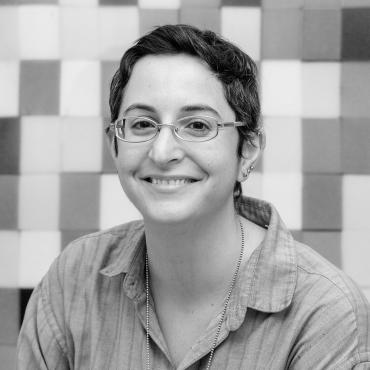

Manal Abu-Shaheen (she/her) is a Lebanese-American photographer, born in Beirut, and currently living and working in Queens, New York. Her recent solo exhibitions include Theater of Dreams, Bernstein Gallery, Princeton University, NJ; Beta World City, LORD LUDD, Philadelphia, and Familiar Stranger, A.I.R. Gallery, Brooklyn. Her work has been included in group exhibitions at Amelie A. Wallace Gallery, Old Westbury, New York; The Society of Korean Photography, Seoul, Korea; Queens Museum; The Center for Fine Art Photography, Fort Collins, CO; and The Bronx Museum of the Arts. She is a recipient of the Aaron Siskind Foundation Individual Photographer’s Fellowship Grant, Jerome Foundation Travel and Study Grant, Lower Manhattan Cultural Council Workspace Residency, A.I.R Gallery Fellowship, and Artist in the Marketplace Residency at the Bronx Museum. Abu-Shaheen holds a B.A from Sarah Lawrence College and MFA in Photography from Yale School of Art. She teaches at The City College of New York.
Fellowship Statement
My work focuses on the ways in which globalized communication brings idealized images from one culture in contact with the realities of another. Motivated by a lack of visual history of the landscape in Lebanon, I am building my own photographic archive of what Beirut looks like today: a city dominated by billboards. In one sense the advertisements serve as a visualized end energizing capitalist growth, and in another they purport a mythologized western ideal that is incongruous in the post-conflict city. The advertisements and pervasive neo-liberal capital represent our most recent form of colonialism. What is fascinating to me about this system is that it employs images as its most powerful tool. This under-documented place is now occupied by images of a different place and people.
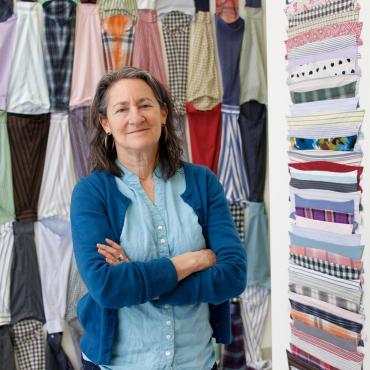

Rachel Breen (she/her) has exhibited her work across the Twin Cities and nationally. She has received several Minnesota State Arts Board grants, a fellowship from the Walker Art Center Open Field and an artist residency at the Virginia Center for Creative Arts. Rachel’s social engagement projects have twice been a part of Northern Spark, an all-night public art festival addressing climate change. Rachel is a professor of fine art at Anoka Ramsey Community College in Coon Rapids, Minnesota.
Rachel holds an MFA from the University of Minnesota and received her undergraduate degree from The Evergreen State College. She worked as a community organizer for social justice organizations and political campaigns across the country and is a co-founder of Jewish Community Action in Minnesota. These experiences influence the process and content of her art today. Rachel was born and raised in Minnesota. Her ancestors had roots in Poland, Lithuania and Belarus.
Fellowship Statement
At the core of my practice is a sewing machine, which I use to draw, create installations and perform. I describe my work as “public making” as it encourages reflection about social concerns. Through acts of sewing, I divert sewing’s original purpose, that of creating, toward social critique. I call attention to the stitch as a symbol of human interdependence, and I use it to express a belief in the possibility of social change and repair.
My recent work examines the implications of two garment workplace tragedies, the 1911 Triangle Shirtwaist Factory fire in New York City and the 2013 Rana Plaza Factory collapse in Bangladesh. I connect these tragedies to raise questions about the relationship between overconsumption and the abject working conditions of garment workers. With this fellowship, I plan to continue investigating these questions, focusing especially on matters of scale, materials, and public participation.
Photo by Justin Allen.
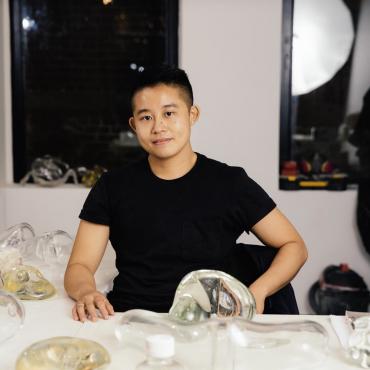

Jes Fan (they/them) is a Brooklyn-based artist born in Canada and raised in Hong Kong, China. They are the recipient of various fellowships and residencies, such as the Joan Mitchell Painters and Sculptors Grant Recipient, Recess Art Session Residency, Bemis Center Residency, Van Lier Fellowship at Museum of Arts and Design, Pioneer Works Residency, John A. Chironna Memorial Award at RISD. Fan has exhibited in the United States and internationally; selected exhibitions include Mother is a Woman at Empty Gallery (Hong Kong), Disposed to Add at Vox Populi Gallery (Philadelphia), Whereabouts at Glazenhuis Museum (Belgium), Material Location at Agnes Varis Gallery (New York), Ot(her) at Brown University’s Sarah Doyle Gallery (Providence). They received a BFA in Glass from Rhode Island School of Design.
Fellowship Statement
My studio practice is rooted in a haptic approach to understanding how identity is materialized, biologically and ontologically. I use substances such as hormones, silicone and soap—materials that are imbued with erotic and political signifiers to articulate my concerns about diasporic politics, transgender identities, and posthumanism.
Currently, I am working on new film, titled Xenophoria. Xenophoria, at first glance, simulates a YouTube cooking video, but the narrative quickly dives into the lab process of melanin production. Here, E. coli bacteria is used as a host, allegorical to ways in which miscegenation has been viewed as a dangerous contamination, and broader anxieties of racial intimacy. The mood of the video shifts and the camera turns to medical portraitures of the 19th century by Lam Qua. A set of paintings that depicts tumors of patients in the Canton region. These paintings ascribe to a colonial period when race and character is still not fully taxonomized, and medical science was sought out as a tool to dissect race as a distinct category. The film ends with a sudden jolt to an interview with a researcher who proposed to harness melanin's anti-radioactive properties for interspace travel in the near future.
My work magnifies the surreal realities of existing as a biological body in the age where the body is reconceptualized in digital, informational and molecular terms. It dwells in this productive anxiety and offers no resolution to identity politics that are riven by binaries.
Photo by Han Minu.


LaMont Hamilton (he/him) is an autodidact interdisciplinary artist living and working in New York. Hamilton uses lens, performance, writing and sound amongst a variety of other mediums to negotiate between the material and the conceptual. His practice as an artist is considered visual art, but he strives for synesthetic engagements that decentralizes the ableist assumption of the “visual” and considers how bodies engage with work.
Hamilton has been the recipient of several residencies, fellowships and awards including the Jerome@Camargo residency in Cassis, France, Skowhegan School of Painting and Sculpture, MacDowell Colony, MFAH CORE program in Menerbes France, Smithsonian Artist Research Fellowship, Artadia Award, ArtMatters Grant, Artist in Residence at Duke University’s African and African American Studies, Bemis Center for Contemporary Art amongst others. Hamilton has also showed at institutions such as MoMA, The Kitchen, ISSUE PROJECT ROOM, Studio Museum in Harlem, Schomburg Center, The Drawing Center and The Sculpture Center.
Fellowship Statement
I see myself in the tradition of those who view the role of “the artist” as a specific calling. One doesn’t simply choose to be an artist but is moved, deeply, into this space of wonder. We are all born with (various forms of) antennas which we use to perceive the world, but the artist is ignited to make sense of this perception. This (re)imagination is at the crux of the current direction of my practice. Whereas before my commitment was to the historical, in a pivot, I am now fully invested in art’s capacity for deep meditation, transformation. I am engaged in two working principles—Transrealistic poetics and Barulhos—first presented by poets Norman H Pritchard and Ferrier Gullar (respectively), to provide an open-ended structure for this investigation.
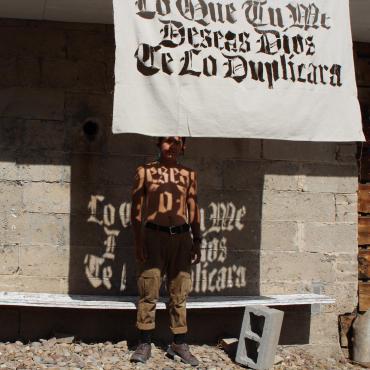

Jonathan Herrera Soto is a print-based studio artist originally from Chicago, IL, and currently maintains a studio practice in Minneapolis, MN. He graduated with a BFA from the Minneapolis College in Art and Design in 2017. Recent solo exhibitions of Jonathan’s work include Querida Presencia at the Duluth Art Institute in Duluth, MN, and Entre Rios y Montañas at Annex Gallery in Chicago, IL. He has participated in numerous artist residencies including Yaddo, Saratoga Springs, New York; The Studios at MASS MoCA, North Adams, MA; 33 Officia Creativia, Toffia, Italy; Spudnik Press Cooperative, Chicago, IL; High Point Center for Printmaking, Minneapolis, MN; Vermont Studio Center, Johnson, VT; and Epicenter, Green River, Utah. Herrera Soto was a 2018 recipient of the Santo Foundation Individual Artist Award and the Minnesota State Arts Board Artist Initiative Grant.
Fellowship Statement
I construct print-based objects, installations, and environments that echo lived experiences of those who are no longer with us. My print-based processes of producing tracings and impressions translate the content through the symbolically revealing the act of remembering. Slicing open wounds into wood, burning the surface of limestone with acid, and the crushing of ink on paper under immense pressure, re-animates acts of violence that carries through an art-object’s final presentation. I research, explore, and unpack ideas within a framework of praxis--the simultaneous conceptual framing and physical compressing of ideas through work in order to examine the spaces left behind by others. I am currently working on a series about love’s influence on ethnic bodies in constant movement—the love that guides mothers that flee their homes with their children in search for asylum, the rebels that fight against oppressive regimes, and friends that search for their missing comrades.
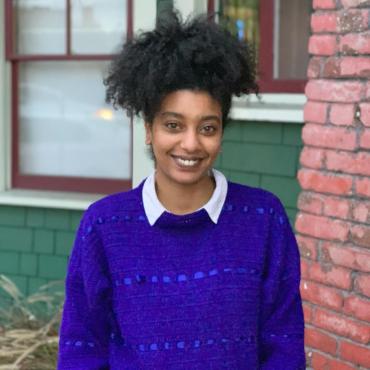

Hasabie Kidanu (she/her) received her MFA at the Yale School of Art in 2017. Her film Mal-Fekata was most recently screened at the 48th Rotterdam International Film Festival as part of the Bright Future program. She has been a member of the Blackburn Printmaking Studio in New York since 2013. She was most recently a guest lecturer at Addis Ababa University. Since 2014, she is an Arts and Culture writer for TADIAS Magazine.
Fellowship Statement
I work with printmaking, film, and text. I was raised in Addis Ababa, Ethiopia and often reference the city as a site of my research. I engage specific works of literature to ground and challenge my understanding of history and modernity. Currently, I am producing a film alongside a reading of Ivan Vladislavic’s The Folly. Through the back and forth of reading and production, interpretation and application, I hope to produce a site/work that is of, and apart from, my understandings of early cinema and African literature.
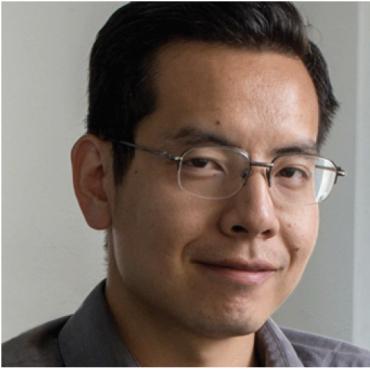

Sieng Lee is a first-generation Hmong American refugee. Lee graduated from the Minneapolis College of Art and Design with a Master’s in Fine Arts. He is an artist, graphic designer, and community organizer. His recent achievements include being a recipient of the MAEP at the Minneapolis Institute of Arts; a Cultural Community Partnership Grant from the Minnesota States Arts Board; designing and developing the We Are Hmong/Peb Yog Hmoob Minnesota exhibit at the Minnesota History Center, which won an AASLH award; and directing multiple political campaigns to elect Fue Lee, Samantha Vang, and Jay Xiong to the Minnesota House of Representatives to form the first ever Minnesota Asian Pacific Caucus. His passion lies at the intersections of our multicultural society, helping to bridge the many inequities and misunderstandings.
Fellowship Statement
My work treads a delicate line that weaves in and out of the two realms that have shaped the Hmong identity since before time: the living and the spiritual. In so doing, I introduce general audiences to the celestial mythology that shapes modern Hmong Americanism, while activating the Hmong community’s exclusive access to view, recognize, and react to their own stories on display. By using physical objects that have a spiritual, and at times controversial, significance, my work questions the performance of tradition as it has been adopted and reinterpreted from generation to generation.
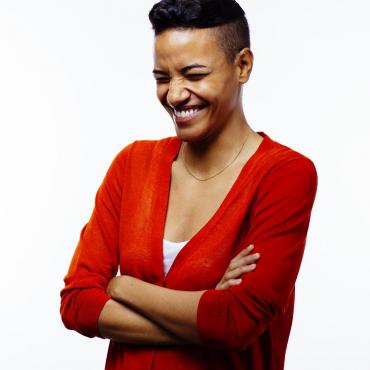

Born in Puerto Rico and raised in the Bronx, Glendalys Medina is an interdisciplinary artist who received her MFA from Hunter College. Medina’s work has been presented at such notable venues as PAMM, Artists Space, The Bronx Museum of Art, El Museo del Barrio, The Museum of Contemporary Art in Vigo, Spain, and The Studio Museum in Harlem. Medina is a recipient of a Bemis Center Residency (2019), an Ace Hotel New York City Artist Residency (2017), a SIP fellowship at EFA Robert Blackburn Printmaking Workshop (2016), a BACK IN FIVE MINUTES artist residency at El Museo Del Barrio (2015), a residency at Yaddo (2014, 2018), the Rome Prize in Visual Arts (2013), a New York Foundation for the Arts Fellowship in Interdisciplinary Art (2012), and the Bronx Museum Artist in the Marketplace residency (2010).
Fellowship Statement
At age 7, I decided I wanted to be an artist–not really knowing that it was much more than making beautiful things. Today, I am an artist to give a voice to those who have been silenced and create cultural equity.
I am interested in patterns, how they are formed and give meaning. Humans are amazing pattern-recognition machines with the ability to detect their disruptions or “recursive probabilistic fractals” according to inventor and futurist, Ray Kurzweil. I investigate existing patterns in order to understand how to form new patterns of behavior, thought, structure and meaning. Patterns dictate our understanding of life and who we are, and to change these meanings, we must disrupt them and make new concrete goal-oriented patterns in order to create social change.
The style of my work is heavily influenced by systematic structures, the cadence of Hip-Hop rappers, the affirmations and visualization exercises of New Thought ministers and authors, the signatures of graffiti writers, the moves of break-dancers, and traditional Taíno motifs.
The questions I grapple with in my work are how can I create new resonant forms, architecture, actions, and movement to invoke in my viewer emotions of love and curiosity for a broader perspective of the world.
Photo by Carlos David.
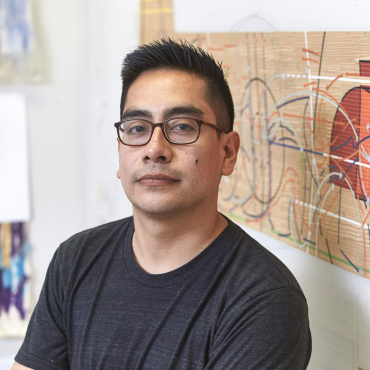

Ronny Quevedo (he/him) was born in Guayaquil, Ecuador and now lives in the Bronx. He works in a variety of mediums including sculpture and drawing. Quevedo has had several solo exhibitions including no hay medio tiempo / there is no halftime, Queens Museum (2017); Home Field Advantage, Casita Maria Center for Arts & Education, Bronx, New York (2015); and Ulama, Ule, Olé, Carol Jazzar Gallery, Miami (2013). In 2018, Quevedo was included in the Whitney Museum of American Art’s group exhibition, Pacha, Llaqta, Wasichay: Indigenous Space, Modern Architecture, New Art. Quevedo received his MFA from the Yale School of Art in 2013 and BFA from The Cooper Union in 2003. He is currently artist in residence at Smack Mellon.
Fellowship Statement
The effect of relocation and displacement generates works about adaptation, memory and transformation. The movement and action within sports is a metaphor for an insistence on survival and constant adaptation. This use of play is a subversive transformation to the rules and capabilities placed upon people when the conditions of a society become oppressive. By incorporating these games, I invoke an architectural and narrative space—where boundaries are malleable, limits are negotiable and competition is a generative force for evolving identities.
The parallels between play and migration generate from indoor soccer leagues in New York City. Played on weekends at local public schools, these leagues are coordinated and operated by migrant Latin American and Caribbean communities. The questioning of inheritance and memory are conceptual markers in my practice. The act of passing—passing down, passing on, passing the ball—offers generative contemplations of my points of origin.
My focus for the fellowship is the dialectic of nomadism and cultural production as complemented by Edouard Glissant’s Poetics of Relation. He emphasizes the influence of the periphery onto central forms of culture. He claims that the margins offer a new understanding of the center. It can be more creative in determining meaning than a static position based on an essential form. I relate to this concept of being having been born in Ecuador, raised in The Bronx (a pre-dominantly Caribbean and Black community at that time) and determining my own identity as a migrant in relation to those who have similar experiences of displacement.
Photo by Argenis Apolinario.
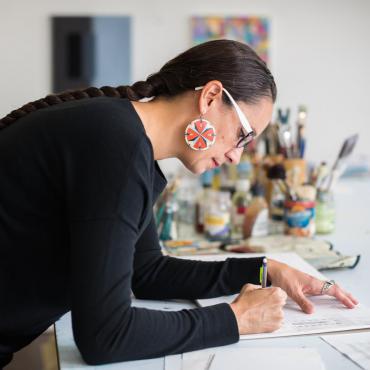

Dyani White Hawk (Sičáŋǧu Lakota) (she/her) is a visual artist and independent curator based in Minneapolis. White Hawk earned an MFA from the University of Wisconsin-Madison (2011) and BFA from the Institute of American Indian Arts in Santa Fe, New Mexico (2008). Recent support of White Hawk’s work includes 2019 United States Artists Fellowship in Visual Art, 2019 Eiteljorg Fellowship for Contemporary Art, 2019 Forecast for Public Art Mid-Career Development Grant, 2018 Nancy Graves Grant for Visual Artists, and a 2017 Native Arts and Cultures Foundation Fellowship. Her work is represented by Bockley Gallery in Minneapolis.
Fellowship Statement
As a woman of Sičangu Lakota and European American ancestry, I was raised within Native and urban American communities. My work reflects these cross-cultural experiences through the combination of modern abstract painting and abstract Lakota art forms. Some works are executed strictly in paint while others incorporate beads and porcupine quillwork onto a painted surface, weaving aesthetics and conceptual influences from each respective history.
I strive to create honest, inclusive compositions that acknowledge all parts of my history, Native and non-Native, urban, academic and cultural education systems. This platform allows me to start from center, deepening my own understanding of the intricacies of self and culture, correlations between personal and national history, and indigenous and mainstream art histories.
The work encourages conversations that challenge the lack of representation of Native arts, people and voices in our national consciousness while highlighting the truth and necessity of equality and intersectionality.
2021 Fellows
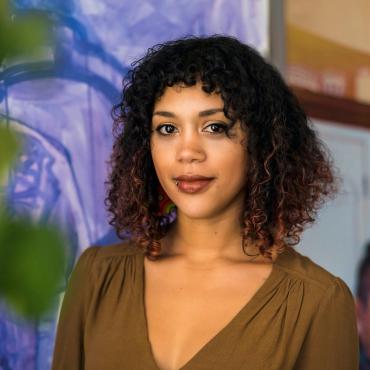

Leslie Barlow (she/her) is an artist and educator working in Minneapolis, MN. Barlow uses figurative oil painting to share stories that explore the politics of representation, identity, otherness, and race. Barlow earned an MFA from the Minneapolis College of Art and Design (2016) and BFA from the University of Wisconsin- Stout (2007). Recent support of Barlow’s work includes: 2019 20/20 Springboard Fellowship, 2019 McKnight Visual Artist Fellowship, and several Minnesota State Arts Board grants. She currently teaches at the University of Minnesota, helps run the organization MidWest Mixed, is a member of the mural collective Creatives After Curfew, and she also supports emerging artists as the Director of Studio 400.
Fellowship Statement
I am interested in examining and reimagining our relationship to our racial identities through healing our collective understanding of belonging and what it means to be family. My life-size oil paintings serve as both monuments to community members and explorations into how race entangles the intimate sphere of love, family, and friendship. Working within the tradition of figurative painting provides a platform and space to challenge the norms and hierarchy of who is painted, what stories are amplified, and by whom. The work is created from places of vulnerability, nuance, community conversation, and personal experience. What results from my work is not the desire to simply have dialogue, but to manifest the power of images. My current body of work-in-progress is 3 years in the making. Titled Within, Between, and Beyond, it combines painting and video documentary and will be exhibited in 2021 at the Minneapolis Institute of Arts.
Photo by Ryan Stopera
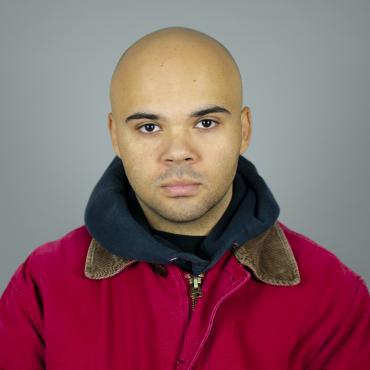

Joseph Buckley (he/him) is a Black British Sculptor living and working in New York City. Recent solo shows include Letter from the Home Office at Lock Up International in London; Cousin Table at Cuchifritos, NYC; Traitor Muscle at Art in General, NYC; and Brotherhood Tapestry at The Tetley in Leeds, England. Recent group projects include I don't Know Whether The Earth is Spinning or Not... at the Museum of Modern Art, Moscow (for the VII Moscow International Biennale for Young Art); and Cellular World: Cyborg-Human-Avatar-Horror, at the Gallery of Modern Art, Glasgow (for Glasgow International Festival of Visual Art 2018).
Fellowship Statement
I have found myself preoccupied with the mechanics of objectification and dehumanization, and with a continuum I perceive that goes ‘corpse—slave—human—statue—sculpture’ and back again.
I am interested in the way that systems of abuse replicate themselves, at different scales, across our society. On the topic of replication, I am heavily invested in mold-making and plastic casting: I am interested in the connotations of industrial production, and the violence such industry implies.
Of late, I have been trying to work towards the topics of fascism and its contemporary manifestations. Some of my sculptures are of fascists and are ‘about’ fascism but, gendered as they are, they have also served as a way to focus my thinking surrounding the eternal font from which fascism metastasizes: a swollen, toxified, and entitled masculinity... a boil on my soul’s ass I must continuously lance and drain.
Photo by Jenny Hung
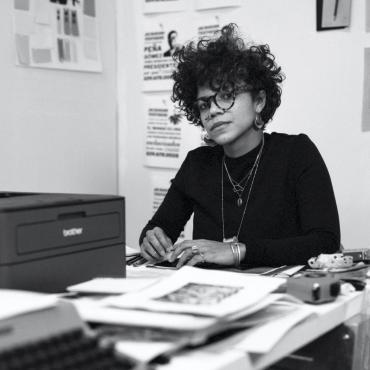

Lizania Cruz is a Dominican participatory artist, designer, and curator interested in how migration affects ways of being and belonging. Through research, oral history, and audience participation, she creates projects that highlight a pluralistic narrative on migration. Cruz has had her work supported through Create Change fellow at the Laundromat Project (2018-2019), Agora Collective Berlin (2018), Design Trust for Public Space (2018), Recess Session (2019), IdeasCity:New Museum (2019), Stoneleaf Retreat (2019), Robert Blackburn Workshop Studio Immersion Project (SIP) (2019), A.I.R. Gallery (2020-2021), BRIClab: Contemporary Art (2020-2021), and Center for Books Arts (2020-2021).
Fellowship Statement
For the past two years, I’ve been conceptualizing a piece titled Citizen Clock that looks at the path to citizenship, as well as, work around the legal process of migration. The Jerome Foundation fellowship will provide the support to develop this work and to collaborate with fabricators to bring this idea to life. It will also provide a space to expand my participatory practice into more conceptual objects that archive these processes. I’m excited to be part of this community and learn from all the different fellows.
Photo by Manolo Salas
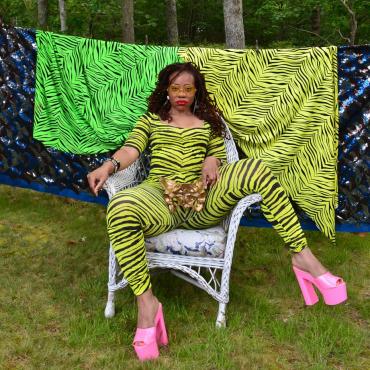

Ayana Evans is a New York City-based visual performance artist. All of her video, lithography, screen-printing, watercolor mono-prints, installations, and projection extends from her performance work. She received her MFA in painting from Temple University and her BA in Visual Arts from Brown University. Evans has performed at El Museo del Barrio, The Barnes Foundation, The Bronx Museum, Newark Museum, Crystal Bridges Museum, The August Wilson African American Cultural Center, the Queens Museum and countless public locations for her guerilla-style performances. Her international work includes shows at FIAP performance festival in Martinique, Tiwani Contemporary in London, and Ghana’a Chale Wote festival. Evans was a 2018 Fellow at EFA’s Robert Blackburn Printmaking Workshop, 2017-2018 awardee of the Franklin Furnace Fund for performance art, 2018 NYFA Fellow, and 2019 Savage Lewis Fellow with Art on the Vine. Her recent press includes The New York Times, Bomb Magazine, ArtNet, New York Magazine’s The Cut, Hyperallergic, and CNN. Evans is currently an adjunct professor at Brown University.
Fellowship Statement
I am a NYC-based performance artist, who grew up on the South Side of Chicago. The sensibilities of both locations heavily influence my work with the body, race relations, and gender bias. My on-going performances/public interventions include: Operation Catsuit, I Just Came Here to Find a Husband, and a new series of collaborative works with artists of diverse backgrounds. These performances map how my body is perceived and treated as it operates in artistic and social spheres. Roberta Fallon, co-founder of Artblog, describes me as, “One part Wonder Woman, one part agent provocateur.” And writer Seph Rodney of Hyperallergic and The New York Times wrote: “I have seen [this] artist actually stop traffic on the Bowery in downtown Manhattan in 2016, where, in a floor-length lace gown, a dollar-store tiara and full makeup, she placed a chair in the street to do chair dips — risking her life. She survived. The halted drivers honked in confusion, consternation or encouragement.” During this residency I will continue the Operation Catsuit series via experimental film and costuming.
Photo by Makonnen


Miatta Kawinzi is a multi-disciplinary artist and educator of Liberian and Kenyan heritage. Raised in the southern U.S.A. and based in New York City, her work engages themes of hybridity, diaspora, and belonging. She received an MFA in Studio Art from Hunter College and a BA in Interdisciplinary Art & Cultural Theory from Hampshire College. Her work has been presented in spaces including the Studio Museum in Harlem, BRIC, MoMA PopRally, the Museum of the Moving Image, and IFC Center. Past residencies include POV Spark in partnership with the Smithsonian's National Museum of African American History & Culture (NYC, DC, and Venice, Italy), Red Bull Arts Detroit (Detroit, MI), the Cité internationale des arts (Paris, France, with Lower Manhattan Cultural Council), Beta-Local (San Juan, Puerto Rico), the Bag Factory (Johannesburg, South Africa), and the Bemis Center (Omaha, NE). She received the 2018 Barbara Hammer Lesbian Experimental Filmmaking Grant administered by Queer|Art.
Fellowship Statement
Born in Nashville, TN to a Liberian mother and Kenyan father, I grew up moving through various geographic, cultural, and linguistic spaces, which informs my interest in hybridity and layered imagery and content. I work with still and moving images, the voice and body, language, objects, space and sound to explore practices of re-imagining the self, identity, and culture through abstraction and poetics. Recent work traces a performative and experimental impulse through sculptural sound and video installation.
During the Fellowship, I will expand my ongoing research and creative production though historical, contemporary, and speculative relationships between the U.S. and Liberia - the West African republic founded in the 1800s with formerly enslaved Black people returning to the continent from the Americas and newly occupying positions of power. This project explores questions around hierarchy, Indigeneity, multiplicities and complexities of Blackness, cultural fragmentation, and the deep and steady yearning for the reparative.
Photo courtesy the artist
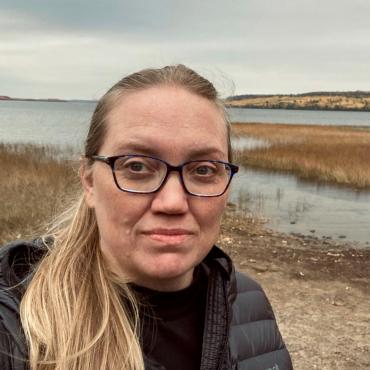

Catherine Meier creates drawings, animations, and large-scale installations of earth, sky, and horizon – of vast, open landscapes. Large in scope, her projects develop through time spent deep listening and giving attention to specific locations. She holds a BFA from the University of Nebraska, Lincoln, and an MFA from the University of Michigan Ann Arbor. Her work has been shown in museums, galleries, and film festivals as well as in the very land that gives rise to her work. Meier’s project Standing Witness, site: Sage Creek, a hand-drawn animation that records the temporality and vastness of the land, was a featured project in Creative Capitals’ online web forum On our Radar. She has held place-oriented residencies at Badlands National Park and Cedar Point Biological Station. Meier received a McKnight Visual Artist Fellowship, Minnesota State Arts Board and Arrowhead Regional Arts Council grants, and the Jacob K. Javits Fellowship for graduate study. Meier lives with her family near the North Shore of Lake Superior.
Fellowship Statement
I work to describe in visual artistic form the human encounter with vast, open landscape. My drawings, animations, and installations speak to the intricate, beautiful, and unseen understandings of land and place.
A settler descendent, I grew up in a small town at the eastern edge of the Nebraska Sandhills, and for seven years I worked as a truck driver hauling cattle throughout the Great Plains. While my personal and family history is tied to the Plains, my work is not based in nostalgia—it originates from a deep physical, mental, and emotional need to move in and through open land. My interest extends beyond visceral, personal need into a deep and abiding engagement with the history, culture, and environmental concerns of these large but delicate grasslands. I am deeply rooted in rural working class experience, and I find inspiration and guidance from contemporary Indigenous scholars, artists, and activists, the study of place and language, and environmental activism.
My work has become the story of time told through the language of place.
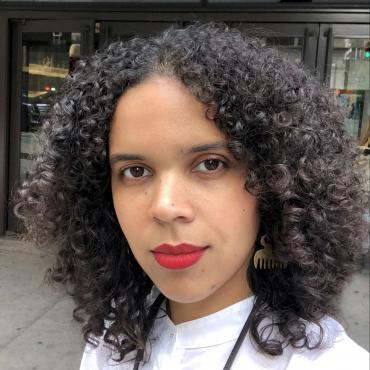

Joiri Minaya (1990) is a Dominican-United Statesian multi-disciplinary artist based in New York City, who focuses on destabilizing historic and contemporary representations of an imagined tropical identity. Minaya attended the Escuela Nacional de Artes Visuales in Santo Domingo (2009), Altos de Chavón School of Design (2011) and Parsons the New School for Design (2013). She has participated in residencies at Skowhegan School of Painting and Sculpture, Guttenberg Arts, Smack Mellon, the Bronx Museum’s AIM Program and the NYFA Mentoring Program for Immigrant Artists, Red Bull House of Art, the Lower East Side Printshop and Art Omi. She has received awards, fellowships and grants from Artadia, the BRIC’s Colene Brown Art Prize, Socrates Sculpture Park, the Joan Mitchell Foundation, the Rema Hort Mann Foundation, the Nancy Graves Foundation, amongst other organizations. Minaya’s work is in the collection of the Museo de Arte Moderno and the Centro León Jiménes in the Dominican Republic.
Fellowship Statement
My work is a reassertion of Self, an exercise of unlearning, decolonizing and exorcizing imposed histories, cultures and ideas.
It’s about reconciling the experience of having grown up in the Dominican Republic with living and navigating the U.S.A. and the global North, using gaps, disconnections and misinterpretations as fertile ground for creativity. I’ve learned there is a gaze thrust upon me which “others” me. I turn it upon itself, mainly by seeming to fulfill its expectations, but instead sabotaging them, thus regaining power and agency.
Through various visual disciplines, my work questions historic and contemporary representations of black and brown womanhood in relation to an imagined tropical nature, questioning ideas projected onto these identities and spaces from a feminist and decolonial position. I’m interested in the body, landscape, discourse, framing, (in)visibility, opacity, hybridity.
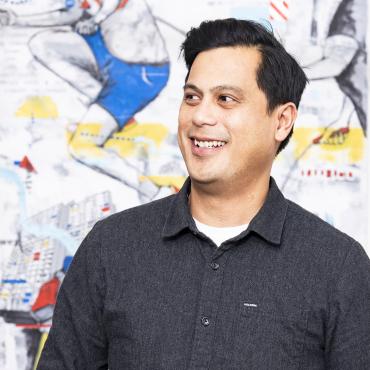

Witt Siasoco (he/him) is a community-based visual artist living and working in Minneapolis, MN. His work actively engages the intersection of the arts and civic process through a variety of roles—as artist, graphic designer, and arts educator.
In recent years Siasoco was awarded a Minnesota State Arts Board Arts Access grant and the Metropolitan Regional Arts Council’s Next Step Fund. He has had residencies at the Kulture Club Collaborative, Pillsbury House and Theater, and Minnesota Museum of American Art. Siasoco was selected as a CreativeCitymaking artist, a collaboration between artists and urban planners to develop innovative approaches for addressing the long-term transportation, land use, economic, environmental, and social issues facing Minneapolis.
Fellowship Statement
My studio practice is rooted in creating art in public space that catalyzes civic dialogue and collective action. Throughout my career, I have created many community-engaged projects including This Home is Not for Sale, a collaboration with Poetry for People and recipient of an Americans for the Arts' Public Art Award; Drawing on Rice Street, a large-scale painting installation distilling over 200 conversations with Frogtown residents; and Carry On Homes Northeast, an installation focused on immigrant participation in the Census 2020. With my experience as a public artist and lifelong skater I brought together Juxtaposition Arts and City of Skate to create JXTA's Skateable Art Plaza, a youth designed, multi-purpose public space in North Minneapolis. Recently, I finished a large-scale mural for the Creative Enterprise Zone and created a new work for the City of Minneapolis’ Public Service Center.
Photo by Dan Huseby
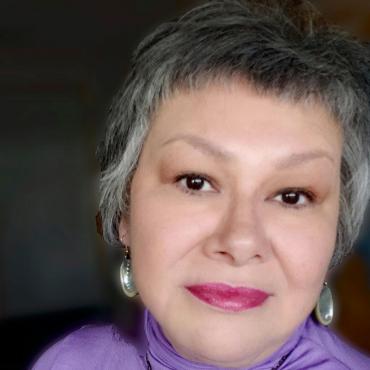

Delina White is a Native apparel designer, beadwork artist and Indigenous materials jewelry maker. She is a member of the Pillager Band of Minnesota Chippewa and resides on the Leech Lake Reservation in northern Minnesota. She mixes traditionally indigenous materials with her original designed fabrics, including fabrics from around the world found among the woodland peoples through centuries of trade. She uses her art to communicate the values and beliefs of the Anishinaabeg, as an intergenerational cultural knowledge learner from her grandmother. Delina was recognized as one of Six MN Star Tribune’s 2019 Artists of the Year, for her work with the Hearts of Our People, a landmark exhibition as the first major thematic show to explore the artistic achievements of Native women. Her Woodland Scarf placed 2nd in USA Today’s “10 Splurge-worthy Gifts of 2020,” and was named, “2020 Artist in Business Leadership Fellow” by the First Peoples Fund.
Fellowship Statement
Artists provide inspiration to make change, protect, and thrive in a better world. I use fashion as a narrative to assert rights for equity, protect our sacred sites and environment, and to show cultural pride as sovereign nations. We all use fashion to make a declaration of opinion, attitudes and outlook on life. My goal is to continue advocating the importance of arts programming throughout Minnesota and beyond, to tap into the talents and grow business skills of Native artists and work with families engaging the youth in creative placemaking for better, healthier communities. It is my responsibility to preserve the ancestral knowledge and share to advance what artists envisions for themselves and our communities. This fellowship will provide support that will allow me to study apparel as a catalyst to wider approaches of learning, research and creative exploration to truly become an asset of my community and nation.
Photo by Ivy Vainio
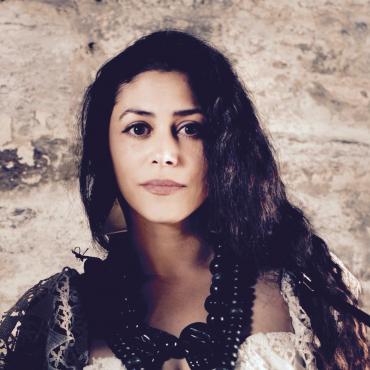

Rebekah Crisanta de Ybarra a.k.a. Lady Xøk (Maya-Lenca tribal citizen) is a Twin Cities-based multi/interdisciplinary artist, musician, and culture bearer whose work is rooted in Indigenous Futurisms. Performing as Lady Xøk, she creates multimedia light and shadow installations for immersive experimental storytelling mixing electric and Mesoamerican instruments. She co-founded Electric Machete Studios, a Latinx Art + Music cultural production house. Past works include Dimensions of Indigenous in 2016 at Intermedia Arts; Petroglyphs and Borders as part of the inaugural 2018 artist-in-residence at The M–Minnesota Museum of American Art; Star Girl Clan in 2018 at In the Heart of the Beast PuppetLab Fellow; Decolonial Maya Constellation Maps in 2019 at Minnesota Center for Book Arts as part of the Jerome Mentorship Fellow; and ongoing installation performances developed in part by Redeye Theatre, New Native Theatre, Monkeybear’s Harmolodic Workshop, Catalyst Arts, ArtShanty and current residency with New York-based theatre La MaMa. www.rebekahcrisanta.com
Fellowship Statement
My experimental interdisciplinary social practice (visual art, music, theatre, dance, literature, and puppetry) seeks to shift consciousness around immigration, borders, exodus and interconnectedness of Indigenous Peoples of the Americas and shared and erased ancient histories of collective liberation. Rooted in Indigenous Futurisms, Lenca cosmovision of Managuara, Latinx artesenias of Mesoamerica, and liberation theology of El Salvador, I am interested in the intersection of Low Art, High Art and the Nepantla in-between spaces where God, ancestors, timelessness, and dreams live. I explore the threads of connection between the seen and unseen worlds. I work from a generative space of meditation, ancestor whispers, play, and somatic response. I use transdisciplinary methods to reconstruct into living form Lenca archeology, to document and reimagine my people’s unwritten ancient history for a new future where Central Americans in exodus, First Americans, have a basic human right to migration on Turtle Island, a land travelled for millennia.
Photo by Valerie Oliviero
